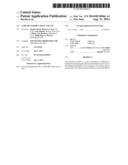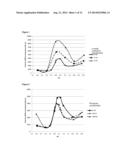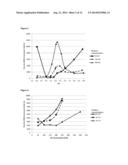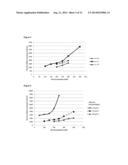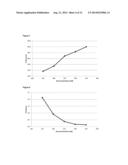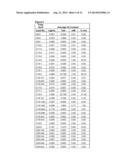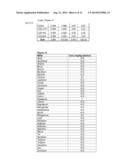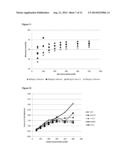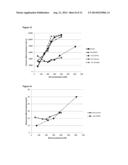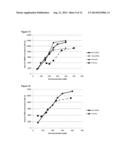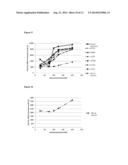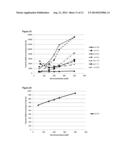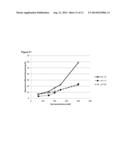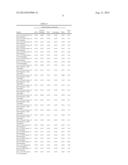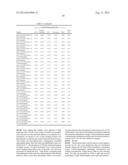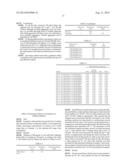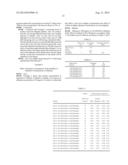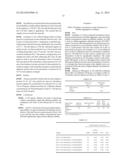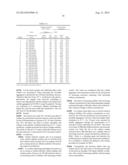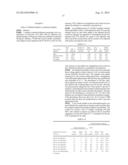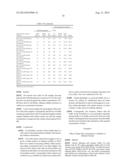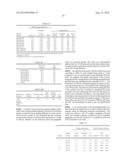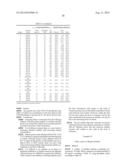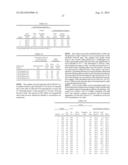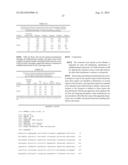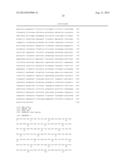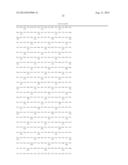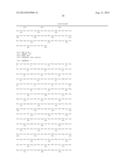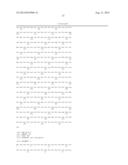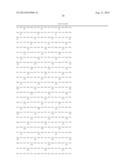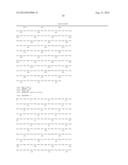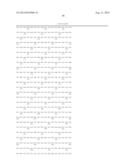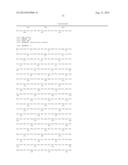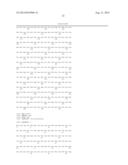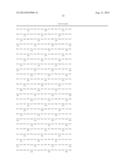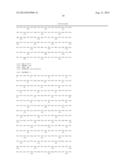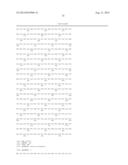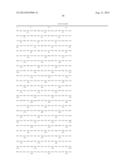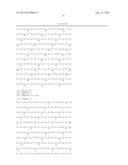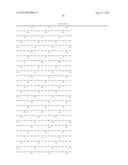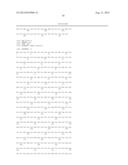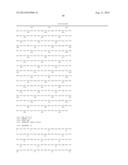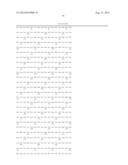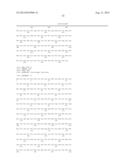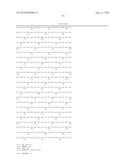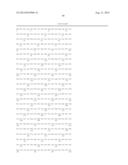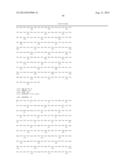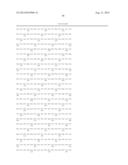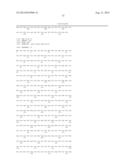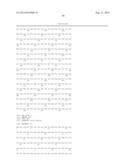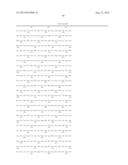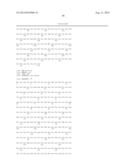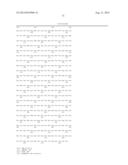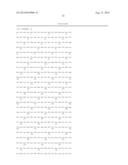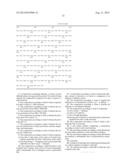Patent application title: ALBUMIN FORMULATION AND USE
Inventors:
Sandra Marie Merkel (Raleigh, NC, US)
Luke Dimasi (Boston, MA, US)
Collette Ann Sheahan (Birkenhead, AU)
Philip Harvey Morton (Nottingham, GB)
Assignees:
Novozymes Biopharma DK A/S
IPC8 Class: AC12N50735FI
USPC Class:
435407
Class name: Animal cell, per se (e.g., cell lines, etc.); composition thereof; process of propagating, maintaining or preserving an animal cell or composition thereof; process of isolating or separating an animal cell or composition thereof; process of preparing a composition containing an animal cell; culture media therefore culture medium, per se contains an albumin
Publication date: 2014-08-21
Patent application number: 20140234966
Abstract:
The invention relates to a new formulation of albumin, a method for
producing the albumin formulation and to uses of the albumin formulation,
for example in cell culture such as mammalian cell culture and
particularly in stem cell culture.Claims:
1. A composition comprising albumin, a solvent, at least 200 mM cations,
having a pH from about 5.0 to about 8.0 and wherein the composition
comprises less than or equal to 5 mM octanoate.
2. The composition according to claim 1 which comprises less than or equal to 1 mM octanoate.
3. The composition according to claim 1 wherein the cations are present at from 200 to 1000 mM.
4. The composition according to claim 3 wherein the cations are present at from 200 to 350 mM
5. The composition according to claim 1 wherein the pH is from about 6.0 to about 7.0.
6. The composition according to claim 1 wherein the pH is about pH 6.5.
7. The composition according to claim 1 wherein the cations are selected from: sodium, potassium, calcium, magnesium, and ammonium.
8. The composition according to claim 1 wherein the cations are sodium ions.
9. The composition according to claim 1 which comprises: (a) less than 5 mM amino acids (such as N-acetyl tryptophan), preferably less than 1 mM amino acids; and/or (b) less than 20 mgL-1 detergent (such as polysorbate 80), preferably less than 5 mgL-1 detergent.
10. The composition according to claim 8 which is substantially free of amino acids (such as N-acetyl tryptophan) and/or substantially free of detergent (such as polysorbate 80).
11. A composition according to claim 1 wherein the albumin, variant or derivative is a fusion or conjugation of an albumin or albumin variant.
12. The composition according to claim 1 wherein the albumin is at a concentration of from 1 gL-1 to 400 gL.sup.-1.
13. The composition according to claim 1 wherein the albumin is a recombinant albumin.
14. The composition according to claim 1 comprising: (a) 50 to 250 gL-1 albumin; (b) 225 to 275 mM Na.sup.+; (c) 20 to 30 mM phosphate; and having a pH of about 6.5, and wherein the composition comprises less than 2 mM octanoate.
15. The composition according to claim 1 which is substantially free of octanoate.
16. A cell culture medium comprising a composition according to claim 1 and a basal medium.
17. The cell culture medium according to claim 16 wherein the cell culture medium is a stem cell culture medium.
18. The cell culture medium according to claim 16 wherein the medium is substantially free of animal-derived components.
19. (canceled)
20. A method of culturing cells comprising incubating cells in a culture medium according to claim 16.
21. The method according to claim 20 in which the cells comprise stem cells.
Description:
REFERENCE TO A SEQUENCE LISTING
[0001] This application contains a Sequence Listing in computer readable form, which is incorporated herein by reference.
BACKGROUND OF THE INVENTION
[0002] The invention relates to a new formulation of albumin and to uses of the albumin formulation.
[0003] Albumin is the most abundant protein in plasma. Albumin has been described and characterized from a large number of mammals and birds. Albumin is believed to have a role in maintaining correct osmotic pressure and it also has a role in transport of various compounds in the blood stream. Albumin is a protein which is used to treat patients with severe burns, shock or blood loss. It is also used as an excipient for pharmacologically active compounds, many of which need to be stabilized for example to reduce the formation of soluble aggregates and/or insoluble aggregates of albumin. Furthermore, albumin is used to supplement media used for growing higher eukaryotic cells, including stem cells. Albumin fusion proteins are a fusion of a protein to albumin, or to a variant or fragment thereof, and may increase or decrease the half-life of the protein, for example increased in vivo half-life. Conjugation partners, e.g. proteins or chemicals, can be conjugated to albumin to increase or decrease the half-life of the conjugation partner, for example increased in vivo half-life. At present albumin is obtained from blood products, such as serum, or produced recombinantly in microorganisms such as yeast (e.g. WO 96/37515, WO 2000/044772) or from transgenic plants or animals. Typically, albumin is purified from the production source in order to provide a product which is sufficiently pure to meet the user's needs and/or to achieve a high yield of product. In some technical areas, such as cell culture or pharmaceuticals, there is a desire for products to be substantially free or completely free of animal derived components.
[0004] Purified albumin in a final liquid form is relatively unstable (compared to albumin in solid form) and so in order to maximize its shelf life it is either lyophilized and/or stabilizers added to the final liquid formulation. However, lyophilization can add significantly to the overall cost of the preparation and can be inconvenient to the end user who would need to resuspend the lyophilized product if they need a liquid product. For the preferred liquid product, stabilizers that are commonly added to albumin are n-acetyl-tryptophan, octanoic acid (octanoate, caprylate) and/or polysorbate 80 (e.g. Tween®). The albumin of WO 2000/044772 is stabilized by octanoic acid. Arakawa & Kita (2000) discloses stabilizing effects of caprylate and acetyltryptophanate on heat-induced aggregation of bovine serum albumin (Biochimica et Biophysica Acta 1479: 32-36). Hosseini et al. (2002) discloses a study of the heat-treated human albumin stabilization by caprylate and acetyltryptophanate (Iranian Biomedical Journal 6(4): 135-140).
[0005] The present inventors have identified that octanoic acid, can be deleterious to mammalian cell culture particularly to stem cell culture. Furthermore, polysorbate 80 (Tween®) can be deleterious to mammalian cell culture. What is required is a stable liquid formulation of albumin which is not deleterious to mammalian cell culture.
SUMMARY OF THE INVENTION
[0006] The invention provides a liquid formulation of albumin with improved stability, where stability is shown, for example, as a reduced level of soluble aggregates of albumin or insoluble aggregates of albumin in the formulation. The invention also provides methods using the formulation and uses of the formulation, such as mammalian culture and particularly stem cell culture.
BRIEF DESCRIPTION OF THE FIGURES
[0007] FIG. 1 shows the effect of pH and n-acetyl tryptophan concentration on the stability of albumin compositions (10 mg/mL), as determined by the time taken (seconds) for the absorbance (A350) to increase by 0.1 Absorbance Units (AU), a measure of visible (insoluble) aggregates.
[0008] FIG. 2 shows the effect of pH and phosphate concentration on the stability of albumin compositions (10 mg/mL), as determined by the time taken (seconds) for the absorbance (A350) to increase by 0.1 AU.
[0009] FIG. 3 shows the effect of pH and sodium concentration on the stability of albumin compositions (10 mg/mL), as determined by the time taken (seconds) for the absorbance (A350) to increase by 0.1 AU.
[0010] FIG. 4 shows the effect of pH and sodium concentration (for a wide range of sodium concentrations) on the stability of albumin compositions (10 mg/mL), as determined by the time taken (seconds) for the absorbance (A350) to increase by 0.1 AU.
[0011] FIG. 5 shows the effect of pH and sodium concentration on the stability of albumin compositions (50 mg/mL), as determined by the time taken (seconds) for the absorbance (A350) to increase by 0.1 AU.
[0012] FIG. 6 shows the effect of sodium concentration and albumin concentration on the stability of albumin compositions at pH 6.5, as determined by the time taken (seconds) for the absorbance (A350) to increase by 0.1 AU.
[0013] FIG. 7 shows the relationship between sodium concentration and relative monomer content (%) for albumin compositions incubated at 40° C. for 14 days.
[0014] FIG. 8 shows the relationship between sodium concentration and relative polymer content (%) for albumin compositions incubated at 40° C. for 14 days.
[0015] FIG. 9 shows a fatty acid profile of an albumin formulation according to the invention.
[0016] FIG. 10 shows a metal ion profile, by ICP-OES, of an albumin formulation according to the invention.
[0017] FIG. 11 shows the effect of sodium concentration and albumin concentration on albumin stability as determined by the remaining monomer content following incubation at 40° C. for 4 weeks.
[0018] FIG. 12 shows the effect of cation species and cation concentration on albumin stability as determined by the time taken (seconds) for the absorbance (A350) to increase by 0.2 AU.
[0019] FIG. 13 shows the effect of sodium ion concentration and anion species on albumin stability as determined by the time taken (seconds) for the absorbance (A350) to increase by 0.1 AU.
[0020] FIG. 14 shows the effect of sodium ion concentration and anion species on albumin stability as determined by the remaining monomer content following incubation at 65° C. for 2 hours.
[0021] FIG. 15 shows the effect of sodium ion concentration in the presence of different buffer anions on albumin stability wherein the contribution of sodium from both NaCl and the buffer is included, as determined by the time taken (seconds) for the absorbance (A350) to increase by 0.1 AU.
[0022] FIG. 16 shows the effect of sodium ion concentration in the presence of no buffering ion or 50 mM citrate as a buffering ion on albumin stability where the contribution of sodium ion from the sodium citrate buffer is ignored, as determined by the time taken (seconds) for the absorbance (A350) to increase by 0.1 AU.
[0023] FIG. 17 shows the effect of sodium ion concentration on the stability of different albumins and albumin variants as determined by the time taken (seconds) for the absorbance (A350) to increase by 0.1 AU.
[0024] FIG. 18 shows the effect of sodium ion concentration on the stability of mouse serum albumin as determined by the time taken (seconds) for the absorbance (A350) to increase by 0.1 AU.
[0025] FIG. 19 shows the effect of pH and sodium ion concentration on albumin stability as determined by the time taken (seconds) for the absorbance (A350) to increase by 0.1 AU.
[0026] FIG. 20 shows the effect of sodium ion concentration on albumin stability at pH 5.0 as determined by the time taken (seconds) for the absorbance (A350) to increase by 0.1 AU.
[0027] FIG. 21 shows the effect of sodium ion concentration on albumin stability at pH 7.0, 7.5 and 8.0 as determined by the remaining monomer content following incubation at 65° C. for 2 hours.
DETAILED DESCRIPTION OF THE INVENTION
Definitions
[0028] The terms "cell culture medium", "culture medium" and "medium formulation" refer to a nutritive solution for culturing or growing cells.
[0029] A "serum-free" medium is a medium that contains no serum (e.g., fetal bovine serum (FBS), horse serum, goat serum, or any other animal-derived serum known to one skilled in the art).
[0030] The term "basal medium" refers to any medium which is capable of supporting growth of cells. The basal medium supplies standard inorganic salts, such as zinc, iron, magnesium, calcium and potassium, as well as trace elements, vitamins, an energy source, a buffer system, and essential amino acids. Suitable basal media include, but are not limited to Alpha Minimal Essential Medium (αMEM); Basal Medium Eagle (BME); Basal Medium Eagle with Earle's BSS; DME/F12; DMEM high Glucose with L-Glutamine; DMEM high glucose without L-Glutamine; DMEM:F12 1:1 with L-Glutamine; Dulbecco's Modified Eagle's Medium (DMEM); F-10; F-12; Glasgow's Minimal Essential Medium (G-MEM); G-MEM with L-glutamine; Grace's Complete Insect Medium; Grace's Insect Medium without FBS; Ham's F-10 with L-Glutamine; Ham's F-12 with L-Glutamine; IMDM with HEPES and L-Glutamine; IMDM with HEPES and without L-Glutamine; IPL-41 Insect Medium; Iscove's Modified Dulbecco's Medium.; L-15 (Leibovitz) without L-Glutamine; L-15 (Leibovitz)(2×) without L-Glutamine or Phenol Red; McCoy's 5A Modified Medium; Medium 199; MEM Eagle without L-Glutamine or Phenol Red (2×); MEM Eagle-Earle's BSS with L-glutamine; MEM Eagle-Earle's BSS without L-Glutamine; MEM Eagle-Hanks BSS without L-Glutamine; Minimal Essential Medium (MEM); Minimal Essential Medium-alpha. (MEM-alpha); NCTC-109 with L-Glutamine; Richter's CM Medium with L-Glutamine; RPMI 1640; RPMI 1640 with L-Glutamine; RPMI 1640 without L-Glutamine; RPMI 1640 with HEPES, L-Glutamine and/or Penicillin-Streptomycin; Schneider's Insect Medium; or any other media known to one skilled in the art. Preferred basal media for stem cell culture include MEF, DMEM, CTS, and DMEM/F-12.
[0031] The term "albumin" means a protein having the same and/or very similar tertiary structure as human serum albumin (HSA) or HSA domains and has similar properties of HSA or the relevant domains. Similar tertiary structures are for example the structures of the albumins from the species mentioned under parent albumin. Some of the major properties of albumin are i) its ability to regulate of plasma volume, ii) a long plasma half-life of around 19 days±5 days, iii) ligand-binding, e.g. binding of endogenous molecules such as acidic, lipophilic compounds including bilirubin fatty acids, hemin and thyroxine (see also Table 1 of Kragh-Hansen et al, 2002, Biol. Pharm. Bull. 25, 695, hereby incorporated by reference), iv) binding of small organic compounds with acidic or electronegative features e.g. drugs such as warfarin, diazepam, ibuprofen and paclitaxel (see also Table 1 of Kragh-Hansen et al, 2002, Biol. Pharm. Bull. 25, 695, hereby incorporated by reference). Not all of these properties need to be fulfilled to in order to characterize a protein or fragment as an albumin. If a fragment, for example, does not comprise a domain responsible for binding of certain ligands or organic compounds the variant of such a fragment will not be expected to have these properties either. The term albumin includes variants, and/or derivatives such as fusions and/or conjugations of an albumin or of an albumin variant.
[0032] The term "variant" means a polypeptide derived from a parent albumin comprising an alteration, i.e., a substitution, insertion, and/or deletion, at one or more (several) positions. A substitution means a replacement of an amino acid occupying a position with a different amino acid; a deletion means removal of an amino acid occupying a position; and an insertion means adding 1-3 amino acids adjacent to an amino acid occupying a position. The altered polypeptide (variant) can be obtained through human intervention by modification of the polynucleotide sequence encoding the parental albumin. The variant albumin is preferably at least 70%, preferably at least 75%, more preferably at least 80%, more preferably at least 85%, even more preferably at least 90%, most preferably at least 95%, at least 96%, at least 97%, at least 98%, at least 99%, or 100% identical to SEQ ID NO: 2 and maintains at least one of the major properties of the parent albumin or a similar tertiary structure as HSA. For purposes of the present invention, the sequence identity between two amino acid sequences is determined using the Needleman-Wunsch algorithm (Needleman and Wunsch, 1970, J. Mol. Biol. 48: 443-453) as implemented in the Needle program of the EMBOSS package (EMBOSS: The European Molecular Biology Open Software Suite, Rice et al., 2000, Trends Genet. 16: 276-277), preferably version 5.0.0 or later. The parameters used are gap open penalty of 10, gap extension penalty of 0.5, and the EBLOSUM62 (EMBOSS version of BLOSUM62) substitution matrix. The output of Needle labeled "longest identity" (obtained using the--nobrief option) is used as the percent identity and is calculated as follows: (Identical Residues×100)/(Length of Alignment-Total Number of Gaps in Alignment).
[0033] The variant may possess altered binding affinity to FcRn and/or an altered rate of transcytosis across endothelia, epithelia and/or mesothelia mono cell-layer when compared to the parent albumin. The variant polypeptide sequence is preferably one which is not found in nature. A variant includes a fragment, e.g. comprising or consisting of at least 100, 150, 200, 250, 300, 350, 450, 500, 550 contiguous amino acids of an albumin.
[0034] The term "wild-type" (WT) albumin means an albumin having the same amino acid sequence as the albumins naturally found in an animal or in a human being. SEQ ID NO: 2 is an example of a wild-type albumin from Homo sapiens.
[0035] The term "parent" or "parent albumin" means an albumin to which an alteration is made to produce the albumin variants which may be used in the present invention. The parent may be a naturally occurring (wild-type) polypeptide or an allele thereof or a variant thereof such as a variant described in PCT/EP2010/066572 or a variant or derivative described in PCT/EP2011/055577.
[0036] The term "fusion" means a genetic fusion of albumin (or a variant or fragment thereof) and a non-albumin protein. The non-albumin protein may be a therapeutic, prophylactic, or diagnostic protein. Examples of albumin fusions are provided in EP 624195, WO 2001/079271, WO 2003/059934, WO 2003/060071, WO 2011/051489, PCT/EP11/055,577 and EP 11164955 (incorporated herein by reference in their entirety).
[0037] The term "conjugation" means an albumin (or a variant or fragment or fusion thereof) to which a non-albumin moiety is chemically conjugated. The non-albumin moiety may be a therapeutic, prophylactic, or diagnostic protein. Examples of albumin conjugations are provided in PCT/EP11/055,577 and EP 11164955 (incorporated herein by reference in their entirety).
[0038] The term "suspension culture" refers to cells in culture in which the majority or all of cells in culture are present in suspension, and the minority or none of the cells in the culture vessel are attached to the vessel surface or to another surface within the vessel (adherent cells). The "suspension culture" can have greater than about 50%, 60%, 65%, 75%, 85%, or 95% of the cells in suspension, not attached to a surface on or in the culture vessel.
[0039] The term "adherent culture" refers to cells in culture in which the majority or all of cells in culture are present attached to the vessel surface or to another surface within the vessel, and the minority or none of the cells in the culture vessel are in suspension. The "adherent culture" can have greater than 50%, 60%, 65%, 75%, 85%, or 95% of the cells adherent.
[0040] As used herein, the term "mammal" includes any human or non-human mammal, including but not limited to porcine, ovine, bovine, rodents, ungulates, pigs, sheep, lambs, goats, cattle, deer, mules, horses, primates (such as monkeys), dogs, cats, rats, and mice.
[0041] The term "cell` includes any cell such as, but not limited to, any human or non-human mammalian cell as described herein. A cell may be a normal cell or an abnormal cell (e.g. transformed cells, established cells, or cells derived from diseased tissue samples). The cell may be a somatic cell such as a fibroblast or keratinocyte. Preferred cells are stem cells such as, but not limited to, embryonic stem cells, fetal stem cells, adult stem cells and pluripotent stem cells such as induced pluripotent stem cells. Particularly preferred cells are human embryonic stem cells, human fetal stem cells, human adult stem cells and human pluripotent stem cells such as induced human pluripotent stem cells.
[0042] A first aspect of the invention provides a composition comprising albumin, a solvent, at least 175 mM cations, having a pH from about 5.0 to about 9.0 and wherein the composition comprises equal to or less than 30 mM octanoate. An advantage of such a composition is that this formulation provides an albumin which is sufficiently stable to have a useful shelf-life and is not deleterious to the health of mammalian cells (e.g. it is not toxic) when the composition is used in mammalian cell culture.
[0043] It is preferred that the composition contains anions to balance the cations.
[0044] The solvent may be an inorganic solvent such as water or an inorganic buffer such as a phosphate buffer such as sodium phosphate, potassium phosphate, or an organic buffer such as sodium acetate or sodium citrate. The buffer may stabilize pH. Sodium phosphate (e.g. NaH2PO4) is a preferred pH buffer, such as pH 5.0, 5.5., 6.0, 6.5, 7.0, 7.5, 8.0.
[0045] The inventors have observed that octanoate is deleterious to mammalian cells in cell culture. Therefore, the composition comprises low levels of octanoate. For example, it is preferred that the composition comprises less than 30 mM octanoate, more preferably less than about 28, 26, 24, 22, 20, 18, 16, 15, 14, 12, 10, 8 mM octanoate, even more preferably less than about 6, 5, 4, 3 mM octanoate, most preferably less than about 2, 1, 0.5, 0.4, 0.3, 0.2, 0.1, 0.01, or 0.001 mM octanoate. It is preferred that the composition is substantially free of octanoate. That is, it is preferred that the level of octanoate in the composition is not sufficient to cause a deleterious effect on cells during culture, for example mammalian cells (particularly stem cells such as human stem cells) in cell culture such as in vitro cell culture. Most preferably the composition is free of octanoate (0 mM octanaote).
[0046] Preferred parameters for fatty acids are provided below. The fatty acid content is preferably an average of multiple samples, for example 2, 3, 4 or 5 samples:
TABLE-US-00001 Fatty Acid Preferred range (mM) C6:0 ≦0.1 mM, more preferably ≦0.01 mM, most preferably 0 mM C8:0 ≦2.5 mM, more preferably ≦0.23 mM, most preferably 0 mM C9:0 ≦0.1 mM, more preferably ≦0.01 mM, most preferably 0 mM C10:0 ≦0.1 mM, more preferably ≦0.01 mM, most preferably 0 mM C11:0 ≦0.1 mM, more preferably ≦0.01 mM, most preferably 0 mM C12:0 ≦0.5 mM, more preferably ≦0.05 mM, most preferably 0 mM C13:0 ≦0.1 mM, more preferably ≦0.01 mM, most preferably 0 mM C14:0 ≦10 mM, more preferably 1 ≦mM, most preferably 0 mM C14:1 ≦0.1 mM, more preferably ≦0.01 mM, most preferably 0 mM C15:0 ≦0.4 mM, more preferably ≦0.04 mM, most preferably 0 mM C15:1 ≦0.1, more preferably ≦0.01 mM, most preferably 0 mM C16:0 ≦34 mM, more preferably ≦3.38 mM, most preferably 0 mM C16:1n7 ≦0.9 mM, more preferably ≦0.09 mM, most preferably 0 mM C16:2n4 ≦0.1 mM, more preferably ≦0.01 mM, most preferably 0 mM C16:3n4 ≦0.5 mM, more preferably ≦0.05 mM, most preferably 0 mM C17:0 ≦0.5 mM, more preferably ≦0.05 mM, most preferably 0 mM C17:1 ≦0.1, more preferably ≦0.01 mM, most preferably 0 mM C18:0 ≦20 mM, more preferably ≦2.05 mM, most preferably 0 mM C18:1n7 ≦0.2 mM, more preferably ≦0.02 mM, most preferably 0 mM C18:1n9c ≦8 mM, more preferably ≦0.8 mM, most preferably 0 mM C18:1n9t ≦1.7 mM, more preferably ≦0.17 mM, most preferably 0 mM C18:2n6c ≦4.2 mM, more preferably ≦042 mM, most preferably 0 mM C18:2n6t ≦0.1 mM, more preferably ≦0.01 mM, most preferably 0 mM C18:3n3 ≦0.1 mM, more preferably ≦0.01 mM, most preferably 0 mM C18:4n3 ≦0.1 mM, more preferably ≦0.01 mM, most preferably 0 mM C19:0 ≦0.1 mM, more preferably ≦0.01 mM, most preferably 0 mM C20:0 ≦6 mM, more preferably ≦0.6 mM, most preferably 0 mM C20:1n9 ≦0.1 mM, more preferably ≦0.01 mM, most preferably 0 mM C20:2n6 ≦0.1 mM, more preferably ≦0.01 mM, most preferably 0 mM C20:3n3 ≦0.1 mM, more preferably ≦0.01 mM, most preferably 0 mM C20:3n6 ≦0.1 mM, more preferably ≦0.01 mM, most preferably 0 mM C20:4n6 ≦0.1 mM, more preferably ≦0.01 mM, most preferably 0 mM C20:5n3 ≦0.1 mM, more preferably ≦0.01 mM, most preferably 0 mM C22:0 ≦5.7 mM, more preferably ≦0.57 mM, most preferably 0 mM C22:1n11 ≦0.1 mM, more preferably ≦0.01 mM, most preferably 0 mM C22:1n9 ≦0.1 mM, more preferably ≦0.01 mM, most preferably 0 mM C22:2n6 ≦0.1 mM, more preferably ≦0.01 mM, most preferably 0 mM
[0047] It is also preferred that the overall fatty acid content of the composition is less than or equal to 20 mM, more preferably less than or equal to 15, 10, 5, 4, 3, 2 or 1 mM. It is more preferred that the composition is substantially free of fatty acids, more preferably free of fatty acids.
[0048] A fatty acid profile and a metal ion profile of an albumin formulation comprising 100 gL-1 albumin, ≦1 mM octanoate, 250 mM Na.sup.+ and having a pH of about 6.5 are provided in FIGS. 9 and 10, respectively. These are particularly preferred profiles. The albumin composition may comply with one or both of the profiles of FIG. 9 and FIG. 10.
[0049] It is preferred that the cations are present from at least about 175 mM, for example from at least about 200, 225, 250, 275, 300, 325, 350, 375, 400, 425, 450, 475, 500, 525, 550, 575, 600, 650, 700, 750, 800, 850, 900, 950, 1000 mM. Preferred maximum cation concentrations include 1000, 950, 900, 850, 800, 750, 700, 650, 600, 575, 550, 525, 500, 475, 450, 425, 400, 375, 350, 325, 300, 275 and 250 mM. Preferred cation concentrations include 200 to 500 mM. More preferred is a cation concentration of about 200 to 350 mM. Most preferred is a cation concentration of about 250 mM.
[0050] The pH of the composition may be between about 5.0 and about 9.0, for example from about 5.0, 5.25, 5.5, 5.75, 6.0, 6.25, 6.5, 6.75, 7.0, 7.25, 7.5, 7.75, 8.0, 8.25, or 8.5 to about 5.5, 5.75, 6.0, 6.25, 6.5, 6.75, 7.0, 7.25, 7.5, 7.75, 8.0, 8.25, 8.5, 8.75 or 9.0. It is preferred that pH is from about 5.0 to 8.0, such as from about 6.0 to about 8.0, more preferably from about 6.0 to about 7.0 or 6.0 to 6.5. Most preferred the pH is about 6.5.
[0051] The cations of the composition may be provided by any cation and may be provided by one or more (several) classes or species as described below. For example, the cations may be either mono or bivalent, monoatomic or polyatomic and may be provided by one or more (several) of an alkali metal (such as sodium, potassium), an alkaline earth metal (such as calcium, magnesium) or ammonium. It is preferred that the cations are provided by sodium and/or potassium and/or magnesium, most preferably sodium or magnesium.
[0052] Cations may be provided by a salt of an inorganic acid (e.g. a group 1 or 2 metal or ammonium salt such as sodium chloride), a salt of a divalent acid (e.g. a group 1 or group 2 metal or ammonium sulphate or phosphate such as sodium sulphate) or a salt of an organic acid (e.g. a group 1 or group 2 metal or ammonium salt of acetate or citrate such as sodium acetate).
[0053] Cations and anions used to stabilize the albumin may be provided by (i) salts and/or (ii) pH buffers such as described herein. Therefore, there may be more than one (several) species of cation or anion, such as 2, or 3 species. There may be more than one (several) source of a single cation, for example Na which may be provided by both a pH buffer (such as sodium phosphate) and a salt (such as NaCl).
[0054] Anions useful to the invention include inorganic anions such as phosphate, and halides such as chloride, and organic anions such as acetate and citrate. Anions may be either mono or bivalent, monoatomic or polyatomic. Preferred anions include sulphate, acetate phosphate and chloride, particularly chloride, sulphate and acetate.
[0055] Therefore, the composition may comprise one or more (several) of an alkali metal phosphate or chloride (such as sodium phosphate, potassium phosphate, sodium chloride or potassium chloride), an alkaline earth metal phosphate (such as calcium phosphate, magnesium phosphate, calcium chloride, magnesium chloride) or ammonium phosphate or ammonium chloride.
[0056] The composition may have an overall ionic strength of at least 175 mmolL-1. For example, from about 175 to 1000 mmolL-1 such as from about 175, 200, 225, 250, 275, 300, 325, 350, 375, 400, 425, 450, 475, 500, 525, 550, 575, 600, 650, 700, 750, 800, 850, 900, 950, 1000 mmolL-1 to about 1000, 950, 900, 850, 800, 750, 700, 650, 600, 575, 550, 525, 500, 475, 450, 425, 400, 375, 350, 325, 300, 275, 250 mmolL-1. More preferred is an overall ionic strength of about 200 to 350 mmolL-1. Most preferred is an ionic strength of about 250 mmolL-1.
[0057] The inventors have realized that the presence of stabilizers such as detergents (e.g. polysorbate 80 (Tween®)) can be deleterious to mammalian cells in cell culture. Therefore, it is preferred that the composition comprises less than 20 mgL-1 detergent (e.g. polysorbate 80), preferably less than 15, 10, 5, 4, 3, 2, 1, 0.5, 0.1, 0.01, 0.001 mgL-1 detergent (e.g. polysorbate 80). Even more preferably, the composition is substantially free of detergent (e.g. polysorbate 80). That is, it is preferred that the level of detergent (e.g. polysorbate 80) in the composition is not sufficient to cause a deleterious effect on cells during culture, for example mammalian cells (particularly stem cells such as human stem cells) in cell culture such as in vitro cell culture. Most preferably the composition is free of detergent (e.g. polysorbate 80). Detergent (e.g. polysorbate 80) levels can be assayed by techniques known to the skilled person for example, but not limited to, the assay disclosed in WO 2004/099234 (incorporated herein by reference).
[0058] For some cell media, it is preferred that the media is substantially free or free of tryptophan (e.g. tryptophan-free RPMI 1640 as disclosed by Lee et al., 2002, Immunology 107(4): 452-460). An albumin composition may be added to a medium. Therefore, in order to maintain the tryptophan free character of a medium, an albumin composition which has low levels of amino acids (e.g. N-acetyl tryptophan), is substantially free of amino acids (e.g. N-acetyl tryptophan) or is free of amino acids (e.g. N-acetyl tryptophan) is useful. Therefore, it is preferred that the albumin composition comprises less than 5 mM amino acids (e.g. N-acetyl tryptophan), preferably less than 4, 3, 2, 1, 0.5, 0.1, 0.01, 0.005, 0.001 mM amino acids (e.g. N-acetyl tryptophan). Even more preferably, the composition is substantially free of amino acids (e.g. N-acetyl tryptophan). That is, it is preferred that the level of amino acids (e.g. N-acetyl tryptophan) in the composition is not sufficient to cause a deleterious effect on cells during culture, for example mammalian cells (particularly stem cells such as human stem cells) in cell culture such as in vitro cell culture. Most preferably the composition is free of amino acids (e.g. N-acetyl tryptophan).
[0059] It is even more preferred that the composition is substantially free of, or completely free of, octanoate, amino acids (e.g. N-acetyl tryptophan) and detergent (e.g. polysorbate 80).
[0060] In order to identify whether or not there is a deleterious or toxic effect of the albumin formulation on cell culture, a test may be carried out by preparing a first cell culture medium containing the albumin formulation of the invention and preparing one or more (several) control cell culture media and monitoring their effect on cell lines. A control cell culture medium is identical to the first cell culture medium except that the albumin formulation of the invention is replaced with another albumin formulation, e.g. an albumin formulation stabilized with octanoate, a detergent (e.g. polysorbate 80) and/or an amino acid (e.g. n-acetyl tryptophan). The test media and controls may be used to cultivate one or more (several) cell lines (e.g. a cell line as described herein) and the effect of the albumin on the cells monitored e.g. by monitoring cell growth, cell morphology and/or cell differentiation. It is preferred that the test is carried out over multiple passages of the cell line, e.g. at least 2, 3, 4, 5, 6, 7, 8, 9 or 10 passages. Suitable methods are known in the art. It is preferred that the albumin formulation of the present invention is less toxic or deleterious to cells than an albumin stabilized with higher levels of octanoate, detergent or amino acids. For example, a medium comprising the albumin composition of the invention may show at least a 2-, 5-, 10-, 100-, 1000-, 10000-, or 100000-fold improvement over a control medium comprising another albumin formulation, e.g. an albumin formulation stabilized with octanoate, a detergent (e.g. polysorbate 80) and/or an amino acid (e.g. n-acetyl tryptophan). The 2, 5, 10, 100, 1000, 10000, or 100000-fold improvement may relate to viable cell numbers, correct or healthy cell morphology and/or to the number or relative number of differentiated cells, particularly cells showing differentiation to a desired cell class or type.
[0061] It is preferred that the stability of the albumin composition is higher than that of equivalent albumin in water or in 150 mM Na. One method to compare stability, particularly related to the formation of insoluble aggregates of albumin, is:
[0062] i) place an aliquot (e.g. 1 mL) of the albumin composition in a cuvette (e.g. a polystyrene cuvette, such as Sarstedt 10×4×45 mm);
[0063] ii) place the cuvette in a temperature controlled spectrophotometer that has been pre-equilibrated and controlled at a desired temperature, e.g. 65° C.;
[0064] iii) Monitor/measure the absorbance of the composition at 350 nm, referenced against an empty cuvette over a desired time period (e.g. 2 hours) by taking a reading at defined intervals (e.g. every 18 seconds)
[0065] iv) Process the data by taking the first several (e.g. seven) data points, average the data point readings and subtract this data point from all data points in order to provide base absorbance values of around 0.
[0066] v) Determine and/or record the time taken for the processed absorbance values to increase by 0.1 AU (Absorbance Units) above this baseline.
[0067] It is preferred that stability analysis is performed in duplicate.
[0068] It is preferred that the stability of the albumin composition of the invention is sufficiently high so that the time taken for the measured absorbance to increase by 0.1 AU above the baseline (according to the above described test carried out at 65° C.), compared to a control solution of albumin at the same concentration in a solvent such as 150 mM Na or water and measured under the same conditions is at least 10% better. It is more preferred that the stability is at least 20, 30, 40, 50, 60, 70, 80, 90 or 100% better.
[0069] An alternative or additional stability test, particularly for the formation of soluble aggregates of albumin, is to monitor the formation of soluble albumin polymer by GP-HPLC over time at a set temperature. One suitable stability study with measurement by GP HPLC includes:
[0070] i) Placing 10 mL sterilely (e.g. by filtration through a sterile 0.22 μm filter) of each sample to be investigated into sterile vials (e.g. baked 10 mL glass vials) which are then stoppered (e.g. with a sterile butyl rubber seal and optionally over-sealed).
[0071] ii) A T0 sample of ˜200 μL is then taken and the vial is incubated at a specified temperature (e.g. placed in a water bath that is set at a specified temperature (e.g. at 40° C.)).
[0072] iii) Samples (˜200 μL) are then taken from each of the vials after certain time points (e.g. 14 days).
[0073] iv) injecting an aliquot (e.g. 25 μL) of the albumin sample taken out of the vial (at <50 mg/mL) onto a GP-HPLC column (e.g. 7.8 mm id×300 mm length TSK G3000SWXL column, (Tosoh Bioscience), with a 6.0 mm id×40 mm length TSK SW guard column (Tosoh Bioscience));
[0074] v) chromatographing the aliquot in a suitable buffer (e.g. 25 mM sodium phosphate, 100 mM sodium sulphate, 0.05% (w/v) sodium azide, pH 7.0) at a suitable speed (e.g. 1 mL/min)
[0075] vi) monitoring the chromatograph procedure e.g. by UV detection at 280 nm;
[0076] vii) quantifying one or more (several), or all, of monomer, dimer, trimer and polymer content of the aliquot as % (w/w) by identifying their respective peak area relative to the total peak area.
[0077] It is preferred that the test is carried out in triplicate.
[0078] Therefore, the invention also provides an albumin composition having a stability as defined in one or both of the above mentioned tests, and a method for producing an albumin composition including one or both of the above mentioned tests.
[0079] Albumin has been described and characterized from a large number of mammals and birds (e.g. albumins listed in WO 2010/092135 (particularly Table 1) and PCT/EP11/055,577 (particularly page 9 and SEQ ID NO: 2, 4-19 and 31), both incorporated herein by reference in their entirety).
[0080] The composition of the invention may comprise one or more (several) albumins. Preferably the composition comprises an albumin selected from human albumin (e.g. AAA98797 or P02768-1, SEQ ID NO: 2 (mature), SEQ ID NO: 3 (immature)), non-human primate albumin, (such as chimpanzee albumin (e.g. predicted sequence XP--517233.2 SEQ ID NO: 4), gorilla albumin or macaque albumin (e.g. NP--001182578, SEQ ID NO: 5), rodent albumin (such as hamster albumin (e.g. A6YF56, SEQ ID NO: 6), guinea pig albumin (e.g. Q6WDN9-1, SEQ ID NO: 7), mouse albumin (e.g. AAH49971 or P07724-1 Version 3, SEQ ID NO: 8, or the mature sequence SEQ ID NO: 19) and rat albumin (e.g. AAH85359 or P02770-1 Version 2, SEQ ID NO: 9))), bovine albumin (e.g. cow albumin P02769-1, SEQ ID NO: 10), equine albumin such as horse albumin (e.g. P35747-1, SEQ ID NO: 11) or donkey albumin (e.g. Q5XLE4-1, SEQ ID NO: 12), rabbit albumin (e.g. P49065-1 Version 2, SEQ ID NO: 13), goat albumin (e.g. ACF10391, SEQ ID NO: 14), sheep albumin (e.g. P14639-1, SEQ ID NO: 15), dog albumin (e.g. P49822-1, SEQ ID NO: 16), chicken albumin (e.g. P19121-1 Version 2, SEQ ID NO: 17) and pig albumin (e.g. P08835-1 Version 2, SEQ ID NO: 18). Mature forms of albumin are particularly preferred and the skilled person is able to identify mature forms using publicly available information such as protein databanks and/or by using signal peptide recognition software such as SignalP (e.g., SignalP (Nielsen et al., 1997, Protein Engineering 10:1-6)). SignalP Version 4.0 is preferred (Petersen et al., 2011, Nature Methods (8): 785-786).
[0081] Human albumin as disclosed in SEQ ID NO: 2 or any naturally occurring allele thereof, is the preferred albumin of the albumin composition according to the invention. SEQ ID NO: 2 may be encoded by the nucleotide sequence of SEQ ID NO: 1.
[0082] The albumin, particularly the human albumin, may be a variant, or a derivative such as fusion of conjugation of an albumin or of an albumin variant. It is preferred that the albumin has at least 70% identity to HSA (SEQ ID NO: 2), more preferably at least 72, 73, 75, 80, 85, 90, 95, 96, 97, 98, 99, 99.5% identity to HSA. The albumin variant may have one or more point (several) mutations, e.g. K573P, K573Y, K573W, K500A compared to a parent albumin such as those provided in the sequence listing, particularly SEQ ID NO: 2 (mutations are described in relation to SEQ ID NO: 2 and the skilled person can identify equivalent mutations in other albumins by aligning an albumin sequence against SEQ ID NO: 2 using the EMBOSS software described herein). For an albumin having about 70 to 80% identity to SEQ ID NO: 2 (such as mouse albumin e.g. SEQ ID NO: 19), it is more preferred that the cation is present from at least 250 mM.
[0083] It is preferred that the albumin is present in the composition at a concentration of from about 1 gL-1 to about 400 gL-1. For example, the concentration may be from about 1, 5, 10, 25, 50, 75, 100, 125, 150, 175, 200, 225, 250, 275 gL-1 to about 5, 10, 25, 50, 75, 100, 125, 150, 175, 200, 225, 250, 275, 300, 325, 350, 375 or 400 gL-1. It is preferred that the concentration of albumin is from about 50 gL-1 to about 200 gL-1
[0084] Advantageously, the composition may comprise a recombinant albumin. That is, the albumin may be sourced from a recombinant organism such as a recombinant microorganism, recombinant plant or recombinant animal. Since some users prefer animal-free ingredients, it is more preferred that the albumin is sourced from a non-animal recombinant source, such as a recombinant microorganism or recombinant plant. Preferred microorganisms include prokaryotes and, more preferably, eukaryotes such as animals, plants, fungi or yeasts, for example, but not limited to, the following species in which albumins have been successfully expressed as recombinant proteins:
[0085] fungi (including but not limited to Aspergillus (WO 2006/066595), Kluyveromyces (Fleer, 1991, Bio/technology 9: 968-975), Pichia (Kobayashi, 1998, Therapeutic Apheresis 2: 257-262) and Saccharomyces (Sleep, 1990, Bio/technology 8: 42-46)), bacteria (Pandjaitab, 2000, J. Allergy Clin. Immunol. 105: 279-285)),
[0086] animals (Barash, 1993, Transgenic Research 2: 266-276)
[0087] plants (including but not limited to potato and tobacco (Sijmons, 1990, Bio/technology 8: 217 and Farran, 2002, Transgenic Research 11: 337-346) and rice e.g. Oryza sativa)
[0088] mammalian cells such as CHO and HEK.
[0089] All citations are incorporated herein by reference in their entirety.
[0090] The albumin of the invention is preferably produced recombinantly in a suitable host cell. Non-animal host cells are preferred. A preferred host is yeast, preferably selected among Pichia or Saccharomycacae, more preferred Saccharomyces cerevisiae.
[0091] A preferred composition comprises 50 to 250 gL-1 albumin, 200 to 300 mM Na.sup.+, 20 to 30 mM phosphate, comprises less than 2 mM octanoate and has a pH between about 6.0 and 7.0. A particularly preferred composition comprises 50 to 150 gL-1 albumin, 225 to 275 mM Na.sup.+, 20 to 30 mM phosphate, comprises less than 1 mM octanoate and has a pH of about 6.5.
[0092] Another aspect of the invention provides a composition comprising albumin, a solvent, at least 175 mM cations, having a pH from about 5.0 to about 8.0 or 9.0. An advantage of such a composition is that this formulation provides an albumin which is sufficiently stable to have a useful shelf-life and is not deleterious to the health of mammalian cells when the composition is used in mammalian cell culture. Preferred parameters for the solvent, cations, ionic strength, and pH are the same as those disclosed in relation to the first aspect of the invention.
[0093] The albumin composition according to the invention may be provided in a flexible polymeric container, such as a bag. Suitable container volumes include from about 50 mL to about 10 000 mL, e.g. 50 mL, 1000 mL, 5000 mL and 10 000 mL. It is preferred that the container comprises one or more (several) inlets or outlets to allow filling of the container and/or dispensing from the bag. The albumin composition may be sterilized, e.g. prior to or after being filled in the container.
[0094] The production of recombinant albumin is known in the art and numerous hosts such as Escherichia coli (EP 73,646), yeast has been reported in WO 00/44772, EP 0683233 A2, and U.S. Pat. No. 5,612,196, and Bacillus subtillis (Saunders et al., 1987, J. Bacteriol. 169: 2917-2925), Aspergillus. Production of albumin has been demonstrated in transgenic plants such as but not limited to tobacco, rice, and maize and in transgenic animals such as but not limited to chicken and bovine.
[0095] A second aspect of the invention provides a cell culture medium comprising a composition as described herein and a basal medium. The cell culture medium may, for example, be for the culture of mammalian cells such as human cells. The cell culture medium may, for example, be for the culture of stem cells or of gametes or of embryos for example cell culture for assisted reproductive technology (ART) purposes.
[0096] It is preferred that the cell culture medium is substantially free of animal-derived components. It is more preferred that the cell culture medium is free of animal-derived components. In this context, `animal-derived` component means a component which has been obtained from an animal. It does not include a component which is identical or substantially identical to an animal-derived component but which, instead of being obtained from an animal, is obtained as a recombinant component from a non-animal. A non-animal includes a plant, such as rice, a microorganism such as a yeast or bacterium.
[0097] Examples of cell culture media in which the albumin formulation may be used include those described in WO 2008/009641 (incorporated herein by reference in its entirety).
[0098] A cell culture medium comprising the albumin formulation of the first aspect of the invention may or may not comprise one or more (several) fatty acids, such as provided by a fatty acid supplement. Fatty acid supplements are commercially available, e.g. F7050 Fatty Acid Supplement (Animal-component free, liquid, sterile-filtered, suitable for cell culture) available from Sigma-Aldrich.
[0099] A third aspect of the invention relates to use of an albumin formulation, composition or cell culture medium as described herein to culture cells, such as cells described with reference to the second aspect of the invention and or described below the fifth aspect of the invention.
[0100] A fourth aspect of the invention relates to a method of culturing cells comprising incubating cells in a culture medium as described herein. The cells may be the cells described with reference to the second aspect of the invention and or described below the fifth aspect of the invention.
[0101] A fifth aspect of the invention relates to use of the albumin formulation of the first aspect of the invention in pharmaceutical products. Therefore, the invention also provides a pharmaceutical composition comprising the albumin formulation and an active pharmaceutical ingredient (API).
[0102] A sixth aspect of the invention relates to the use of a high cation concentration to stabilize albumin, e.g. from at least 175 mM cations as described for the first aspect of the invention.
[0103] The compositions and media of the present invention may be used to culture a variety of cells. In one embodiment, the medium is used to culture eukaryotic cells such as plant and/or animal cells. The cells can be mammalian cells, fish cells, insect cells, amphibian cells or avian cells. The medium can be used to culture cells selected from the group consisting of MK2.7 cells, PER-C6 cells, NS0, GS-NS0, CHO cells, HEK 293 cells, COS cells and Sp2/0 cells. MK2.7 (ATCC Catalogue Number CRL 1909) is an anti-murine VCAM IgGl expressing Hybridoma cell line derived from the fusion of a rat splenocyte and a mouse Sp2/0 myeloma. MK2.7 is a non-adherent cell line that can be grown in serum-free media. Other types of cells can be selected from the group consisting of 5L8 hybridoma cells, Daudi cells, EL4 cells, HeLa cells, HL-60 cells, K562 cells, Jurkat cells, THP-1 cells, Sp2/0 cells; and/or the hybridoma cells listed in Table 2, WO 2005/070120 which is hereby incorporated by reference or any other cell type disclosed herein or known to one skilled in the art.
[0104] Preferred cells includes stem cells such as but not limited to, embryonic stem cells, fetal stem cells, adult stem cells and pleuripotent stem cells such as induced pleuripotent stem cells. Particularly preferred cells are human embryonic stem cells, human fetal stem cells, human adult stem cells and human pleuripotent stem cells such as induced human pleuripotent stem cells. The cell line may be derived from a blastocyst. The cell line may test positive for one or more (several) of the following cell markers: POU5F1 (OCT-4), SSEA-3, SSEA-4, TRA1-60, TRA1-81, ALPL, telomerase activity, and/or hES-Cellect® (Cellartis AB, Gothenburg Sweden). The cell line may test negative for cell marker ALPL and/or SSEA-1. Particularly preferred cell lines include SAl21 and SA181 (Cellartis AB, Gothenburg, Sweden).
[0105] Additional mammalian cell types can include, but are not limited to, including primary epithelial cells (e.g. keratinocytes, cervical epithelial cells, bronchial epithelial cells, tracheal epithelial cells, kidney epithelial cells and retinal epithelial cells) and established cell lines and their strains (e.g., 293 embryonic kidney cells, BHK cells, HeLa cervical epithelial cells and PER-C6 retinal cells, MDBK (NBL-1) cells, 91 1 cells, CRFK cells, MDCK cells, CHO cells, BeWo cells, Chang cells, Detroit 562 cells, HeLa 229 cells, HeLa S3 cells, Hep-2 cells, KB cells, LS 180 cells, LS 174T cells, NCI-H-548 cells, RPMI2650 cells, SW-13 cells, T24 cells, WI-28 VA13, 2RA cells, WISH cells, BS-C-I cells, LLC-PK2 cells, Clone M-3 cells, 1-10 cells, RAG cells, TCMK-1 cells, Y-1 cells, LLC-PK1 cells, PK(15) cells, GH.1 cells, GH3 cells, L2 cells, LLC-RC 256 cells, MHIC1 cells, XC cells, MDOK cells, VSW cells, and TH-1, B1 cells, or derivatives thereof), fibroblast cells from any tissue or organ (including but not limited to heart, liver, kidney, colon, intestines, esophagus, stomach, neural tissue (brain, spinal cord), lung, vascular tissue (artery, vein, capillary), lymphoid tissue (lymph gland, adenoid, tonsil, bone marrow, and blood), spleen, and fibroblast and fibroblast-like cell lines (e.g., CHO cells, TRG-2 cells, IMR-33 cells, Don cells, GHK-2 1 cells, citrullinemia cells, Dempsey cells, Detroit 551 cells, Detroit 510 cells, Detroit 525 cells, Detroit 529 cells, Detroit 532 cells, Detroit 539 cells, Detroit 548 cells, Detroit 573 cells, HEL 299 cells, IMR-90 cells, MRC-5 cells, WI-38 cells, WI-26 cells, MiCl1 cells, CHO cells, CV-1 cells, COS-1 cells, COS-3 cells, COS-7 cells, Vero cells, DBS-FrhL-2 cells, BALB/3T3 cells, F9 cells, SV-T2 cells, M-MSV-BALB/3T3 cells, K-BALB cells, BLO-11 cells, NOR-10 cells, C3H/IOTI/2 cells, HSDMIC3 cells, KLN205 cells, McCoy cells, Mouse L cells, Strain 2071 (Mouse L) cells, L-M strain (Mouse L) cells, L-MTK (Mouse L) cells, NCTC clones 2472 and 2555, SCC-PSA1 cells, Swiss/3T3 cells, Indian muntjac cells, SIRC cells, CII cells, and Jensen cells, or derivatives thereof).
[0106] Cells include cancer cells such, but not limited to, the following cancer cell lines: human myeloma (e.g., KMM-1, KMS-11, KMS-12-PE, KMS-12-BM, KMS-18, KMS-20, KMS-21-PE, U266, RPMI8226); human breast cancer (e.g., KPL-1, KPL-4, MDA-MB-231, MCF-7, KPL-3C, T47D, SkBr3, HS578T, MDA4355, Hs 606 (CRL-7368), Hs 605.T (CRL-7365) HS 742.T (CRL-7482), BT-474, HBL-100, HCC202, HCC1419, HCC1954, MCF7, MDA-361 MDA-436, MDA-453, SK-BR-3, ZR-75-30, UACC-732, UACC-812, UACC-893, UACC-3133, MX-1 and EFM-192A); ductal (breast) carcinoma (e.g., HS 57HT (HTB-126), HCC1008 (CRL-2320), HCC1954 (CRL-2338; HCC38 (CRL-2314), HCC1143 (CRL-2321), HCC1187 (CRL-2322), HCC1295 (CRL-2324), HCC1599 (CRL-2331), HCC1937 (CRL-2336), HCC2157 (CRL-2340), HCC2218 (CRL-2343), Hs574.T (CRL-7345), Hs 742.T (CRL-7482); skin cancer (e.g., COLO 829 (CRL-1974), TE 354.T (CRL-7762), Hs 925.T (CIU-7677)); human prostate cancer (e.g., MDA PCa 2a and MDA PCa 2b); bone cancer (e.g., Hs 919.T (CRL-7672), Hs 821.T (CRL-7554), Hs 820.T (CRL-7552)y HS 704.T (CRL-7444), HS 707(A).T (CRL-7448), HS 735.T (CRL-7471), HS 860.T (CRL-7595)y HS 888.T.(CRL-7622); HS 889.T (CRL-7626); HS 890.T (CRL-7628), Hs 709.T (CRL-7453)); human lymphoma (e.g., K562); human cervical carcinoma (e.g., HeLA); lung carcinoma cell lines (e.g., H125, H522, H1299, NCI-H2126 (ATCC CCL-256), NCI-H1672 (ATCC CRL-5886), NCl-2171 (CRL-5929); NCI-H2195 (CRL05931); lung adenocarcinoma (e.g., NCI-H1395 (CRL-5856), NCI-H1437 (CRL-5872), NCI-H2009 (CRL-5911), NCI-H2122 (CRL-5985), NCI-H2087 (CRL-5922); metastatic lung cancer (e.g., bone) (e.g., NCI-H209 (HTB-172); colon carcinoma cell lines (e.g., LN235, DLD2, Colon A, LIM2537, LIM1215, LIM1863, LIM1899, LIM2405, LIM2412, SK-CO1 (ATCC HTB-77), HT29 (ATCC HTB38), LoVo (ATCC CCL-229), SW1222 (ATCC HB-11028), and SW480 (ATCC CCL-228); ovarian cancer (e.g., OVCAR-3 (ATCC HTB-161) and SKOV-3 (ATCC HTB-77); mesothelioma (e.g., NCl-h2052 (CRL-5915); neuroendocrine carcinoma (e.g., HCl--H1770 (e.g., CRL-5893); gastric cancer (e.g., LIM1839); glioma (e.g., T98, U251, LN235); head and neck squamous cell carcinoma cell lines (e.g., SCC4, SCC9 and SCC25); medulloblastoma (e.g., Daoy, D283 Med and D341 Med); testicular non-seminoma (e.g., TERA1); prostate cancer (e.g., 178-2BMA, Du145, LNCaP, and PC-3). Other cancer cell lines are well known in the art.
[0107] The media disclosed herein can be used to culture cells in suspension or adherent cells. The media of the present invention are suitable for adherent, monolayer or suspension culture, transfection, and/or cultivation of cells, and for expression of proteins or antibodies in cells in monolayer or suspension culture.
[0108] Cell culture can be performed using various culture devices, for example, a fermenter type tank culture device, an air lift type culture device, a culture flask type culture device, a spinner flask type culture device, a microcarrier type culture device, a fluidized bed type culture device, a hollow fiber type culture device, a roller bottle type culture device, a packed bed type culture device or any other suitable device known to one skilled in the art.
[0109] The present invention is further described by the following examples that should not be construed as limiting the scope of the invention.
EXAMPLES
Example 1
Effect of n-Acetyl-Tryptophan, Phosphate Concentration and Sodium Concentration on the Stability of Albumin
[0110] Aim:
[0111] Previous work indicated that monitoring the formation of insoluble aggregates at 65° C., through an increase in absorption at 350 nm, is a valid method for screening of the effect of different formulation (composition) parameters on the stability of albumin. Since octanoate and polysorbate 80 appear to be detrimental to stem cell growth, it is preferred that an albumin formulation is substantially free of these components. This Example analyzes the effect of pH, sodium ion and buffer concentration on the stability of albumin. A common stabilizer for albumin is n-acetyl-tryptophan, therefore it is included in this Example as a test constituent.
[0112] Method:
[0113] Albumin at 100 mg/mL in 145 mM NaCl (albumin batch 1401) was diluted to 10 mg/mL according to Table 3. The buffers used for dilution are shown in Tables 1 and 2.
TABLE-US-00002 TABLE 1 rHSA Conc Na Molarity Tryptophan Molarity (g/L) (mM) (mM) rHSA solution 100 154 (1401) 5M NaCl 5000 Tryptophan 501 500
TABLE-US-00003 TABLE 2 Buffer Stock Phosphate Na Solution (mM) (mM) 0.5M Phosphate pH 4 502 500 0.5M Phosphate pH 5 500 518 0.5M Phosphate pH 6 500 634 0.5M Phosphate pH 7 500 851 0.5M Phosphate pH 8 500 970 0.5M Phosphate pH 9 500 992
TABLE-US-00004 TABLE 3 Stock Volumes to Add (mL) Sodium Actual Sample rHSA Phosphate NaCl Tryptophan Water pH pH 4, 145 mM Sodium, 50 0.500 0.498 0.080 0.000 3.922 4.06 mM Phosphate pH 5, 145 mM Sodium, 50 0.500 0.500 0.078 0.000 3.922 5.03 mM Phosphate pH 6, 145 mM Sodium, 50 0.500 0.500 0.066 0.000 3.934 6.03 mM Phosphate pH 7, 145 mM Sodium, 50 0.500 0.500 0.045 0.000 3.956 7.04 mM Phosphate pH 8, 145 mM Sodium, 50 0.500 0.500 0.033 0.000 3.967 7.90 mM Phosphate pH 9, 145 mM Sodium, 50 0.500 0.500 0.030 0.000 3.970 8.84 mM Phosphate pH 5.5, 145 mM Sodium, 0.500 0.500 0.078 0.000 3.922 5.49 50 mM Phosphate pH 6, 145 mM Sodium, 50 0.500 0.500 0.066 0.000 3.934 5.97 mM Phosphate pH 6.5, 145 mM Sodium, 0.500 0.500 0.066 0.000 3.934 6.48 50 mM Phosphate pH 4, 145 mM Sodium, 50 0.500 0.498 0.075 0.050 3.877 3.98 mM Phosphate, 5 mM Tryptophan pH 5, 145 mM Sodium, 50 0.500 0.500 0.073 0.050 3.877 5.00 mM Phosphate, 5 mM Tryptophan pH 6, 145 mM Sodium, 50 0.500 0.500 0.061 0.050 3.889 6.00 mM Phosphate, 5 mM Tryptophan pH 7, 145 mM Sodium, 50 0.500 0.500 0.039 0.050 3.911 7.08 mM Phosphate, 5 mM Tryptophan pH 8, 145 mM Sodium, 50 0.500 0.500 0.028 0.050 3.922 8.01 mM Phosphate, 5 mM Tryptophan pH 9, 145 mM Sodium, 50 0.500 0.500 0.025 0.050 3.925 9.09 mM Phosphate, 5 mM Tryptophan pH 4, 145 mM Sodium, 50 0.500 0.498 0.078 0.020 3.904 4.06 mM Phosphate, 2 mM Tryptophan pH 5, 145 mM Sodium, 50 0.500 0.500 0.076 0.020 3.904 5.01 mM Phosphate, 2 mM Tryptophan pH 6, 145 mM Sodium, 50 0.500 0.500 0.064 0.020 3.916 6.06 mM Phosphate, 2 mM Tryptophan pH 7, 145 mM Sodium, 50 0.500 0.500 0.042 0.020 3.938 7.01 mM Phosphate, 2 mM Tryptophan pH 8, 145 mM Sodium, 50 0.500 0.500 0.031 0.020 3.949 7.99 mM Phosphate, 2 mM Tryptophan pH 9, 145 mM Sodium, 50 0.500 0.500 0.028 0.020 3.952 9.03 mM Phosphate, 2 mM Tryptophan pH 4, 50 mM Sodium, 25 0.500 0.249 0.010 0.000 4.241 4.03 mM Phosphate pH 5, 50 mM Sodium, 25 0.500 0.250 0.009 0.000 4.241 5.02 mM Phosphate pH 6, 50 mM Sodium, 25 0.500 0.250 0.003 0.000 4.247 5.82 mM Phosphate pH 7, 50 mM Sodium, 25 0.500 0.250 0.000 0.000 4.250 7.05 mM Phosphate pH 8, 50 mM Sodium, 25 0.500 0.250 0.000 0.000 4.250 7.97 mM Phosphate pH 9, 50 mM Sodium, 25 0.500 0.250 0.000 0.000 4.250 8.88 mM Phosphate pH 5.5, 50 mM Sodium, 0.500 0.250 0.009 0.000 4.241 5.48 25 mM Phosphate pH 6, 50 mM Sodium, 25 0.500 0.250 0.003 0.000 4.247 6.18 mM Phosphate pH 6.5, 50 mM Sodium, 0.500 0.250 0.003 0.000 4.247 6.60 25 mM Phosphate pH 4, 300 mM Sodium, 25 0.500 0.249 0.260 0.000 3.991 4.03 mM Phosphate pH 5, 300 mM Sodium, 25 0.500 0.250 0.259 0.000 3.991 5.06 mM Phosphate pH 6, 300 mM Sodium, 25 0.500 0.250 0.253 0.000 3.997 6.06 mM Phosphate pH 7, 300 mM Sodium, 25 0.500 0.250 0.242 0.000 4.008 6.99 mM Phosphate pH 8, 300 mM Sodium, 25 0.500 0.250 0.236 0.000 4.014 8.02 mM Phosphate pH 9, 300 mM Sodium, 25 0.500 0.250 0.235 0.000 4.015 9.00 mM Phosphate pH 5.5, 300 mM Sodium, 0.500 0.250 0.259 0.000 3.991 5.61 25 mM Phosphate pH 6, 300 mM Sodium, 25 0.500 0.250 0.253 0.000 3.997 6.19 mM Phosphate pH 6.5, 300 mM Sodium, 0.500 0.250 0.253 0.000 3.997 6.61 25 mM Phosphate pH 4, 145 mM Sodium, 0 0.500 0.000 0.130 0.000 4.370 4.05 mM Phosphate pH 5, 145 mM Sodium, 0 0.500 0.000 0.130 0.000 4.370 5.02 mM Phosphate pH 6, 145 mM Sodium, 0 0.500 0.000 0.130 0.000 4.370 5.99 mM Phosphate pH 7, 145 mM Sodium, 0 0.500 0.000 0.130 0.000 4.370 6.97 mM Phosphate pH 8, 145 mM Sodium, 0 0.500 0.000 0.130 0.000 4.370 8.02 mM Phosphate pH 9, 145 mM Sodium, 0 0.500 0.000 0.130 0.000 4.370 9.02 mM Phosphate pH 5.5, 145 mM Sodium, 0.500 0.000 0.130 0.000 4.370 5.47 0 mM Phosphate pH 6, 145 mM Sodium, 0 0.500 0.000 0.130 0.000 4.370 6.30 mM Phosphate pH 6.5, 145 mM Sodium, 0.500 0.000 0.130 0.000 4.370 6.65 0 mM Phosphate pH 4, 145 mM Sodium, 0.500 0.996 0.030 0.000 3.474 3.98 100 mM Phosphate pH 5, 145 mM Sodium, 0.500 1.000 0.026 0.000 3.474 4.91 100 mM Phosphate pH 6, 145 mM Sodium, 0.500 0.999 0.003 0.000 3.498 5.98 100 mM Phosphate pH 7, 145 mM Sodium, 0.500 1.000 -0.041 0.000 3.541 7.03 100 mM Phosphate pH 8, 145 mM Sodium, 0.500 1.000 -0.064 0.000 3.564 8.10 100 mM Phosphate pH 9, 145 mM Sodium, 0.500 0.999 -0.069 0.000 3.569 9.03 100 mM Phosphate pH 5.5, 145 mM Sodium, 0.500 0.999 0.026 0.000 3.474 5.58 100 mM Phosphate pH 6, 145 mM Sodium, 0.500 0.999 0.003 0.000 3.498 6.22 100 mM Phosphate pH 6.5, 145 mM Sodium, 0.500 0.999 0.003 0.000 3.498 6.60 100 mM Phosphate
[0114] Once diluted the samples were adjusted to their target pH with 1 M HCl, the volume of which was insignificant and does not alter the final albumin or constituent concentrations. An aliquot (1 mL) of the resulting solution was then placed in a polystyrene cuvette (Sarstedt 10×4×45 mm). The cuvette was then placed into a temperature controlled spectrophotometer that had been pre-equilibrated and controlled at 65° C. The absorbance at 350 nm, referenced against an empty cuvette, was then monitored over a 2 hour period with a reading being taken every 18 seconds. The data were processed by taking the first 7 data points, averaging them (calculating the mean) and then subtracting this from all data points in order to give base absorbance values of around 0. The time taken for this absorbance to then increase by 0.1 AU (Absorbance Units) above this baseline was then recorded for that particular formulation sample. Each formulation sample was performed in duplicate and the time for the absorbance to increase by 0.1 AU for each replicate averaged.
[0115] Results:
[0116] The processed data with the time for each sample to increase by 0.1 AU, were plotted for time for absorbance increase against pH for each of the formulation constituents tested; n-acetyl-tryptophan, phosphate concentration and sodium concentration. Values above 7200 sec were extrapolated. The data are presented in FIGS. 1 (pH and n-acetyl tryptophan), 2 (pH and phosphate) and 3 (pH and sodium).
[0117] Conclusions:
[0118] For all the data, except for 50 mM sodium, the optimum pH was between pH 6 and 7. For 50 mM sodium, although insoluble aggregates were not forming, it is possible that high levels of soluble oligomers were being generated and these were not coalescing to form insoluble aggregates. Soluble aggregates can be identified by GP-HPLC.
[0119] For the phosphate buffer concentration, there was no significant difference between 50 and 100 mM. However, 0 mM phosphate did appear to be slightly more stable between pH 6 to 8. Although using no phosphate would be best in terms of stability, the use of a buffer aids pH control, for example because it reduces or eliminates the requirement to pH-adjust an albumin prior to formulation.
[0120] Increasing sodium levels had a significant effect on stability with a large increase in stability between 145 and 300 mM sodium.
Example 2
Effect of Increasing Sodium Concentration on Albumin Stability
[0121] Aim:
[0122] Example 1 indicated that increased levels of sodium had a beneficial effect on albumin stability. To investigate this further, increasing concentrations of sodium over a wider range than in Example 1 at the optimum pH range were investigated.
[0123] Method:
[0124] Albumin at 100 mg/mL in 145 mM NaCl (albumin batch 1401) was diluted to 10 mg/mL according to the Table 6. The buffers used for dilution are shown in Tables 4 and 5.
TABLE-US-00005 TABLE 4 rHSA Conc Na Molarity Tryptophan Molarity (g/L) (mM) (mM) rHSA solution 100 154 -- (1401) 5M NaCl -- 5000 -- Tryptophan -- 501 500
TABLE-US-00006 TABLE 5 Buffer Stock Phosphate Na Solution (mM) (mM) 0.5M Phosphate pH 4 502 500 0.5M Phosphate pH 5 500 518 0.5M Phosphate pH 6 500 634 0.5M Phosphate pH 7 500 851 0.5M Phosphate pH 8 500 970 0.5M Phosphate pH 9 500 992
TABLE-US-00007 TABLE 6 Stock Volumes to Add (mL) Sodium Sample rHSA Phosphate NaCl Water pH 6.5, 50 mM Sodium, 25 mM Phosphate 0.500 0.250 0.003 4.247 pH 6.5, 100 mM Sodium, 25 mM Phosphate 0.500 0.250 0.053 4.197 pH 6.5, 150 mM Sodium, 25 mM Phosphate 0.500 0.250 0.103 4.147 pH 6.5, 200 mM Sodium, 25 mM Phosphate 0.500 0.250 0.153 4.097 pH 6.5, 250 mM Sodium, 25 mM Phosphate 0.500 0.250 0.203 4.047 pH 6.5, 400 mM Sodium, 25 mM Phosphate 0.500 0.250 0.353 3.897 pH 6.0, 50 mM Sodium, 25 mM Phosphate 0.500 0.250 0.003 4.247 pH 6.0, 100 mM Sodium, 25 mM Phosphate 0.500 0.250 0.053 4.197 pH 6.0, 150 mM Sodium, 25 mM Phosphate 0.500 0.250 0.103 4.147 pH 6.0, 200 mM Sodium, 25 mM Phosphate 0.500 0.250 0.153 4.097 pH 6.0, 250 mM Sodium, 25 mM Phosphate 0.500 0.250 0.203 4.047 pH 6.0, 400 mM Sodium, 25 mM Phosphate 0.500 0.250 0.353 3.897 pH 7.0, 50 mM Sodium, 25 mM Phosphate 0.500 0.250 0.000 4.250 pH 7.0, 100 mM Sodium, 25 mM Phosphate 0.500 0.250 0.042 4.208 pH 7.0, 150 mM Sodium, 25 mM Phosphate 0.500 0.250 0.092 4.158 pH 7.0, 200 mM Sodium, 25 mM Phosphate 0.500 0.250 0.142 4.108 pH 7.0, 250 mM Sodium, 25 mM Phosphate 0.500 0.250 0.192 4.058 pH 7.0, 400 mM Sodium, 25 mM Phosphate 0.500 0.250 0.342 3.908
[0125] The dilution was performed by first mixing the albumin and buffer as a bulk and then adjusting it to the correct pH by the addition of 1 M HCl. This was then divided and water and 5 M NaCl added as appropriate. This ensured that all samples were at exactly the same pH. An aliquot (1 mL) of the resulting solution was then placed in a polystyrene cuvette (Sarstedt 10×4×45 mm). The cuvette was then placed into a temperature controlled spectrophotometer that had been pre-equilibrated and controlled at 65° C. The absorbance at 350 nm, referenced against an empty cuvette, was then monitored over a 2 hour period with a reading being taken every 18 seconds. The data were processed by taking the first 7 data points, averaging them (calculating the mean) and then subtracting this from all data points in order to give base absorbance values of around 0. The time taken for this absorbance to then increase by 0.1 AU above this baseline was then recorded for that particular formulation sample. Each formulation sample was performed in duplicate and the time for the absorbance to increase by 0.1 AU for each replicate averaged.
[0126] Results:
[0127] The processed data with the time for each sample to increase by 0.1 AU, were plotted for time for absorbance increase against Na concentration for each pH. Values above 7200 sec were extrapolated. The data are shown in FIG. 4.
[0128] Conclusion:
[0129] Consistent with Example 1, increasing levels of sodium increased albumin stability. This was particularly the case around 200 mM where there was a sudden increase in stability. This was the case for all pHs, although it was less obvious at pH 6 since even at <200 mM increasing salt was still having a beneficial effect. The fact that the increase was around 200 mM maybe the reason that it has not been observed previously, since most other albumin formulations are 150 mM or lower in order to keep them approximately physiological. For an albumin used in cell culture media, this should not be an issue as the albumin will be diluted down into the media and the overall salt concentration of the media will be suitable for cell culture.
[0130] pH 6 was slightly better than pH 6.5, both being significantly better than pH 7.
Example 3
Effect of Sodium Concentration on the Stability of Different Concentrations of Albumin
[0131] Aim:
[0132] Example 2 shows that sodium concentration is important to stability of albumin. Example 2 was done at an albumin concentration of 10 mg/mL. In order to confirm that this effect is also true at higher concentrations the effect of sodium at higher albumin concentrations was investigated.
[0133] Method:
[0134] Albumin at 100 mg/mL in 145 mM NaCl (albumin batch 1401) was diluted to 50 or 90 mg/mL according to Table 9. The buffers used for dilution are shown in Tables 7 and 8.
TABLE-US-00008 TABLE 7 rHSA Conc Na Molarity Tryptophan Molarity (g/L) (mM) (mM) rHSA solution 100 154 -- (1401) 5M NaCl -- 5000 -- Tryptophan -- 501 500
TABLE-US-00009 TABLE 8 Buffer Stock Phosphate Na Solution (mM) (mM) 0.5M Phosphate pH 4 502 500 0.5M Phosphate pH 5 500 518 0.5M Phosphate pH 6 500 634 0.5M Phosphate pH 7 500 851 0.5M Phosphate pH 8 500 970 0.5M Phosphate pH 9 500 992
TABLE-US-00010 TABLE 9 Sample Stock Volumes to Add (mL) rHSA conc Sodium Sample (mg/mL) rHSA Phosphate NaCl H2O pH 6.5, 100 mM Sodium, 25 mM Phosphate 50 1.500 0.150 0.000 1.350 pH 6.5, 150 mM Sodium, 25 mM Phosphate 50 1.500 0.150 0.025 1.325 pH 6.5, 200 mM Sodium, 25 mM Phosphate 50 1.500 0.150 0.055 1.295 pH 6.5, 250 mM Sodium, 25 mM Phosphate 50 1.500 0.150 0.085 1.265 pH 6.5, 300 mM Sodium, 25 mM Phosphate 50 1.500 0.150 0.115 1.235 pH 6.5, 400 mM Sodium, 25 mM Phosphate 50 1.500 0.150 0.175 1.175 pH 6.0, 200 mM Sodium, 25 mM Phosphate 50 1.500 0.150 0.055 1.295 pH 6.0, 250 mM Sodium, 25 mM Phosphate 50 1.500 0.150 0.085 1.265 pH 6.0, 300 mM Sodium, 25 mM Phosphate 50 1.500 0.150 0.115 1.235 pH 7.0, 200 mM Sodium, 25 mM Phosphate 50 1.500 0.150 0.048 1.302 pH 7.0, 250 mM Sodium, 25 mM Phosphate 50 1.500 0.150 0.078 1.272 pH 7.0, 300 mM Sodium, 25 mM Phosphate 50 1.500 0.150 0.108 1.242 pH 6.5, 200 mM Sodium, 25 mM Phosphate 90 2.700 0.150 0.018 0.132 pH 6.5, 250 mM Sodium, 25 mM Phosphate 90 2.700 0.150 0.048 0.102 pH 6.5, 300 mM Sodium, 25 mM Phosphate 90 2.700 0.150 0.078 0.072 pH 6.5, 300 mM Sodium, 25 mM Phosphate 90 2.700 0.150 0.078 0.072 pH 6.5, 350 mM Sodium, 25 mM Phosphate 90 2.700 0.150 0.108 0.042 pH 6.5, 400 mM Sodium, 25 mM Phosphate 90 2.700 0.150 0.138 0.012
[0135] The dilution was performed by first mixing the albumin and buffer as a bulk and then adjusting it to the correct pH by the addition of 1 M HCl. This was then divided and water and 5 M NaCl added as appropriate. This ensured that all samples were at exactly the same pH.
[0136] An aliquot (1 mL) of the resulting solution was then placed in a polystyrene cuvette (Sarstedt 10×4×45 mm). The cuvette was then placed into a temperature controlled spectrophotometer that had been pre-equilibrated and controlled at 65° C. The absorbance at 350 nm, referenced against an empty cuvette, was then monitored over a 2 hour period with a reading being taken every 18 seconds. The data were processed by taking the first 7 data points, averaging them (calculating the mean) and then subtracting this from all data points in order to give base absorbance values of around 0. The time taken for this absorbance to then increase by 0.1 AU above this baseline was then recorded for that particular formulation sample. Each formulation sample was performed in duplicate and the time for the absorbance to increase by 0.1 AU for each replicate averaged.
[0137] Results:
[0138] The processed data with the time for each sample to increase by 0.1 AU were plotted for time for absorbance increase against Na concentration for each pH (6.0, 6.5 and 7.0) at 50 mg/mL albumin and then for 3 different albumin concentrations (10, 50 and 90 mg/mL) at pH 6.5. The data are shown in FIGS. 5 and 6.
[0139] Conclusions:
[0140] At 50 mg/mL albumin the trend of increasing sodium concentration improving albumin stability was confirmed at all 3 pHs. In this instance pH 6.5 was the best.
[0141] At pH 6.5, the trend of increased sodium improving stability was again confirmed at all albumin concentrations. The trend was not as pronounced at 90 g/L, but it was still the case that sodium concentrations above 200 mM significantly improved the albumin stability.
Example 4
Effect of Sodium Concentration on the Production of Soluble Aggregates in Albumin
[0142] Aim:
[0143] Examples 1 to 3 show, using the formulation screening assay that measures insoluble aggregates, that increasing sodium concentrations improved albumin stability. In order to look at soluble aggregates (albumin polymer) GP-HPLC needs to be used as the measurement tool with polymer formation monitored in an accelerated stability trial at 40° C. over a 2 week period. The tests were carried out at pH 6.5 because this was shown, by Examples 1 to 3, to be a preferred pH. A control of albumin in previous formulation conditions (pH 8.6, 150 mM Na) was also used to confirm that a new formulation would be significantly beneficial. The actual albumin concentration was 90 mg/mL instead of the anticipated 100 mg/mL as this was the highest that could be used allowing for dilution into the various formulations. However, it is thought that observed trends at this slightly lower concentration will be the same at higher albumin concentrations.
[0144] Method:
[0145] Albumin at 100 mg/mL in 145 mM NaCl (albumin batch 1401) was diluted to 90 mg/mL according to Table 12. The buffers used for dilution are shown in Tables 10 and 11.
TABLE-US-00011 TABLE 10 rHSA Conc Na Molarity (g/L) (mM) rHSA solution 100 154 (1401) 5M NaCl -- 5000
TABLE-US-00012 TABLE 11 27% Phos- Buffer Stock Make up NaH2PO4•2H2O NaOH phate Na Solution Vol (mL) (g) (mL)* (mM) (mM) 0.5M 250 19.51 3.8 500 634 Phosphate pH 6 *27% w/w NaOH density = 1.3
TABLE-US-00013 TABLE 12 Stock Volumes to Add (mL) Sodium Sample rHSA Phosphate NaCl H2O pH 8.6, 150 mM Sodium 9.0 0.000 0.023 0.977 pH 6.5, 150 mM Sodium, 25 mM Phosphate 9.0 0.500 0.000 0.500 pH 6.5, 200 mM Sodium, 25 mM Phosphate 9.0 0.500 0.059 0.441 pH 6.5, 250 mM Sodium, 25 mM Phosphate 9.0 0.500 0.159 0.341 pH 6.5, 300 mM Sodium, 25 mM Phosphate 9.0 0.500 0.259 0.241 pH 6.5, 350 mM Sodium, 25 mM Phosphate 9.0 0.500 0.359 0.141
[0146] The dilution was performed by first mixing the albumin and buffer as a bulk and then adjusting it to the correct pH by the addition of 1 M HCl. This was then divided into appropriate sized aliquots and water and 5 M NaCl added as required. This ensured that all samples were at exactly the same pH.
[0147] 10 mL of each sample was then sterile filtered into a baked 10 mL glass vial stopped with a sterile butyl rubber seal and then over-sealed. A TO sample of ˜200 μL was then taken and the vial placed in a water bath that was set at 40° C. Samples (˜200 μL) were then taken from each of the vials after 14 days, diluted 2 fold and injected in triplicate on the GP-HPLC system.
[0148] The GP-HPLC system was run, by injecting (25 μL) onto a 7.8 mm id×300 mm length TSK G3000SWXL column (Tosoh Bioscience), with a 6.0 mm id×40 mm length TSK SW guard column (Tosoh Bioscience). Samples were chromatographed in 25 mM sodium phosphate, 100 mM sodium sulphate, 0.05% (w/v) sodium azide, pH 7.0 at 1 mL/min and monitored by UV detection at 280 nm. Monomer, dimer, trimer and polymer content were quantified as % w/w by their respective peak area relative to the total peak area. Results from the triplicate injections were averaged to get a mean result for each sample.
[0149] Results:
[0150] The data for the 14 day time point for monomer (FIG. 7) and polymer (FIG. 8) were plotted against sodium concentration.
[0151] Conclusions:
[0152] The formulation at pH 6.5 was significantly better than that at pH 8.6 used for albumin batch 1401. The level of polymer significantly increased at pH 8.6, rising to approximately 20% after 2 weeks at 40° C. compared to ˜2% for the same sodium concentration at pH 6.5.
[0153] The proposed trend of increasing sodium increasing albumin stability observed with the screening assay is confirmed here for soluble aggregates with a significant trend of reduced polymer formation with increasing sodium concentration. Going from 150 mM, a standard albumin concentration due to it being close to physiological conditions, to 200 mM sodium the level of polymer decreases by >2 fold with then a further decrease of ˜2 fold going from 200 to 250 mM. Although the polymer decreases even further with higher salt concentrations up to 350 mM (and potentially beyond) the rate of decrease is slower. These results are matched in an increase in monomer remaining with increased sodium. Overall there is a >4 fold decrease in polymer formation going from 150 to 250 mM sodium. Consequently, a preferred albumin formulation is 25 mM phosphate buffer pH 6.5, 250 mM sodium. The phosphate is present to aid pH control. Notably, sodium will come from both sodium chloride and sodium phosphate (including any NaOH used to ensure the pH of the phosphate is correct) and therefore the buffer is not 250 mM NaCl.
[0154] Although this work has all been performed with sodium, similar monovalent or bivalent metal ions are expected to have a similar effect. However, sodium is a preferred metal ion because it is known to be compatible with stem cell culture.
Example 5
Effect of Albumin Concentration and Sodium Ion Concentration on Stability of Albumin
[0155] Method:
[0156] A sample of purified albumin containing low octanoate (˜0.2 mM octanotae, 100 g/L albumin) was diafiltered against a minimum of 10 continuous volumes of 25 mM phosphate, 50 mM sodium pH 6.5 and then concentrated to 338 g/L using a 10 KDa Pall Omega crossflow UF to generate a 50 mM sodium starting material. The sample was then diluted with water, 5 M NaCl and 0.5 M sodium phosphate pH 6.5 as shown in Table 13:
TABLE-US-00014 TABLE 13 Volume of stock required (mL) Sodium Sample details rHSA Phosphate rHSA Na.sup.+ (338 (0.5M, NaCl Sample (mg/mL) (mM) g/L) pH 6.5) (5M) Water 1 100 50 1.78 0.21 0.01 4.00 2 100 100 1.78 0.21 0.07 3.94 3 100 150 1.78 0.21 0.13 3.88 4 100 200 1.78 0.21 0.19 3.82 5 100 250 1.78 0.21 0.25 3.76 6 100 300 1.78 0.21 0.31 3.70 7 100 400 1.78 0.21 0.43 3.58 8 100 500 1.78 0.21 0.55 3.46 9 150 50 2.67 0.17 0.01 3.16 10 150 100 2.67 0.17 0.07 3.10 11 150 150 2.67 0.17 0.13 3.04 12 150 200 2.67 0.17 0.19 2.98 13 150 250 2.67 0.17 0.25 2.92 14 150 300 2.67 0.17 0.31 2.86 15 150 400 2.67 0.17 0.43 2.74 16 150 500 2.67 0.17 0.55 2.62 17 200 50 3.56 0.12 0.01 2.32 18 200 100 3.56 0.12 0.07 2.26 19 200 150 3.56 0.12 0.13 2.20 20 200 200 3.56 0.12 0.19 2.14 21 200 250 3.56 0.12 0.25 2.08 22 200 300 3.56 0.12 0.31 2.02 23 200 400 3.56 0.12 0.43 1.90 24 200 500 3.56 0.12 0.55 1.78 25 250 50 4.44 0.08 0.00 1.47 26 250 100 4.44 0.08 0.06 1.41 27 250 150 4.44 0.08 0.12 1.35 28 250 200 4.44 0.08 0.18 1.29 29 250 250 4.44 0.08 0.24 1.23 30 250 300 4.44 0.08 0.30 1.17 31 250 400 4.44 0.08 0.42 1.05 32 250 500 4.44 0.08 0.54 0.93
[0157] The samples were then aseptically filtered (0.22 μm filter) into sterile 5 mL glass vials and the vials placed in a 40° C. incubator for 4 weeks. An aliquot from each sample was taken out at intervals, diluted to 40 g/L with water and assayed for soluble aggregates by GP-HPLC as per Example 4.
[0158] Results:
[0159] FIG. 11 shows monomer levels after a 4 week incubation. A higher monomer content shows better stability.
[0160] Conclusions:
[0161] All points follow a trend apart from the 150 g/L albumin, 100 mM sodium sample. It is unclear why this sample is out of trend but is likely to be an outlier and does not detract from the overall conclusions of the experiment.
[0162] For all albumin concentrations tested, there is a clear correlation of increasing monomer content i.e. increasing stability with increasing sodium content.
[0163] The majority of the improved stability comes with increasing the sodium ion concentration up to ˜200 mM. Above this concentration, although there is some further increase in stability it has mostly levelled off. Consequently the optimum sodium ion concentration is 200 mM or higher.
Example 6
Effect of Different Cations on Stability of Albumin
[0164] Method:
[0165] A sample of purified albumin containing low octanoate (˜0.2 mM @ 100 g/L albumin) was diluted initially to 50 mg/mL with water such that it contained 50 mg/mL albumin, 75 mM NaCl and no pH buffer constituent. The pH was adjusted with 0.5 M HCl to pH 6.43, the amount of HCl added was insignificant and would not have altered the albumin or other constituent concentrations. The samples were then diluted further to 10 mg/mL in UV transparent microtitre plate wells using 1 M cation stocks (KCl, NH4Cl, CaCl2, MgCl2, NaCl) as shown in Table 14.
TABLE-US-00015 TABLE 14 Stock Volumes Sample parameters to Add (μL) Final rHSA Cation Vol rHSA Na.sup.+ (50 Cation (mM) (ML) (mg/mL) (mM) g/L) (1M) Water A 50 mM 250 10 50 50.0 8.75 191.3 B 100 mM 250 10 100 50.0 21.25 178.8 C 150 mM 250 10 150 50.0 33.75 166.3 D 200 mM 250 10 200 50.0 46.25 153.8 E 250 mM 250 10 250 50.0 58.75 141.3 F 300 mM 250 10 300 50.0 71.25 128.8 G 400 mM 250 10 400 50.0 96.25 103.8 H 500 mM 250 10 500 50.0 121.25 78.8
[0166] Samples for each of KCl, NH4Cl, CaCl2, MgCl2, NaCl were prepared according to Table 14. Therefore, in total, 40 different samples were prepared. Each sample was tested in duplicate on a microtitre plate.
[0167] The microtitre plate was gently rocked to mix the contents of each well, centrifuged to remove any air bubbles and placed in a Biotek Synergy Mx (Potton, UK) plate reader that had been pre-equilibrated and controlled at 65° C. The plate was then read at 350 nm every minute over a total incubation time of 8 hours. Gen5 software (Biotek software for the plate reader version 2.00.18) was used to calculate the time taken for the A350 nm absorbance to increase by 0.2 adsorption units above a base line. The base line was calculated from the mean of the first 5 data points.
[0168] Results:
[0169] FIG. 12 shows the time taken for the absorbance of samples to increase to 0.2 units above the baseline. A longer time shows better stability.
[0170] Conclusions:
[0171] The control using NaCl shows the same trend as per the other examples i.e. increasing sodium levels improves the stability. This confirms that this microtitre plate method is suitable for testing stability effects.
[0172] For all the different cations, both single and dual valency (group 1 metals and group 2 metals, respectively) there was a clear increase in albumin stability with increasing cation concentration up to 500 mM and probably beyond.
[0173] These data indicate that while all cations improve stability albumin, MgCl2 is very good.
Example 7
Effect of Different Anions on the Stability of Albumin
[0174] Method:
[0175] A sample of purified albumin containing a low concentration of octanoate (˜0.2 mM, 100 g/L albumin) was diluted initially to 50 mg/mL with water such that it contained 50 mg/mL albumin, 75 mM NaCl and no pH buffer constituent. The sample was pH adjusted with 0.5 M HCl to 6.43, the amount of HCl added was insignificant and would not have altered the albumin or constituent concentrations. 1 M sodium anion stock solutions were prepared according to Table 15.
TABLE-US-00016 TABLE 15 Anion stocks Components added to water to a final Number volume of 100 mL of Na Mass 27% Sodium Anion Stock MW* of atoms in Chemical NaOH ion Solution chemical chemical (g) (mL) (mM) NaCl 58.44 1 5.84 0.0 1000 Na2SO4 142.04 2 7.12 0.0 1003 NaH2PO4•2H2O 156.02 1 15.61 6.2 1545 Trisodium 294.1 3 9.80 0.0 1000 citrate Na Acetate 136.08 1 13.61 0.0 1000 *MW: molecular weight
[0176] The albumin and anion stocks were used as detailed below, being made to a final volume of 1 mL in a polystyrene cuvette (Sarstedt 10×4×45 mm). The samples were gently mixed prior to the cuvettes being placed into a temperature controlled spectrophotometer that had been pre-equilibrated and controlled at 65° C. The absorbance at 350 nm, referenced against an empty cuvette, was then monitored over a 2 hour period with a reading taken every 30 seconds. The data was processed by taking the first 9 data points (˜the first 4 minutes), calculating the mean (average) and then subtracting this from all data points in order to give a baseline absorbance. The time taken for the absorbance to increase by 0.1 AU above this baseline was recorded for that particular sample. If the absorbance did not go above 0.1 AU in 2 hours (7200 seconds), then the data was extrapolated in order to get an approximate time. Samples for which the absorbance does not go above 0.1 AU in 2 hours are significantly improved in stability compared to samples having lower cation concentrations.
[0177] A six cuvette holder in the spectrophotometer was used with the first sample always being a control and the other five samples using an increasing excipient (i.e. test material such as NaCl, Na2SO4) concentration. The control was always a pH 6.5 sample containing 250 mM NaCl, this needed to remain in solution with no insoluble aggregates over the full 2 hour 65° C. incubation for the test to be considered to be valid.
TABLE-US-00017 TABLE 16 Sample parameters Stock Volumes (final volume = to Add (μL) Anion 1000 μL) rHSA concentration and rHSA Na.sup.+ (50 Anion * Sample source (mg/mL) (mM) mg/mL) (1M) Water 1 50 mM NaCl 10 50 200 35.0 765.0 2 150 mM NaCl 10 150 200 135.0 665.0 3 200 mM NaCl 10 200 200 185.0 615.0 4 250 mM NaCl 10 250 200 235.0 565.0 5 300 mM NaCl 10 300 200 285.0 515.0 6 400 mM NaCl 10 400 200 385.0 415.0 7 50 mM Na2SO4 10 50 200 34.9 765.1 8 150 mM Na2SO4 10 150 200 134.7 665.3 9 200 mM Na2SO4 10 200 200 184.5 615.5 10 250 mM Na2SO4 10 250 200 234.4 565.6 11 400 mM Na2SO4 10 400 200 384.0 416.0 12 70 mM NaH2PO4 10 69 200 35.0 765.0 13 220 mM NaH2PO4 10 223 200 134.7 665.3 14 300 mM NaH2PO4 10 300 200 184.5 615.5 15 380 mM NaH2PO4 10 377 200 234.4 565.6 16 600 mM NaH2PO4 10 608 200 384.0 416.0 17 50 mM Na Citrate 10 50 200 35.0 765.0 18 150 mM Na Citrate 10 150 200 135.0 665.0 19 200 mM Na Citrate 10 200 200 185.1 614.9 20 250 mM Na Citrate 10 250 200 235.1 564.9 21 400 mM Na Citrate 10 400 200 385.1 414.9 22 50 mM Na Acetate 10 50 200 35.0 765.0 23 150 mM Na Acetate 10 150 200 135.0 665.0 24 200 mM Na Acetate 10 200 200 185.0 615.0 25 250 mM Na Acetate 10 250 200 235.0 565.0 26 400 mM Na Acetate 10 400 200 384.9 415.1 * Anion stock solutions are described in Table 15
[0178] For the citrate samples, the stabilizing effect of the sodium was inconclusive when measuring the insoluble aggregates as detected by the A350 nm absorbance increase. Therefore after the 2 hour, 65° C. incubation in the spectrophotometer, the samples were removed, centrifuged to remove any large particles and the samples were analyzed for soluble aggregates by GP-HPLC (as per Example 4). The data was expressed as % monomeric albumin remaining (the higher the value the more stable the formulation). This was also done for the phosphate samples.
[0179] Results:
[0180] All controls were valid. FIG. 13 shows the effect of sodium ion concentration and anion species on the time taken for the A350 absorbance to increase to 0.1 AU above the base line. FIG. 14 shows, the effect of citrate, phosphate and sodium on the stability of albumin following a 65° C., 2 hour incubation. A higher monomer level shows a higher stability. The results for the pH 6.5 controls (250 mM sodium) run at the same time gave a mean result of 81% monomer content.
[0181] Conclusions:
[0182] Sodium chloride (sodium salt of an inorganic acid), sodium sulphate (sodium salt of a divalent acid) and sodium acetate (sodium salt of an organic acid) all gave a strong increase in albumin stability with increasing sodium concentration.
[0183] For sodium dihydrogen phosphate the trend was not as strong as sodium chloride, sodium sulphate and sodium acetate. However, at 150 mM and above there is an increasing trend of stability with increasing sodium content. This trend was confirmed when the soluble aggregates were measured as shown by the strong trend of increasing monomer remaining with increasing sodium concentration.
[0184] The trend of increasing stability with increasing sodium concentration for the sodium phosphate samples continued through to 600 mM sodium and would probably continue to higher sodium concentrations.
[0185] For sodium citrate there was no obvious trend in albumin stability with sodium concentration as measured by the A350 nm absorbance for the presence of insoluble aggregates. However, when the samples (after incubation at 65° C. for 2 hours) were assessed for soluble aggregates through the measurement of % monomer content remaining by GP-HPLC then there was a trend. At 200 mM sodium and below, the monomer content was fairly flat but as the sodium content increased above 200 mM there was a definite trend of increasing monomer content and therefore albumin stability. Citrate is a chelating agent and therefore the sodium present is chelated to the citrate and is unlikely to be as available to stabilize the albumin as the sodium provided, for example, by NaCl.
[0186] Consequently, the inventors believe that any sodium salt (or any other mono or divalent anion based on the previous example) will impart stability on albumin, with a trend of increasing stability with increasing anion concentration.
Example 8
Effect of Different Buffers on Albumin Stability
[0187] Method:
[0188] A sample of purified albumin containing a low concentration of octanoate (˜0.2 mM, 100 g/L albumin) was diluted initially to 50 mg/mL with water such that it contained 50 mg/mL albumin, 75 mM NaCl and no buffer constituent. The sample was pH adjusted with 0.5 M HCl to pH 6.43, the amount of HCl added was insignificant and would not have altered the albumin or constituent concentrations.
[0189] An unbuffered stock of 1 M NaCl together with the following buffers (Table 17) pH adjusted to pH 6.43 as per the albumin stock (so that when added to the albumin the pH would not change) was prepared. For phosphate the pH was adjusted with 27% NaOH, for citrate it was adjusted with citric acid (citric acid powder) and for acetate it was adjusted with acetic acid (glacial acetic acid):
TABLE-US-00018 TABLE 17 Final Number of Mass 27% Buffer Anion Stock Vol MW of Na atoms in Chemical NaOH Na Molarity Solution (mL) chemical chemical (g) (mL) (mM) (mM) NaCl 100 58.44 1 5.84 0.0 1000 N/A NaH2PO4•2H2O 100 156.02 1 15.61 6.2 1545 1001 Na Citrate 100 294.1 3 9.80 0.0 1000 333 Na Acetate 100 136.08 1 13.61 0.0 1000 1000
The amount of acid added was insignificant and would not have altered the albumin or constituent concentrations.
[0190] The albumin and buffer stocks were used as detailed below, being made to a final volume of 1 mL in a polystyrene cuvette (Sarstedt 10×4×45 mm). The samples were gently mixed prior to the cuvettes being placed into a temperature controlled spectrophotometer that had been pre-equilibrated and controlled at 65° C. The absorbance at 350 nm, referenced against an empty cuvette, was then monitored over a 2 hour period with a reading taken every 30 seconds. The data was processed by taking the first 9 data points (˜the first 4 minutes), calculating the mean and then subtracting this from all data points in order to give a baseline absorbance. The time taken for the absorbance to increase by 0.1 AU above this baseline was recorded for that particular formulation sample. If the absorbance did not go above 0.1 AU in 2 hours (7200 seconds) then the data was extrapolated in order to get and approximate time.
[0191] A six cuvette holder in the spectrophotometer was used with the first sample always being a control and the other five samples using an increasing excipient concentration. The control was always a pH 6.5 sample containing 250 mM NaCl, this needed to remain in solution with no insoluble aggregates over the full 2 hour 65° C. incubation for the test to be considered to be valid.
TABLE-US-00019 TABLE 18 Stock Volumes to Add (μL) Sample parameters rHSA Sample (final volume = rHSA Buffer Na.sup.+ (50 Buffer NaCl 1000 μL) (mg/mL) (mM) (mM) mg/mL) stock* (1M) Water pH 6.4, 50 mM NaCl 10 0 50 20 0.0 35.0 765.0 pH 6.4, 150 mM NaCl 10 0 150 20 0.0 135.0 665.0 pH 6.4, 200 mM NaCl 10 0 200 20 0.0 185.0 615.0 pH 6.4, 250 mM NaCl 10 0 250 200 0.0 235.0 565.0 pH 6.4, 300 mM NaCl 10 0 300 200 0.0 285.0 515.0 pH 6.4, 400 mM NaCl 10 0 400 200 0.0 385.0 415.0 pH 6.4, 50 mM NaH2PO4, 10 50 92 200 50 0.0 750.0 50 mM Na pH 6.4, 50 mM NaH2PO4, 10 50 150 200 50 57.8 692.2 150 mM Na pH 6.4, 50 mM NaH2PO4, 10 50 200 200 50 107.8 642.2 200 mM Na pH 6.4, 50 mM NaH2PO4, 10 50 250 200 50 157.8 592.2 250 mM Na pH 6.4, 50 mM NaH2PO4, 10 50 400 200 50 307.8 442.2 400 mM Na pH 6.4, 50 mM Acetate, 50 10 50 65 200 50 0 750.0 mM Na pH 6.4, 50 mM Acetate, 10 50 150 200 50 85.0 665.0 150 mM Na pH 6.4, 50 mM Acetate, 10 50 200 200 50 135.0 615.0 200 mM Na pH 6.4, 50 mM Acetate, 10 50 250 200 50 185.0 565.0 250 mM Na pH 6.4, 50 mM Acetate, 10 50 400 200 50 335.0 415.0 400 mM Na pH 6.4, 50 mM Citrate, 50 10 50 165 200 150.1 0 649.9 mM Na pH 6.4, 50 mM Citrate, 150 10 50 200 200 150.1 35.0 614.9 mM Na pH 6.4, 50 mM Citrate, 200 10 50 250 200 150.1 85.0 564.9 mM Na pH 6.4, 50 mM Citrate, 250 10 50 350 200 150.1 185.0 464.9 mM Na pH 6.4, 50 mM Citrate, 400 10 50 500 200 150.1 335.0 314.9 mM Na *Buffer stocks were as per Table 17
[0192] Results:
[0193] All controls were valid. For the samples, the time taken for the A350 absorbance to increase to 0.1 AU above the base line was plotted against the sodium concentration. FIG. 15 shows that for all buffers, albumin stability increases as sodium ion concentration increases.
[0194] For the citrate samples the trend appears offset relative to the other samples. Consequently, the data for no buffer (sodium provided only by NaCl) was plotted together with the samples buffered with sodium citrate, but with the sodium concentration coming from the sodium citrate ignored (FIG. 16).
[0195] Conclusions:
[0196] For all buffers, and also with no buffer, there is a clear trend of increasing albumin stability with increasing sodium concentration.
[0197] Even with citrate, which did not appear to be as good a sodium donator for albumin stability as NaCl, there was a trend of increasing stability within increasing sodium concentration but it was offset slightly. The reason for this offset is that, like for all the buffers, the sodium from the buffer was used in the calculation of the total sodium content. Consequently, if this sodium is not as effective (e.g. available) as sodium from sodium chloride (as shown in the previous examples) then there will be an offset. This was confirmed by FIG. 16.
[0198] Sodium phosphate is a good pH buffer, but as a donator for sodium for stabilization there are better donators and therefore it may be advantageous to combine sodium phosphate with another donator of cation (sodium or other cation) to stabilize albumin.
[0199] Consequently, the inventors believe that the buffer in the formulation is not particularly important and any buffer, or no buffer, can be used. However, if the buffer is chelating then the anion present from the buffer should not be included in the calculation of the required concentration of anion.
Example 9
Effect of High Salt Concentration on Stability of Albumin Variants
[0200] Method:
[0201] Various albumins and variants (Table 19) were diluted with 0.5 M sodium phosphate buffer (pH 6.5).The variants were mature HSA (SEQ ID No: 2) with point mutations (K573P, K500A, K573Y, K573W) and mouse serum albumin (MSA, SEQ ID No: 19). The rHSA concentration and sodium ion concentration of the stock solutions of the albumin variants are provided in Table 20.
TABLE-US-00020 TABLE 19 Stock Volumes Added (mL) Phosphate Sample details Albumin (0.5M, Albumin Phosphate Na Actual Variant Albumin ** pH 6.5)*** Water (mg/mL) (mM) (mM) pH HSA-K573P 3.00 1.572 1.716 50.0 125 256 6.50 HSA-K500A 3.00 1.450 1.350 50.0 125 261 6.49 HSA-K573Y 4.50 1.710 0.650 50.0 125 281 6.49 HSA-K573W 4.50 1.520 0.073 50.0 125 293 6.51 HSA-K573H 4.00 1.750 1.250 50.0 125 269 6.50 HSA-K573F 4.00 1.640 0.900 50.0 125 276 6.50 HSA-wild-type* 2.50 1.250 1.250 50.0 125 263 6.50 MSA-wild-type 3.00 1.440 1.310 50.0 125 262 6.48 *HSA wild-type was spiked with 5 μL 2M octanoate (equivalent to 4 mM octanoate, 100 g/L) ** Albumin: see Table 20 ***Phosphate (0.5M, pH 6.5) is described in Table 20b
TABLE-US-00021 TABLE 20 rHSA Conc Na (mg/mL) (mM) K573P Stock 104.8 145 K500A Stock 96.7 145 K573Y Stock 76.2 145 K573W Stock 67.7 145 K573H Stock 87.5 145 K573F Stock 81.8 145 HSA Wild-type 100 150 Mouse 95.8 145
TABLE-US-00022 TABLE 20b 27% Sodium Buffer Stock Make up NaH2PO4•2H2O NaOH Phosphate Na Solution Vol (mL) (g) (mL) (mM) (mM) 0.5M 250 19.50 7.0 500 746 Sodium Phosphate pH 6.5
[0202] As all the variants had been purified slightly differently to the wild type human albumin, the levels of octanoate present would have been slightly different for each variant. From previous results, it was estimated that the octanoate present in the variants would have been equivalent to ˜4 mM at 100 g/L albumin. As the wild-type stock had negligible levels of octanoate present, this stock was subsequently spiked with 5 μL of 2 M octanoate into the final volume to give an approximately equivalent concentration of octanoate, relative to the variant albumins.
[0203] The albumin stocks and a 1 M NaCl stock were used according to Table 21, each sample being made to a final volume of 1 mL in a polystyrene cuvette (Sarstedt 10×4×45 mm). The samples were gently mixed prior to the cuvettes being placed into a temperature controlled spectrophotometer that had been pre-equilibrated and controlled at 65° C. The absorbance at 350 nm, referenced against an empty cuvette, was then monitored over a 2 hour period with a reading taken every 30 seconds. The data was processed by taking the first 9 data points (˜the first 4 minutes), calculating the mean (average) and then subtracting this from all data points in order to give a baseline absorbance. The time taken for the absorbance to then increase by 0.1 AU above this baseline was recorded for that particular formulation sample. If the absorbance did not go above 0.1 AU in 2 hours (7200 seconds) then the data was extrapolated in order to get and approximate time.
[0204] A six cuvette holder in the spectrophotometer was used with the first sample always a control and the other five samples using an increasing excipient concentration. The control was always a pH 6.5 sample containing 250 mM NaCl, this needed to remain in solution with no insoluble aggregates over the full 2 hour 65° C. incubation for the test to be considered to be valid.
TABLE-US-00023 TABLE 21 Actual concentration Stock Volumes to Add (μL) Albumin rHSA Phosphate Na NaCl Sample Variant (mg/mL) (mM) (mM) Albumin* (1M) Water 1 K573P 10 25 51 200.0 0.0 800.0 2 K573P 10 25 150 200.0 98.9 701.1 3 K573P 10 25 200 200.0 148.9 651.1 4 K573P 10 25 250 200.0 198.9 601.1 5 K573P 10 25 400 200.0 348.9 451.1 6 K500A 10 25 52 199.9 0.0 800.1 7 K500A 10 25 150 199.9 97.7 702.3 8 K500A 10 25 200 199.9 147.7 652.3 9 K500A 10 25 250 199.9 197.7 602.3 10 K500A 10 25 400 199.9 347.7 452.3 11 K573Y 10 25 56 200.1 0.1 799.8 12 K573Y 10 25 150 200.1 93.8 706.2 13 K573Y 10 25 200 200.1 143.8 656.2 14 K573Y 10 25 250 200.1 193.8 606.2 15 K573Y 10 25 400 200.1 343.8 456.2 16 K573W 10 25 59 200.0 0.0 800.0 17 K573W 10 25 150 200.0 91.4 708.6 18 K573W 10 25 200 200.0 141.4 658.6 19 K573W 10 25 250 200.0 191.4 608.6 20 K573W 10 25 400 200.0 341.4 458.6 21 K573H 10 25 54 200.0 0.0 800.0 22 K573H 10 25 150 200.0 96.1 703.9 23 K573H 10 25 200 200.0 146.1 653.9 24 K573H 10 25 250 200.0 196.1 603.9 25 K573H 10 25 400 200.0 346.1 453.9 26 K573F 10 25 55 199.9 0.0 800.1 27 K573F 10 25 150 199.9 94.9 705.2 28 K573F 10 25 200 199.9 144.9 655.2 29 K573F 10 25 250 199.9 194.9 605.2 30 K573F 10 25 400 199.9 344.9 455.2 31 HSA Wild- 10 25 53 200.0 0.0 800.0 type 32 HSA Wild- 10 25 150 200.0 97.3 702.7 type 33 HSA Wild- 10 25 200 200.0 147.3 652.7 type 34 HSA Wild- 10 25 250 200.0 197.3 602.7 type 35 HSA Wild- 10 25 400 200.0 347.3 452.7 type 36 Mouse 10 25 52 200.1 0.0 799.9 37 Mouse 10 25 150 200.1 97.5 702.4 38 Mouse 10 25 200 200.1 147.5 652.4 39 Mouse 10 25 250 200.1 197.5 602.4 40 Mouse 10 25 400 200.1 347.5 452.4 *Albumin concentration is provided in Table 20.
[0205] Results:
[0206] All controls were valid. FIGS. 17 and 18 shows the effect of sodium ion concentration on the time taken for the A350 absorbance to increase by 0.1 AU above the base line.
[0207] Conclusions:
[0208] All points follow a trend apart from the wild type albumin, 150 mM sodium sample. It is unclear why this point is out of trend but is likely to be an outlier and does not detract from the overall conclusions.
[0209] For all albumin variants there is a clear trend of increasing albumin stability with increasing sodium concentration.
[0210] Mature mouse serum albumin (SEQ ID No: 19) is 72.1% identical (using the algorithim described herein) to mature wild-type human serum albumin (SEQ ID NO: 2) and even though the overall stability was not as high as HSA, or HSA variants, there was still a clear trend of increasing stability with increasing sodium concentration at and above 200 mM.
[0211] It is difficult to say whether or not there is a significant difference in stability between the different variants because it is difficult to compare the stabilities of the variants to the stability of wild type albumin since the base formulation with respect to the level of octanoate present was not absolutely controlled to be the same between each variant. However, within the data sets for each variant the level of octanoate will be the same and therefore the increase in stability can only be due to the increasing level of sodium.
[0212] The one sample where the octanoate was known (wild type human serum albumin, equivalent to 4 mM at 100 g/L albumin) shows that the observed stability increase with sodium is also valid at this level of octanoate.
Example 10
Effect of pH on Albumin Stability
[0213] Method:
[0214] A sample of purified albumin containing low octanoate (˜0.2 mM, 100 g/L albumin) was diluted initially to 50 mg/mL according to Table 22, using phosphate stocks according to Table 23.
TABLE-US-00024 TABLE 22 Stock Volumes Added (mL) Sodium Final parameters of sample pH of rHSA Phosphate rHSA Sodium phosphate (50 buffer Conc Phosphate Na Sample buffer mg/mL) (0.5M)* Water (mg/mL) (mM) (mM) 1 pH 5.0 2.50 1.25 1.25 50.0 125 204 2 pH 6.5 2.50 1.25 1.25 50.0 125 261 3 pH 7.0 2.50 1.25 1.25 50.0 125 288 4 pH 8.0 2.50 1.25 1.25 50.0 125 318 *Sodium phosphate buffer stock solutions are described in Table 23
TABLE-US-00025 TABLE 23 Components (made up to a final volume of Buffer 250 mL with water) parameters 27% Phos- Na Buffer Stock NaH2PO4•2H2O NaOH phate Molarity Solution (g) (mL) (mM) (mM) 0.5M Phosphate pH 5 19.50 0.5 500 518 0.5M Phosphate pH 6 19.51 3.8 500 634 0.5M Phosphate pH 7 19.50 10.0 500 851 0.5M Phosphate pH 8 19.50 13.4 500 970 0.5M Phosphate pH 6.5 19.50 7.0 500 746
[0215] The samples were pH adjusted with 0.5 M HCl (i.e. no added sodium) to give final pHs of 5.02 and 5.55 using the pH 5 stock, pHs of 6.00 and 6.49 using the pH 6.5 stock, pH of 7.04 using the pH 7 stock and pHs of 7.55 and 7.98 using the pH 8 stock. The amount of HCl added was insignificant and would not have altered the albumin or constituent concentrations.
[0216] The stocks were used as detailed below (Table 24), being made to a final volume of 1 mL in a polystyrene cuvette (Sarstedt 10×4×45 mm). The samples were gently mixed prior to the cuvettes being placed into a temperature controlled spectrophotometer that had been pre-equilibrated to and controlled at 65° C. The absorbance at 350 nm, referenced against an empty cuvette, was then monitored over a 2 hour period with a reading taken every 30 seconds. The data was processed by taking the first 9 data points (˜the first 4 minutes), calculating the mean (average) and then subtracting this from all data points in order to give a baseline absorbance. The time taken for the absorbance to then increase by 0.1 AU above this baseline was recorded for that particular formulation sample. If the absorbance did not go above 0.1 AU in 2 hours (7200 seconds) then the data was extrapolated in order to get and approximate time.
[0217] A six cuvette holder in the spectrophotometer was used with the first sample always being a control and the other five samples using an increasing excipient concentration. The control was always a pH 6.5 sample containing 250 mM NaCl, this needed to remain in solution with no insoluble aggregates over the full 2 hour 65° C. incubation for the test to be considered to be valid.
TABLE-US-00026 TABLE 24 Actual Sample Final Stock Volumes to Add (μL) Na Vol rHSA Phosphate Na rHSA (50 NaCl Number pH (mM) (μL) (mg/mL) (mM) (mM) mg/mL)* (1M) Water 1 6.49 50 1000 10 25 52 200.0 0.0 800.0 2 6.49 150 1000 10 25 150 200.0 97.7 702.3 3 6.49 200 1000 10 25 200 200.0 147.7 652.3 4 6.49 250 1000 10 25 250 200.0 197.7 602.3 5 6.49 400 1000 10 25 400 200.0 347.7 452.3 6 5.02 50 1000 10 25 50 200.0 9.1 790.9 7 5.02 150 1000 10 25 150 200.0 109.1 690.9 8 5.02 200 1000 10 25 200 200.0 159.1 640.9 9 5.02 250 1000 10 25 250 200.0 209.1 590.9 10 5.02 400 1000 10 25 400 200.0 359.1 440.9 11 5.55 50 1000 10 25 50 200.0 9.1 790.9 12 5.55 150 1000 10 25 150 200.0 109.1 690.9 13 5.55 200 1000 10 25 200 200.0 159.1 640.9 14 5.55 250 1000 10 25 250 200.0 209.1 590.9 15 5.55 400 1000 10 25 400 200.0 359.1 440.9 16 6.00 50 1000 10 25 52 200.0 0.0 800.0 17 6.00 150 1000 10 25 150 200.0 97.7 702.3 18 6.00 200 1000 10 25 200 200.0 147.7 652.3 19 6.00 250 1000 10 25 250 200.0 197.7 602.3 20 6.00 400 1000 10 25 400 200.0 347.7 452.3 21 7.04 50 1000 10 25 58 200.0 0.0 800.0 22 7.04, 150 1000 10 25 150 200.0 92.5 707.6 23 7.04 200 1000 10 25 200 200.0 142.5 657.6 24 7.04 250 1000 10 25 250 200.0 192.5 607.6 25 7.04 400 1000 10 25 400 200.0 342.5 457.6 26 7.55 50 1000 10 25 64 200.0 0.0 800.0 27 7.55 150 1000 10 25 150 200.0 86.5 713.5 28 7.55 200 1000 10 25 200 200.0 136.5 663.5 29 7.55 250 1000 10 25 250 200.0 186.5 613.5 30 7.55 400 1000 10 25 400 200.0 336.5 463.5 31 7.98 50 1000 10 25 64 200.0 0.0 800.0 32 7.98 150 1000 10 25 150 200.0 86.5 713.5 33 7.98 200 1000 10 25 200 200.0 136.5 663.5 34 7.98 250 1000 10 25 250 200.0 186.5 613.5 35 7.98 400 1000 10 25 400 200.0 336.5 463.5 *Albumin stocks are described in Table 23.
[0218] For the pH 7 (measure pH 7.04), 7.5 (measured pH 7.55) and 8 (measure pH 7.98) samples the stabilizing effect of the sodium was inconclusive when measuring insoluble aggregates as detected by the A350 nm absorbance increase. Therefore after the 2 hour incubation at 65° C. incubation in the spectrophotometer the samples were removed, centrifuged to remove any large particles and the samples analyzed for soluble aggregates by GP-HPLC (as per Example 4). The data was expressed as % monomeric albumin remaining (the higher the value the more stable the formulation).
[0219] Results:
[0220] All controls were valid. FIGS. 19, 20 and 21 show the stability of albumin relative to sodium ion concentration. The results for the pH 6.5 controls run at the same time as the pH7, 7.5 and 8 samples gave a mean of 82% monomer content.
[0221] Conclusions:
[0222] For all pHs from pH 5 to pH 6.5 it was clear that there was an increase in albumin stability with increasing albumin concentration as measured by the A350 absorbance increase (insoluble aggregates).
[0223] At pHs 7, 7.5 and 8 the trend was not clear (FIG. 19) with a possible dip in stability around 150 mM Na. However, when these samples were analyzed by GP-HPLC for soluble aggregates and % monomer remaining (FIG. 21) there was a clear trend of increasing stability with increasing sodium. The reason that this trend was not observed for the insoluble aggregates may be due to the fact that these pHs are the furthest from the pI of albumin (5.2 for albumin) and therefore they are less likely to precipitate with the aggregates coming out of solution.
[0224] The pH 6.5 controls had higher levels of monomer remaining at the same sodium ion concentration (250 mM) than any of the higher pHs showing that pH 6.5 is the more stable pH for albumin.
[0225] Combining both the insoluble and soluble aggregate data shows that increasing sodium concentration increases albumin stability from pH 5 to pH 8.
Example 11
Effect of Octanoate on Stem Cell Cultures
[0226] Method:
[0227] The effect of octanoate on stem cell culture was carried out by a contract research organization: Cellartis AB (Gothenburg, Sweden). Briefly, albumin at 100 g/L with varying levels of octanoate (0.2, 0.5, 1.0 and 8.0 mM) was used as the albumin supplement in standard stem cell culture media. Human embryonic stem cells (cell lines SAl21 and SA181 (Cellartis AB, cell lines deposited in the European Human Embryonic Stem Cell Registry)) were transferred from their standard media and grown through 5 passages in 6 well plates in the media supplemented with the albumin containing varying levels of octanoate. The cell growth over the 5 passages was assessed by monitoring the cell doubling times during consecutive passages in cell production. The doubling times of cultures should be within a range of 28-40 hours, and can be seen as a trend indicator. In order to determine the undifferentiation state of the cells after 5 passages in albumin supplemented media, antibodies against four different accepted markers for the undifferentiated state, namely Oct-4, SSEA-3, Tra-160 and hES-Cellect, were used for immunostaining.
[0228] Results:
[0229] Table 25 shows data for the doubling time. The initial doubling times are quite high, probably due to cells needing to adjust to the new culture medium composition. However, the doubling times between passages 2 and 4 are all within expected range except for the sample containing 8 mM octanoate which failed to maintain acceptable cell attachment and could not be continued past passage 2 even with modified medium and coating conditions. Doubling times for passage 5 were highly variable and for some samples lay considerably outside the standard range. However, it is difficult to draw conclusions as cultures were not expanded further.
TABLE-US-00027 TABLE 25 Doubling time in hours for each of the cell lines over five passages. Doubling time is presented in hours, and formula used is Td(h) = T * LOG2/LOG(cells harvested/cells seeded). T = time in hours between passages Octanoate Cell line Present (mM) Passage 1 Passage 2 Passage 3 Passage 4 Passage 5 SA121 0.2 45.6 31.7 35.8 33.8 56.1 0.5 44.5 36.5 42.3 44.9 30.4 1.0 65.5 33.4 31.2 30.4 38.7 8.0 61.8 46.0 -- -- -- SA181 0.2 88.5 31.9 31.5 29.5 452 0.5 144.0 34.3 37.3 29.0 134 1.0 47.1 32.8 36.9 31.4 59.4 8.0 117 89.7 -- -- --
[0230] Table 26 shows data for the immunocytochemical stainings for differentiation markers and shows that all the samples (except the sample containing 8 mM octanoate, since it did not reach 5 passages) supported cultures to maintain an undifferentiated state for the 5 passages tested.
TABLE-US-00028 TABLE 26 Summary of immunocytochemical staining performed on cells stained using antibodies against Oct-4, Tra-1 60, SSEA-3, hES-Cellect ® and SSEA-1. Octanoate Present Tra-1 hES- Cell line (mM) Oct-4 60 SSEA-3 Cellect ® SSEA-1 SA121 0.2 +++ +++ +++ +++ - 0.5 +++ +++ +++ +++ - 1.0 +++ +++ +++ +++ - SA181 0.2 +++ +++ +++ +++ - 0.5 +++ +++ +++ +++ - 1.0 +++ +++ +++ +++ - (+++) represents good staining and easy to detect, while (-) represents no staining detectable.
[0231] Conclusions:
[0232] The octanoate level present in the albumin is important for stem cell attachment, maintenance of undifferentiated cell growth. At 8 mM octanoate in 100 g/L albumin the octanoate is toxic to stem cells and does not allow their attachment to surfaces or cell growth.
[0233] The invention described and claimed herein is not to be limited in scope by the specific aspects herein disclosed, since these aspects are intended as illustrations of several aspects of the invention. Any equivalent aspects are intended to be within the scope of this invention. Indeed, various modifications of the invention in addition to those shown and described herein will become apparent to those skilled in the art from the foregoing description. Such modifications are also intended to fall within the scope of the appended claims. In the case of conflict, the present disclosure including definitions will control.
Sequence CWU
1
1
1911758DNAHomo sapiensmisc_feature(1)..(1758)cDNA encoding HSA 1gatgcacaca
agagtgaggt tgctcatcgg tttaaagatt tgggagaaga aaatttcaaa 60gccttggtgt
tgattgcctt tgctcagtat cttcagcagt gtccatttga agatcatgta 120aaattagtga
atgaagtaac tgaatttgca aaaacatgtg ttgctgatga gtcagctgaa 180aattgtgaca
aatcacttca tacccttttt ggagacaaat tatgcacagt tgcaactctt 240cgtgaaacct
atggtgaaat ggctgactgc tgtgcaaaac aagaacctga gagaaatgaa 300tgcttcttgc
aacacaaaga tgacaaccca aacctccccc gattggtgag accagaggtt 360gatgtgatgt
gcactgcttt tcatgacaat gaagagacat ttttgaaaaa atacttatat 420gaaattgcca
gaagacatcc ttacttttat gccccggaac tccttttctt tgctaaaagg 480tataaagctg
cttttacaga atgttgccaa gctgctgata aagctgcctg cctgttgcca 540aagctcgatg
aacttcggga tgaagggaag gcttcgtctg ccaaacagag actcaagtgt 600gccagtctcc
aaaaatttgg agaaagagct ttcaaagcat gggcagtagc tcgcctgagc 660cagagatttc
ccaaagctga gtttgcagaa gtttccaagt tagtgacaga tcttaccaaa 720gtccacacgg
aatgctgcca tggagatctg cttgaatgtg ctgatgacag ggcggacctt 780gccaagtata
tctgtgaaaa tcaagattcg atctccagta aactgaagga atgctgtgaa 840aaacctctgt
tggaaaaatc ccactgcatt gccgaagtgg aaaatgatga gatgcctgct 900gacttgcctt
cattagctgc tgattttgtt gaaagtaagg atgtttgcaa aaactatgct 960gaggcaaagg
atgtcttcct gggcatgttt ttgtatgaat atgcaagaag gcatcctgat 1020tactctgtcg
tgctgctgct gagacttgcc aagacatatg aaaccactct agagaagtgc 1080tgtgccgctg
cagatcctca tgaatgctat gccaaagtgt tcgatgaatt taaacctctt 1140gtggaagagc
ctcagaattt aatcaaacaa aattgtgagc tttttgagca gcttggagag 1200tacaaattcc
agaatgcgct attagttcgt tacaccaaga aagtacccca agtgtcaact 1260ccaactcttg
tagaggtctc aagaaaccta ggaaaagtgg gcagcaaatg ttgtaaacat 1320cctgaagcaa
aaagaatgcc ctgtgcagaa gactatctat ccgtggtcct gaaccagtta 1380tgtgtgttgc
atgagaaaac gccagtaagt gacagagtca ccaaatgctg cacagaatcc 1440ttggtgaaca
ggcgaccatg cttttcagct ctggaagtcg atgaaacata cgttcccaaa 1500gagtttaatg
ctgaaacatt caccttccat gcagatatat gcacactttc tgagaaggag 1560agacaaatca
agaaacaaac tgcacttgtt gagctcgtga aacacaagcc caaggcaaca 1620aaagagcaac
tgaaagctgt tatggatgat ttcgcagctt ttgtagagaa gtgctgcaag 1680gctgacgata
aggagacctg ctttgccgag gagggtaaaa aacttgttgc tgcaagtcaa 1740gctgccttag
gcttataa 17582585PRTHomo
sapiens 2Asp Ala His Lys Ser Glu Val Ala His Arg Phe Lys Asp Leu Gly Glu
1 5 10 15 Glu Asn
Phe Lys Ala Leu Val Leu Ile Ala Phe Ala Gln Tyr Leu Gln 20
25 30 Gln Cys Pro Phe Glu Asp His
Val Lys Leu Val Asn Glu Val Thr Glu 35 40
45 Phe Ala Lys Thr Cys Val Ala Asp Glu Ser Ala Glu
Asn Cys Asp Lys 50 55 60
Ser Leu His Thr Leu Phe Gly Asp Lys Leu Cys Thr Val Ala Thr Leu 65
70 75 80 Arg Glu Thr
Tyr Gly Glu Met Ala Asp Cys Cys Ala Lys Gln Glu Pro 85
90 95 Glu Arg Asn Glu Cys Phe Leu Gln
His Lys Asp Asp Asn Pro Asn Leu 100 105
110 Pro Arg Leu Val Arg Pro Glu Val Asp Val Met Cys Thr
Ala Phe His 115 120 125
Asp Asn Glu Glu Thr Phe Leu Lys Lys Tyr Leu Tyr Glu Ile Ala Arg 130
135 140 Arg His Pro Tyr
Phe Tyr Ala Pro Glu Leu Leu Phe Phe Ala Lys Arg 145 150
155 160 Tyr Lys Ala Ala Phe Thr Glu Cys Cys
Gln Ala Ala Asp Lys Ala Ala 165 170
175 Cys Leu Leu Pro Lys Leu Asp Glu Leu Arg Asp Glu Gly Lys
Ala Ser 180 185 190
Ser Ala Lys Gln Arg Leu Lys Cys Ala Ser Leu Gln Lys Phe Gly Glu
195 200 205 Arg Ala Phe Lys
Ala Trp Ala Val Ala Arg Leu Ser Gln Arg Phe Pro 210
215 220 Lys Ala Glu Phe Ala Glu Val Ser
Lys Leu Val Thr Asp Leu Thr Lys 225 230
235 240 Val His Thr Glu Cys Cys His Gly Asp Leu Leu Glu
Cys Ala Asp Asp 245 250
255 Arg Ala Asp Leu Ala Lys Tyr Ile Cys Glu Asn Gln Asp Ser Ile Ser
260 265 270 Ser Lys Leu
Lys Glu Cys Cys Glu Lys Pro Leu Leu Glu Lys Ser His 275
280 285 Cys Ile Ala Glu Val Glu Asn Asp
Glu Met Pro Ala Asp Leu Pro Ser 290 295
300 Leu Ala Ala Asp Phe Val Glu Ser Lys Asp Val Cys Lys
Asn Tyr Ala 305 310 315
320 Glu Ala Lys Asp Val Phe Leu Gly Met Phe Leu Tyr Glu Tyr Ala Arg
325 330 335 Arg His Pro Asp
Tyr Ser Val Val Leu Leu Leu Arg Leu Ala Lys Thr 340
345 350 Tyr Glu Thr Thr Leu Glu Lys Cys Cys
Ala Ala Ala Asp Pro His Glu 355 360
365 Cys Tyr Ala Lys Val Phe Asp Glu Phe Lys Pro Leu Val Glu
Glu Pro 370 375 380
Gln Asn Leu Ile Lys Gln Asn Cys Glu Leu Phe Glu Gln Leu Gly Glu 385
390 395 400 Tyr Lys Phe Gln Asn
Ala Leu Leu Val Arg Tyr Thr Lys Lys Val Pro 405
410 415 Gln Val Ser Thr Pro Thr Leu Val Glu Val
Ser Arg Asn Leu Gly Lys 420 425
430 Val Gly Ser Lys Cys Cys Lys His Pro Glu Ala Lys Arg Met Pro
Cys 435 440 445 Ala
Glu Asp Tyr Leu Ser Val Val Leu Asn Gln Leu Cys Val Leu His 450
455 460 Glu Lys Thr Pro Val Ser
Asp Arg Val Thr Lys Cys Cys Thr Glu Ser 465 470
475 480 Leu Val Asn Arg Arg Pro Cys Phe Ser Ala Leu
Glu Val Asp Glu Thr 485 490
495 Tyr Val Pro Lys Glu Phe Asn Ala Glu Thr Phe Thr Phe His Ala Asp
500 505 510 Ile Cys
Thr Leu Ser Glu Lys Glu Arg Gln Ile Lys Lys Gln Thr Ala 515
520 525 Leu Val Glu Leu Val Lys His
Lys Pro Lys Ala Thr Lys Glu Gln Leu 530 535
540 Lys Ala Val Met Asp Asp Phe Ala Ala Phe Val Glu
Lys Cys Cys Lys 545 550 555
560 Ala Asp Asp Lys Glu Thr Cys Phe Ala Glu Glu Gly Lys Lys Leu Val
565 570 575 Ala Ala Ser
Gln Ala Ala Leu Gly Leu 580 585 3609PRTHomo
sapiens 3Met Lys Trp Val Thr Phe Ile Ser Leu Leu Phe Leu Phe Ser Ser Ala
1 5 10 15 Tyr Ser
Arg Gly Val Phe Arg Arg Asp Ala His Lys Ser Glu Val Ala 20
25 30 His Arg Phe Lys Asp Leu Gly
Glu Glu Asn Phe Lys Ala Leu Val Leu 35 40
45 Ile Ala Phe Ala Gln Tyr Leu Gln Gln Cys Pro Phe
Glu Asp His Val 50 55 60
Lys Leu Val Asn Glu Val Thr Glu Phe Ala Lys Thr Cys Val Ala Asp 65
70 75 80 Glu Ser Ala
Glu Asn Cys Asp Lys Ser Leu His Thr Leu Phe Gly Asp 85
90 95 Lys Leu Cys Thr Val Ala Thr Leu
Arg Glu Thr Tyr Gly Glu Met Ala 100 105
110 Asp Cys Cys Ala Lys Gln Glu Pro Glu Arg Asn Glu Cys
Phe Leu Gln 115 120 125
His Lys Asp Asp Asn Pro Asn Leu Pro Arg Leu Val Arg Pro Glu Val 130
135 140 Asp Val Met Cys
Thr Ala Phe His Asp Asn Glu Glu Thr Phe Leu Lys 145 150
155 160 Lys Tyr Leu Tyr Glu Ile Ala Arg Arg
His Pro Tyr Phe Tyr Ala Pro 165 170
175 Glu Leu Leu Phe Phe Ala Lys Arg Tyr Lys Ala Ala Phe Thr
Glu Cys 180 185 190
Cys Gln Ala Ala Asp Lys Ala Ala Cys Leu Leu Pro Lys Leu Asp Glu
195 200 205 Leu Arg Asp Glu
Gly Lys Ala Ser Ser Ala Lys Gln Arg Leu Lys Cys 210
215 220 Ala Ser Leu Gln Lys Phe Gly Glu
Arg Ala Phe Lys Ala Trp Ala Val 225 230
235 240 Ala Arg Leu Ser Gln Arg Phe Pro Lys Ala Glu Phe
Ala Glu Val Ser 245 250
255 Lys Leu Val Thr Asp Leu Thr Lys Val His Thr Glu Cys Cys His Gly
260 265 270 Asp Leu Leu
Glu Cys Ala Asp Asp Arg Ala Asp Leu Ala Lys Tyr Ile 275
280 285 Cys Glu Asn Gln Asp Ser Ile Ser
Ser Lys Leu Lys Glu Cys Cys Glu 290 295
300 Lys Pro Leu Leu Glu Lys Ser His Cys Ile Ala Glu Val
Glu Asn Asp 305 310 315
320 Glu Met Pro Ala Asp Leu Pro Ser Leu Ala Ala Asp Phe Val Glu Ser
325 330 335 Lys Asp Val Cys
Lys Asn Tyr Ala Glu Ala Lys Asp Val Phe Leu Gly 340
345 350 Met Phe Leu Tyr Glu Tyr Ala Arg Arg
His Pro Asp Tyr Ser Val Val 355 360
365 Leu Leu Leu Arg Leu Ala Lys Thr Tyr Glu Thr Thr Leu Glu
Lys Cys 370 375 380
Cys Ala Ala Ala Asp Pro His Glu Cys Tyr Ala Lys Val Phe Asp Glu 385
390 395 400 Phe Lys Pro Leu Val
Glu Glu Pro Gln Asn Leu Ile Lys Gln Asn Cys 405
410 415 Glu Leu Phe Glu Gln Leu Gly Glu Tyr Lys
Phe Gln Asn Ala Leu Leu 420 425
430 Val Arg Tyr Thr Lys Lys Val Pro Gln Val Ser Thr Pro Thr Leu
Val 435 440 445 Glu
Val Ser Arg Asn Leu Gly Lys Val Gly Ser Lys Cys Cys Lys His 450
455 460 Pro Glu Ala Lys Arg Met
Pro Cys Ala Glu Asp Tyr Leu Ser Val Val 465 470
475 480 Leu Asn Gln Leu Cys Val Leu His Glu Lys Thr
Pro Val Ser Asp Arg 485 490
495 Val Thr Lys Cys Cys Thr Glu Ser Leu Val Asn Arg Arg Pro Cys Phe
500 505 510 Ser Ala
Leu Glu Val Asp Glu Thr Tyr Val Pro Lys Glu Phe Asn Ala 515
520 525 Glu Thr Phe Thr Phe His Ala
Asp Ile Cys Thr Leu Ser Glu Lys Glu 530 535
540 Arg Gln Ile Lys Lys Gln Thr Ala Leu Val Glu Leu
Val Lys His Lys 545 550 555
560 Pro Lys Ala Thr Lys Glu Gln Leu Lys Ala Val Met Asp Asp Phe Ala
565 570 575 Ala Phe Val
Glu Lys Cys Cys Lys Ala Asp Asp Lys Glu Thr Cys Phe 580
585 590 Ala Glu Glu Gly Lys Lys Leu Val
Ala Ala Ser Gln Ala Ala Leu Gly 595 600
605 Leu 4621PRTPan troglodytes 4Met Asn Glu Ser Ser
Cys Cys Ser Thr Ser Leu Pro Ala Phe Gly Val 1 5
10 15 Ser Val Leu Asp Ser Gly His Ser Ser Ser
Ser Ala Tyr Ser Arg Gly 20 25
30 Val Phe Arg Arg Asp Ala His Lys Ser Glu Val Ala His Arg Phe
Lys 35 40 45 Asp
Leu Gly Glu Glu Asn Phe Lys Ala Leu Val Leu Val Ala Phe Ala 50
55 60 Gln Tyr Leu Gln Gln Cys
Pro Phe Glu Asp His Val Lys Leu Val Asn 65 70
75 80 Glu Val Thr Glu Phe Ala Lys Thr Cys Val Ala
Asp Glu Ser Ala Glu 85 90
95 Asn Cys Asp Lys Ser Leu His Thr Leu Phe Gly Asp Lys Leu Cys Thr
100 105 110 Val Ala
Thr Leu Arg Glu Lys Tyr Gly Glu Met Ala Asp Cys Cys Ala 115
120 125 Lys Gln Glu Pro Glu Arg Asn
Glu Cys Phe Leu Gln His Lys Asp Asp 130 135
140 Asn Pro Asn Leu Pro Arg Leu Val Arg Pro Glu Val
Asp Val Met Cys 145 150 155
160 Thr Ala Phe His Asp Asn Glu Gly Thr Phe Leu Lys Lys Tyr Leu Tyr
165 170 175 Glu Val Ala
Arg Arg His Pro Tyr Phe Tyr Ala Pro Glu Leu Leu Phe 180
185 190 Phe Ala Glu Arg Tyr Lys Ala Ala
Phe Thr Glu Cys Cys Gln Ala Ala 195 200
205 Asp Lys Ala Ala Cys Leu Leu Pro Lys Leu Asp Glu Leu
Arg Asp Glu 210 215 220
Gly Lys Ala Ser Ser Ala Lys Gln Arg Leu Lys Cys Ala Ser Leu Gln 225
230 235 240 Lys Phe Gly Glu
Arg Ala Phe Lys Ala Trp Ala Val Ala Arg Leu Ser 245
250 255 Gln Arg Phe Pro Lys Ala Glu Phe Ala
Glu Val Ser Lys Leu Val Thr 260 265
270 Asp Leu Thr Lys Val His Thr Glu Cys Cys His Gly Asp Leu
Leu Glu 275 280 285
Cys Ala Asp Asp Arg Ala Asp Leu Ala Lys Tyr Ile Cys Glu Asn Gln 290
295 300 Asp Ser Ile Ser Ser
Lys Leu Lys Glu Cys Cys Glu Lys Pro Leu Leu 305 310
315 320 Glu Lys Ser His Cys Leu Ala Glu Val Glu
Asn Asp Glu Met Pro Ala 325 330
335 Asp Leu Pro Ser Leu Ala Ala Asp Phe Val Glu Ser Lys Glu Val
Cys 340 345 350 Lys
Asn Tyr Ala Glu Ala Lys Asp Val Phe Leu Gly Met Phe Leu Tyr 355
360 365 Glu Tyr Ala Arg Arg His
Pro Asp Tyr Ser Val Val Leu Leu Leu Arg 370 375
380 Leu Ala Lys Thr Tyr Glu Thr Thr Leu Glu Lys
Cys Cys Ala Ala Ala 385 390 395
400 Asp Pro His Glu Cys Tyr Ala Lys Val Phe Asp Glu Phe Lys Pro Leu
405 410 415 Val Glu
Glu Pro Gln Asn Leu Ile Lys Gln Asn Cys Glu Leu Phe Glu 420
425 430 Gln Leu Gly Glu Tyr Lys Phe
Gln Asn Ala Leu Leu Val Arg Tyr Thr 435 440
445 Lys Lys Val Pro Gln Val Ser Thr Pro Thr Leu Val
Glu Val Ser Arg 450 455 460
Asn Leu Gly Lys Val Gly Ser Lys Cys Cys Lys His Pro Glu Ala Lys 465
470 475 480 Arg Met Pro
Cys Ala Glu Asp Tyr Leu Ser Val Val Leu Asn Gln Leu 485
490 495 Cys Val Leu His Glu Lys Thr Pro
Val Ser Asp Arg Val Thr Lys Cys 500 505
510 Cys Thr Glu Ser Leu Val Asn Arg Arg Pro Cys Phe Ser
Ala Leu Glu 515 520 525
Val Asp Glu Thr Tyr Val Pro Lys Glu Phe Asn Ala Glu Thr Phe Thr 530
535 540 Phe His Ala Asp
Ile Cys Thr Leu Ser Glu Lys Glu Arg Gln Ile Lys 545 550
555 560 Lys Gln Thr Ala Leu Val Glu Leu Val
Lys His Lys Pro Lys Ala Thr 565 570
575 Lys Glu Gln Leu Lys Ala Val Met Asp Asp Phe Ala Ala Phe
Val Glu 580 585 590
Lys Cys Cys Lys Ala Asp Asp Lys Glu Thr Cys Phe Ala Glu Glu Gly
595 600 605 Lys Lys Leu Val
Ala Ala Ser Gln Ala Ala Leu Gly Leu 610 615
620 5608PRTMacaca mulatta 5Met Lys Trp Val Thr Phe Ile Ser Leu
Leu Phe Leu Phe Ser Ser Ala 1 5 10
15 Tyr Ser Arg Gly Val Phe Arg Arg Asp Thr His Lys Ser Glu
Val Ala 20 25 30
His Arg Phe Lys Asp Leu Gly Glu Glu His Phe Lys Gly Leu Val Leu
35 40 45 Val Ala Phe Ser
Gln Tyr Leu Gln Gln Cys Pro Phe Glu Glu His Val 50
55 60 Lys Leu Val Asn Glu Val Thr Glu
Phe Ala Lys Thr Cys Val Ala Asp 65 70
75 80 Glu Ser Ala Glu Asn Cys Asp Lys Ser Leu His Thr
Leu Phe Gly Asp 85 90
95 Lys Leu Cys Thr Val Ala Thr Leu Arg Glu Thr Tyr Gly Glu Met Ala
100 105 110 Asp Cys Cys
Ala Lys Gln Glu Pro Glu Arg Asn Glu Cys Phe Leu Gln 115
120 125 His Lys Asp Asp Asn Pro Asn Leu
Pro Pro Leu Val Arg Pro Glu Val 130 135
140 Asp Val Met Cys Thr Ala Phe His Asp Asn Glu Ala Thr
Phe Leu Lys 145 150 155
160 Lys Tyr Leu Tyr Glu Val Ala Arg Arg His Pro Tyr Phe Tyr Ala Pro
165 170 175 Glu Leu Leu Phe
Phe Ala Ala Arg Tyr Lys Ala Ala Phe Ala Glu Cys 180
185 190 Cys Gln Ala Ala Asp Lys Ala Ala Cys
Leu Leu Pro Lys Leu Asp Glu 195 200
205 Leu Arg Asp Glu Gly Lys Ala Ser Ser Ala Lys Gln Arg Leu
Lys Cys 210 215 220
Ala Ser Leu Gln Lys Phe Gly Asp Arg Ala Phe Lys Ala Trp Ala Val 225
230 235 240 Ala Arg Leu Ser Gln
Lys Phe Pro Lys Ala Glu Phe Ala Glu Val Ser 245
250 255 Lys Leu Val Thr Asp Leu Thr Lys Val His
Thr Glu Cys Cys His Gly 260 265
270 Asp Leu Leu Glu Cys Ala Asp Asp Arg Ala Asp Leu Ala Lys Tyr
Met 275 280 285 Cys
Glu Asn Gln Asp Ser Ile Ser Ser Lys Leu Lys Glu Cys Cys Asp 290
295 300 Lys Pro Leu Leu Glu Lys
Ser His Cys Leu Ala Glu Val Glu Asn Asp 305 310
315 320 Glu Met Pro Ala Asp Leu Pro Ser Leu Ala Ala
Asp Tyr Val Glu Ser 325 330
335 Lys Asp Val Cys Lys Asn Tyr Ala Glu Ala Lys Asp Val Phe Leu Gly
340 345 350 Met Phe
Leu Tyr Glu Tyr Ala Arg Arg His Pro Asp Tyr Ser Val Met 355
360 365 Leu Leu Leu Arg Leu Ala Lys
Ala Tyr Glu Ala Thr Leu Glu Lys Cys 370 375
380 Cys Ala Ala Ala Asp Pro His Glu Cys Tyr Ala Lys
Val Phe Asp Glu 385 390 395
400 Phe Gln Pro Leu Val Glu Glu Pro Gln Asn Leu Val Lys Gln Asn Cys
405 410 415 Glu Leu Phe
Glu Gln Leu Gly Glu Tyr Lys Phe Gln Asn Ala Leu Leu 420
425 430 Val Arg Tyr Thr Lys Lys Val Pro
Gln Val Ser Thr Pro Thr Leu Val 435 440
445 Glu Val Ser Arg Asn Leu Gly Lys Val Gly Ala Lys Cys
Cys Lys Leu 450 455 460
Pro Glu Ala Lys Arg Met Pro Cys Ala Glu Asp Tyr Leu Ser Val Val 465
470 475 480 Leu Asn Arg Leu
Cys Val Leu His Glu Lys Thr Pro Val Ser Glu Lys 485
490 495 Val Thr Lys Cys Cys Thr Glu Ser Leu
Val Asn Arg Arg Pro Cys Phe 500 505
510 Ser Ala Leu Glu Leu Asp Glu Ala Tyr Val Pro Lys Ala Phe
Asn Ala 515 520 525
Glu Thr Phe Thr Phe His Ala Asp Met Cys Thr Leu Ser Glu Lys Glu 530
535 540 Lys Gln Val Lys Lys
Gln Thr Ala Leu Val Glu Leu Val Lys His Lys 545 550
555 560 Pro Lys Ala Thr Lys Glu Gln Leu Lys Gly
Val Met Asp Asn Phe Ala 565 570
575 Ala Phe Val Glu Lys Cys Cys Lys Ala Asp Asp Lys Glu Ala Cys
Phe 580 585 590 Ala
Glu Glu Gly Pro Lys Phe Val Ala Ala Ser Gln Ala Ala Leu Ala 595
600 605 6608PRTMesocricetus
auratus 6Met Lys Trp Val Thr Phe Leu Leu Leu Leu Phe Val Ser Asp Ser Ala
1 5 10 15 Phe Ser
Arg Gly Leu Phe Arg Arg Asp Ala His Lys Ser Glu Ile Ala 20
25 30 His Arg Phe Lys Asp Leu Gly
Glu Gln His Phe Lys Gly Leu Val Leu 35 40
45 Ile Ala Phe Ser Gln Phe Leu Gln Lys Cys Pro Tyr
Glu Glu His Val 50 55 60
Lys Leu Val Asn Glu Val Thr Asp Phe Ala Lys Thr Cys Val Ala Asp 65
70 75 80 Glu Ser Ala
Glu Asn Cys Asp Lys Ser Leu His Thr Leu Phe Gly Asp 85
90 95 Lys Leu Cys Ala Ile Pro Thr Leu
Arg Asp Ser Tyr Gly Glu Leu Ala 100 105
110 Asp Cys Cys Ala Lys Lys Glu Pro Glu Arg Asn Glu Cys
Phe Leu Lys 115 120 125
His Lys Asp Asp His Pro Asn Leu Pro Pro Phe Val Arg Pro Asp Ala 130
135 140 Glu Ala Met Cys
Thr Ser Phe Gln Glu Asn Ala Val Thr Phe Met Gly 145 150
155 160 His Tyr Leu His Glu Val Ala Arg Arg
His Pro Tyr Phe Tyr Ala Pro 165 170
175 Glu Leu Leu Tyr Tyr Ala Glu Lys Tyr Ser Ala Ile Met Thr
Glu Cys 180 185 190
Cys Gly Glu Ala Asp Lys Ala Ala Cys Ile Thr Pro Lys Leu Asp Ala
195 200 205 Leu Lys Glu Lys
Ala Leu Ala Ser Ser Val Asn Gln Arg Leu Lys Cys 210
215 220 Ser Ser Leu Gln Arg Phe Gly Gln
Arg Ala Phe Lys Ala Trp Ala Val 225 230
235 240 Ala Arg Met Ser Gln Lys Phe Pro Lys Ala Asp Phe
Ala Glu Ile Thr 245 250
255 Lys Leu Ala Thr Asp Leu Thr Lys Leu Thr Glu Glu Cys Cys His Gly
260 265 270 Asp Leu Leu
Glu Cys Ala Asp Asp Arg Ala Glu Leu Ala Lys Tyr Met 275
280 285 Cys Glu Asn Gln Ala Ser Ile Ser
Ser Lys Leu Gln Ala Cys Cys Asp 290 295
300 Lys Pro Val Leu Lys Lys Ser His Cys Leu Ser Glu Val
Glu Asn Asp 305 310 315
320 Asp Leu Pro Ala Asp Leu Pro Ser Leu Ala Ala Asp Phe Val Glu Asp
325 330 335 Lys Glu Val Cys
Lys Asn Tyr Ala Glu Ala Lys Asp Val Phe Leu Gly 340
345 350 Thr Phe Leu Tyr Glu Tyr Ala Arg Arg
His Pro Asp Tyr Ser Val Ala 355 360
365 Leu Leu Leu Arg Leu Ala Lys Lys Tyr Glu Ala Thr Leu Glu
Lys Cys 370 375 380
Cys Ala Glu Ala Asp Pro Ser Ala Cys Tyr Gly Lys Val Leu Asp Glu 385
390 395 400 Phe Gln Pro Leu Val
Glu Glu Pro Lys Asn Leu Val Lys Ala Asn Cys 405
410 415 Glu Leu Phe Glu Lys Leu Gly Glu Tyr Gly
Phe Gln Asn Ala Leu Ile 420 425
430 Val Arg Tyr Thr Gln Lys Ala Pro Gln Val Ser Thr Pro Thr Leu
Val 435 440 445 Glu
Ala Ala Arg Asn Leu Gly Lys Val Gly Ser Lys Cys Cys Val Leu 450
455 460 Pro Glu Ala Gln Arg Leu
Pro Cys Val Glu Asp Tyr Ile Ser Ala Ile 465 470
475 480 Leu Asn Arg Val Cys Val Leu His Glu Lys Thr
Pro Val Ser Glu Gln 485 490
495 Val Thr Lys Cys Cys Thr Gly Ser Val Val Glu Arg Arg Pro Cys Phe
500 505 510 Ser Ala
Leu Pro Val Asp Glu Thr Tyr Val Pro Lys Glu Phe Lys Ala 515
520 525 Glu Thr Phe Thr Phe His Ala
Asp Ile Cys Ser Leu Pro Glu Lys Glu 530 535
540 Lys Gln Met Lys Lys Gln Ala Ala Leu Val Glu Leu
Val Lys His Lys 545 550 555
560 Pro Lys Ala Thr Gly Pro Gln Leu Arg Thr Val Leu Gly Glu Phe Thr
565 570 575 Ala Phe Leu
Asp Lys Cys Cys Lys Ala Glu Asp Lys Glu Ala Cys Phe 580
585 590 Ser Glu Asp Gly Pro Lys Leu Val
Ala Ser Ser Gln Ala Ala Leu Ala 595 600
605 7608PRTCavia porcellus 7Met Lys Trp Val Thr Phe Ile
Ser Leu Leu Phe Leu Phe Ser Ser Val 1 5
10 15 Tyr Ser Arg Gly Val Phe Arg Arg Glu Ala His
Lys Ser Glu Ile Ala 20 25
30 His Arg Phe Asn Asp Leu Gly Glu Gly His Phe Lys Gly Leu Val
Leu 35 40 45 Ile
Thr Leu Ser Gln His Leu Gln Lys Ser Pro Phe Glu Glu His Val 50
55 60 Lys Leu Val Asn Glu Val
Thr Asp Phe Ala Lys Ala Cys Val Ala Asp 65 70
75 80 Glu Ser Ala Gln Asn Cys Gly Lys Ala Ile Ala
Thr Leu Phe Gly Asp 85 90
95 Lys Val Cys Ala Ile Pro Ser Leu Arg Glu Thr Tyr Gly Glu Leu Ala
100 105 110 Asp Cys
Cys Ala Lys Glu Asp Pro Asp Arg Val Glu Cys Phe Leu Gln 115
120 125 His Lys Asp Asp Asn Pro Asn
Leu Pro Pro Phe Glu Arg Pro Glu Pro 130 135
140 Glu Ala Leu Cys Thr Ala Phe Lys Glu Asn Asn Asp
Arg Phe Ile Gly 145 150 155
160 His Tyr Leu Tyr Glu Val Ser Arg Arg His Pro Tyr Phe Tyr Ala Pro
165 170 175 Glu Leu Leu
Tyr Tyr Ala Glu Lys Tyr Lys Asn Ala Leu Thr Glu Cys 180
185 190 Cys Glu Ala Ala Asp Lys Ala Ala
Cys Leu Thr Pro Lys Leu Asp Ala 195 200
205 Ile Lys Glu Lys Ala Leu Val Ser Ser Ala Gln Gln Arg
Leu Lys Cys 210 215 220
Ala Ser Leu Gln Lys Phe Gly Glu Arg Ala Phe Lys Ala Trp Ser Val 225
230 235 240 Ala Arg Leu Ser
Gln Lys Phe Pro Lys Ala Glu Phe Ala Glu Ile Ser 245
250 255 Thr Ile Val Thr Ser Leu Thr Lys Val
Thr Lys Glu Cys Cys His Gly 260 265
270 Asp Leu Leu Glu Cys Ala Asp Asp Arg Gln Glu Leu Ala Lys
Tyr Met 275 280 285
Cys Glu His Gln Asp Ser Ile Ser Ser Lys Leu Lys Glu Cys Cys Val 290
295 300 Lys Pro Thr Leu Gln
Lys Ala His Cys Ile Leu Glu Ile Gln Arg Asp 305 310
315 320 Glu Leu Pro Thr Glu Leu Pro Asp Leu Ala
Val Asp Phe Val Glu Asp 325 330
335 Lys Glu Val Cys Lys Asn Phe Ala Glu Ala Lys Asp Val Phe Leu
Gly 340 345 350 Thr
Phe Leu Tyr Glu Tyr Ser Arg Arg His Pro Glu Tyr Ser Ile Gly 355
360 365 Met Leu Leu Arg Ile Ala
Lys Gly Tyr Glu Ala Lys Leu Glu Lys Cys 370 375
380 Cys Ala Glu Ala Asp Pro His Ala Cys Tyr Ala
Lys Val Phe Asp Glu 385 390 395
400 Leu Gln Pro Leu Ile Asp Glu Pro Lys Lys Leu Val Gln Gln Asn Cys
405 410 415 Glu Leu
Phe Asp Lys Leu Gly Glu Tyr Gly Phe Gln Asn Ala Leu Ala 420
425 430 Val Arg Tyr Thr Gln Lys Ala
Pro Gln Val Ser Thr Pro Thr Leu Val 435 440
445 Glu Tyr Ala Arg Lys Leu Gly Ser Val Gly Thr Lys
Cys Cys Ser Leu 450 455 460
Pro Glu Thr Glu Arg Leu Ser Cys Thr Glu Asn Tyr Leu Ala Leu Ile 465
470 475 480 Leu Asn Arg
Leu Cys Ile Leu His Glu Lys Thr Pro Val Ser Glu Arg 485
490 495 Val Thr Lys Cys Cys Thr Glu Ser
Leu Val Asn Arg Arg Pro Cys Phe 500 505
510 Ser Ala Leu His Val Asp Glu Thr Tyr Val Pro Lys Pro
Phe His Ala 515 520 525
Asp Ser Phe Thr Phe His Ala Asp Ile Cys Thr Leu Pro Glu Lys Glu 530
535 540 Lys Gln Val Lys
Lys Gln Met Ala Leu Val Glu Leu Val Lys His Lys 545 550
555 560 Pro Lys Ala Ser Glu Glu Gln Met Lys
Thr Val Met Gly Asp Phe Ala 565 570
575 Ala Phe Leu Lys Lys Cys Cys Asp Ala Asp Asn Lys Glu Ala
Cys Phe 580 585 590
Thr Glu Asp Gly Pro Lys Leu Val Ala Lys Cys Gln Ala Thr Leu Ala
595 600 605 8608PRTMus
musculus 8Met Lys Trp Val Thr Phe Leu Leu Leu Leu Phe Val Ser Gly Ser Ala
1 5 10 15 Phe Ser
Arg Gly Val Phe Arg Arg Glu Ala His Lys Ser Glu Ile Ala 20
25 30 His Arg Tyr Asn Asp Leu Gly
Glu Gln His Phe Lys Gly Leu Val Leu 35 40
45 Ile Ala Phe Ser Gln Tyr Leu Gln Lys Cys Ser Tyr
Asp Glu His Ala 50 55 60
Lys Leu Val Gln Glu Val Thr Asp Phe Ala Lys Thr Cys Val Ala Asp 65
70 75 80 Glu Ser Ala
Ala Asn Cys Asp Lys Ser Leu His Thr Leu Phe Gly Asp 85
90 95 Lys Leu Cys Ala Ile Pro Asn Leu
Arg Glu Asn Tyr Gly Glu Leu Ala 100 105
110 Asp Cys Cys Thr Lys Gln Glu Pro Glu Arg Asn Glu Cys
Phe Leu Gln 115 120 125
His Lys Asp Asp Asn Pro Ser Leu Pro Pro Phe Glu Arg Pro Glu Ala 130
135 140 Glu Ala Met Cys
Thr Ser Phe Lys Glu Asn Pro Thr Thr Phe Met Gly 145 150
155 160 His Tyr Leu His Glu Val Ala Arg Arg
His Pro Tyr Phe Tyr Ala Pro 165 170
175 Glu Leu Leu Tyr Tyr Ala Glu Gln Tyr Asn Glu Ile Leu Thr
Gln Cys 180 185 190
Cys Ala Glu Ala Asp Lys Glu Ser Cys Leu Thr Pro Lys Leu Asp Gly
195 200 205 Val Lys Glu Lys
Ala Leu Val Ser Ser Val Arg Gln Arg Met Lys Cys 210
215 220 Ser Ser Met Gln Lys Phe Gly Glu
Arg Ala Phe Lys Ala Trp Ala Val 225 230
235 240 Ala Arg Leu Ser Gln Thr Phe Pro Asn Ala Asp Phe
Ala Glu Ile Thr 245 250
255 Lys Leu Ala Thr Asp Leu Thr Lys Val Asn Lys Glu Cys Cys His Gly
260 265 270 Asp Leu Leu
Glu Cys Ala Asp Asp Arg Ala Glu Leu Ala Lys Tyr Met 275
280 285 Cys Glu Asn Gln Ala Thr Ile Ser
Ser Lys Leu Gln Thr Cys Cys Asp 290 295
300 Lys Pro Leu Leu Lys Lys Ala His Cys Leu Ser Glu Val
Glu His Asp 305 310 315
320 Thr Met Pro Ala Asp Leu Pro Ala Ile Ala Ala Asp Phe Val Glu Asp
325 330 335 Gln Glu Val Cys
Lys Asn Tyr Ala Glu Ala Lys Asp Val Phe Leu Gly 340
345 350 Thr Phe Leu Tyr Glu Tyr Ser Arg Arg
His Pro Asp Tyr Ser Val Ser 355 360
365 Leu Leu Leu Arg Leu Ala Lys Lys Tyr Glu Ala Thr Leu Glu
Lys Cys 370 375 380
Cys Ala Glu Ala Asn Pro Pro Ala Cys Tyr Gly Thr Val Leu Ala Glu 385
390 395 400 Phe Gln Pro Leu Val
Glu Glu Pro Lys Asn Leu Val Lys Thr Asn Cys 405
410 415 Asp Leu Tyr Glu Lys Leu Gly Glu Tyr Gly
Phe Gln Asn Ala Ile Leu 420 425
430 Val Arg Tyr Thr Gln Lys Ala Pro Gln Val Ser Thr Pro Thr Leu
Val 435 440 445 Glu
Ala Ala Arg Asn Leu Gly Arg Val Gly Thr Lys Cys Cys Thr Leu 450
455 460 Pro Glu Asp Gln Arg Leu
Pro Cys Val Glu Asp Tyr Leu Ser Ala Ile 465 470
475 480 Leu Asn Arg Val Cys Leu Leu His Glu Lys Thr
Pro Val Ser Glu His 485 490
495 Val Thr Lys Cys Cys Ser Gly Ser Leu Val Glu Arg Arg Pro Cys Phe
500 505 510 Ser Ala
Leu Thr Val Asp Glu Thr Tyr Val Pro Lys Glu Phe Lys Ala 515
520 525 Glu Thr Phe Thr Phe His Ser
Asp Ile Cys Thr Leu Pro Glu Lys Glu 530 535
540 Lys Gln Ile Lys Lys Gln Thr Ala Leu Ala Glu Leu
Val Lys His Lys 545 550 555
560 Pro Lys Ala Thr Ala Glu Gln Leu Lys Thr Val Met Asp Asp Phe Ala
565 570 575 Gln Phe Leu
Asp Thr Cys Cys Lys Ala Ala Asp Lys Asp Thr Cys Phe 580
585 590 Ser Thr Glu Gly Pro Asn Leu Val
Thr Arg Cys Lys Asp Ala Leu Ala 595 600
605 9608PRTRattus norvegicus 9Met Lys Trp Val Thr Phe
Leu Leu Leu Leu Phe Ile Ser Gly Ser Ala 1 5
10 15 Phe Ser Arg Gly Val Phe Arg Arg Glu Ala His
Lys Ser Glu Ile Ala 20 25
30 His Arg Phe Lys Asp Leu Gly Glu Gln His Phe Lys Gly Leu Val
Leu 35 40 45 Ile
Ala Phe Ser Gln Tyr Leu Gln Lys Cys Pro Tyr Glu Glu His Ile 50
55 60 Lys Leu Val Gln Glu Val
Thr Asp Phe Ala Lys Thr Cys Val Ala Asp 65 70
75 80 Glu Asn Ala Glu Asn Cys Asp Lys Ser Ile His
Thr Leu Phe Gly Asp 85 90
95 Lys Leu Cys Ala Ile Pro Lys Leu Arg Asp Asn Tyr Gly Glu Leu Ala
100 105 110 Asp Cys
Cys Ala Lys Gln Glu Pro Glu Arg Asn Glu Cys Phe Leu Gln 115
120 125 His Lys Asp Asp Asn Pro Asn
Leu Pro Pro Phe Gln Arg Pro Glu Ala 130 135
140 Glu Ala Met Cys Thr Ser Phe Gln Glu Asn Pro Thr
Ser Phe Leu Gly 145 150 155
160 His Tyr Leu His Glu Val Ala Arg Arg His Pro Tyr Phe Tyr Ala Pro
165 170 175 Glu Leu Leu
Tyr Tyr Ala Glu Lys Tyr Asn Glu Val Leu Thr Gln Cys 180
185 190 Cys Thr Glu Ser Asp Lys Ala Ala
Cys Leu Thr Pro Lys Leu Asp Ala 195 200
205 Val Lys Glu Lys Ala Leu Val Ala Ala Val Arg Gln Arg
Met Lys Cys 210 215 220
Ser Ser Met Gln Arg Phe Gly Glu Arg Ala Phe Lys Ala Trp Ala Val 225
230 235 240 Ala Arg Met Ser
Gln Arg Phe Pro Asn Ala Glu Phe Ala Glu Ile Thr 245
250 255 Lys Leu Ala Thr Asp Val Thr Lys Ile
Asn Lys Glu Cys Cys His Gly 260 265
270 Asp Leu Leu Glu Cys Ala Asp Asp Arg Ala Glu Leu Ala Lys
Tyr Met 275 280 285
Cys Glu Asn Gln Ala Thr Ile Ser Ser Lys Leu Gln Ala Cys Cys Asp 290
295 300 Lys Pro Val Leu Gln
Lys Ser Gln Cys Leu Ala Glu Ile Glu His Asp 305 310
315 320 Asn Ile Pro Ala Asp Leu Pro Ser Ile Ala
Ala Asp Phe Val Glu Asp 325 330
335 Lys Glu Val Cys Lys Asn Tyr Ala Glu Ala Lys Asp Val Phe Leu
Gly 340 345 350 Thr
Phe Leu Tyr Glu Tyr Ser Arg Arg His Pro Asp Tyr Ser Val Ser 355
360 365 Leu Leu Leu Arg Leu Ala
Lys Lys Tyr Glu Ala Thr Leu Glu Lys Cys 370 375
380 Cys Ala Glu Gly Asp Pro Pro Ala Cys Tyr Gly
Thr Val Leu Ala Glu 385 390 395
400 Phe Gln Pro Leu Val Glu Glu Pro Lys Asn Leu Val Lys Thr Asn Cys
405 410 415 Glu Leu
Tyr Glu Lys Leu Gly Glu Tyr Gly Phe Gln Asn Ala Val Leu 420
425 430 Val Arg Tyr Thr Gln Lys Ala
Pro Gln Val Ser Thr Pro Thr Leu Val 435 440
445 Glu Ala Ala Arg Asn Leu Gly Arg Val Gly Thr Lys
Cys Cys Thr Leu 450 455 460
Pro Glu Ala Gln Arg Leu Pro Cys Val Glu Asp Tyr Leu Ser Ala Ile 465
470 475 480 Leu Asn Arg
Leu Cys Val Leu His Glu Lys Thr Pro Val Ser Glu Lys 485
490 495 Val Thr Lys Cys Cys Ser Gly Ser
Leu Val Glu Arg Arg Pro Cys Phe 500 505
510 Ser Ala Leu Thr Val Asp Glu Thr Tyr Val Pro Lys Glu
Phe Lys Ala 515 520 525
Glu Thr Phe Thr Phe His Ser Asp Ile Cys Thr Leu Pro Asp Lys Glu 530
535 540 Lys Gln Ile Lys
Lys Gln Thr Ala Leu Ala Glu Leu Val Lys His Lys 545 550
555 560 Pro Lys Ala Thr Glu Asp Gln Leu Lys
Thr Val Met Gly Asp Phe Ala 565 570
575 Gln Phe Val Asp Lys Cys Cys Lys Ala Ala Asp Lys Asp Asn
Cys Phe 580 585 590
Ala Thr Glu Gly Pro Asn Leu Val Ala Arg Ser Lys Glu Ala Leu Ala
595 600 605 10607PRTBos
taurus 10Met Lys Trp Val Thr Phe Ile Ser Leu Leu Leu Leu Phe Ser Ser Ala
1 5 10 15 Tyr Ser
Arg Gly Val Phe Arg Arg Asp Thr His Lys Ser Glu Ile Ala 20
25 30 His Arg Phe Lys Asp Leu Gly
Glu Glu His Phe Lys Gly Leu Val Leu 35 40
45 Ile Ala Phe Ser Gln Tyr Leu Gln Gln Cys Pro Phe
Asp Glu His Val 50 55 60
Lys Leu Val Asn Glu Leu Thr Glu Phe Ala Lys Thr Cys Val Ala Asp 65
70 75 80 Glu Ser His
Ala Gly Cys Glu Lys Ser Leu His Thr Leu Phe Gly Asp 85
90 95 Glu Leu Cys Lys Val Ala Ser Leu
Arg Glu Thr Tyr Gly Asp Met Ala 100 105
110 Asp Cys Cys Glu Lys Gln Glu Pro Glu Arg Asn Glu Cys
Phe Leu Ser 115 120 125
His Lys Asp Asp Ser Pro Asp Leu Pro Lys Leu Lys Pro Asp Pro Asn 130
135 140 Thr Leu Cys Asp
Glu Phe Lys Ala Asp Glu Lys Lys Phe Trp Gly Lys 145 150
155 160 Tyr Leu Tyr Glu Ile Ala Arg Arg His
Pro Tyr Phe Tyr Ala Pro Glu 165 170
175 Leu Leu Tyr Tyr Ala Asn Lys Tyr Asn Gly Val Phe Gln Glu
Cys Cys 180 185 190
Gln Ala Glu Asp Lys Gly Ala Cys Leu Leu Pro Lys Ile Glu Thr Met
195 200 205 Arg Glu Lys Val
Leu Ala Ser Ser Ala Arg Gln Arg Leu Arg Cys Ala 210
215 220 Ser Ile Gln Lys Phe Gly Glu Arg
Ala Leu Lys Ala Trp Ser Val Ala 225 230
235 240 Arg Leu Ser Gln Lys Phe Pro Lys Ala Glu Phe Val
Glu Val Thr Lys 245 250
255 Leu Val Thr Asp Leu Thr Lys Val His Lys Glu Cys Cys His Gly Asp
260 265 270 Leu Leu Glu
Cys Ala Asp Asp Arg Ala Asp Leu Ala Lys Tyr Ile Cys 275
280 285 Asp Asn Gln Asp Thr Ile Ser Ser
Lys Leu Lys Glu Cys Cys Asp Lys 290 295
300 Pro Leu Leu Glu Lys Ser His Cys Ile Ala Glu Val Glu
Lys Asp Ala 305 310 315
320 Ile Pro Glu Asn Leu Pro Pro Leu Thr Ala Asp Phe Ala Glu Asp Lys
325 330 335 Asp Val Cys Lys
Asn Tyr Gln Glu Ala Lys Asp Ala Phe Leu Gly Ser 340
345 350 Phe Leu Tyr Glu Tyr Ser Arg Arg His
Pro Glu Tyr Ala Val Ser Val 355 360
365 Leu Leu Arg Leu Ala Lys Glu Tyr Glu Ala Thr Leu Glu Glu
Cys Cys 370 375 380
Ala Lys Asp Asp Pro His Ala Cys Tyr Ser Thr Val Phe Asp Lys Leu 385
390 395 400 Lys His Leu Val Asp
Glu Pro Gln Asn Leu Ile Lys Gln Asn Cys Asp 405
410 415 Gln Phe Glu Lys Leu Gly Glu Tyr Gly Phe
Gln Asn Ala Leu Ile Val 420 425
430 Arg Tyr Thr Arg Lys Val Pro Gln Val Ser Thr Pro Thr Leu Val
Glu 435 440 445 Val
Ser Arg Ser Leu Gly Lys Val Gly Thr Arg Cys Cys Thr Lys Pro 450
455 460 Glu Ser Glu Arg Met Pro
Cys Thr Glu Asp Tyr Leu Ser Leu Ile Leu 465 470
475 480 Asn Arg Leu Cys Val Leu His Glu Lys Thr Pro
Val Ser Glu Lys Val 485 490
495 Thr Lys Cys Cys Thr Glu Ser Leu Val Asn Arg Arg Pro Cys Phe Ser
500 505 510 Ala Leu
Thr Pro Asp Glu Thr Tyr Val Pro Lys Ala Phe Asp Glu Lys 515
520 525 Leu Phe Thr Phe His Ala Asp
Ile Cys Thr Leu Pro Asp Thr Glu Lys 530 535
540 Gln Ile Lys Lys Gln Thr Ala Leu Val Glu Leu Leu
Lys His Lys Pro 545 550 555
560 Lys Ala Thr Glu Glu Gln Leu Lys Thr Val Met Glu Asn Phe Val Ala
565 570 575 Phe Val Asp
Lys Cys Cys Ala Ala Asp Asp Lys Glu Ala Cys Phe Ala 580
585 590 Val Glu Gly Pro Lys Leu Val Val
Ser Thr Gln Thr Ala Leu Ala 595 600
605 11607PRTEquus caballus 11Met Lys Trp Val Thr Phe Val Ser
Leu Leu Phe Leu Phe Ser Ser Ala 1 5 10
15 Tyr Ser Arg Gly Val Leu Arg Arg Asp Thr His Lys Ser
Glu Ile Ala 20 25 30
His Arg Phe Asn Asp Leu Gly Glu Lys His Phe Lys Gly Leu Val Leu
35 40 45 Val Ala Phe Ser
Gln Tyr Leu Gln Gln Cys Pro Phe Glu Asp His Val 50
55 60 Lys Leu Val Asn Glu Val Thr Glu
Phe Ala Lys Lys Cys Ala Ala Asp 65 70
75 80 Glu Ser Ala Glu Asn Cys Asp Lys Ser Leu His Thr
Leu Phe Gly Asp 85 90
95 Lys Leu Cys Thr Val Ala Thr Leu Arg Ala Thr Tyr Gly Glu Leu Ala
100 105 110 Asp Cys Cys
Glu Lys Gln Glu Pro Glu Arg Asn Glu Cys Phe Leu Thr 115
120 125 His Lys Asp Asp His Pro Asn Leu
Pro Lys Leu Lys Pro Glu Pro Asp 130 135
140 Ala Gln Cys Ala Ala Phe Gln Glu Asp Pro Asp Lys Phe
Leu Gly Lys 145 150 155
160 Tyr Leu Tyr Glu Val Ala Arg Arg His Pro Tyr Phe Tyr Gly Pro Glu
165 170 175 Leu Leu Phe His
Ala Glu Glu Tyr Lys Ala Asp Phe Thr Glu Cys Cys 180
185 190 Pro Ala Asp Asp Lys Leu Ala Cys Leu
Ile Pro Lys Leu Asp Ala Leu 195 200
205 Lys Glu Arg Ile Leu Leu Ser Ser Ala Lys Glu Arg Leu Lys
Cys Ser 210 215 220
Ser Phe Gln Asn Phe Gly Glu Arg Ala Val Lys Ala Trp Ser Val Ala 225
230 235 240 Arg Leu Ser Gln Lys
Phe Pro Lys Ala Asp Phe Ala Glu Val Ser Lys 245
250 255 Ile Val Thr Asp Leu Thr Lys Val His Lys
Glu Cys Cys His Gly Asp 260 265
270 Leu Leu Glu Cys Ala Asp Asp Arg Ala Asp Leu Ala Lys Tyr Ile
Cys 275 280 285 Glu
His Gln Asp Ser Ile Ser Gly Lys Leu Lys Ala Cys Cys Asp Lys 290
295 300 Pro Leu Leu Gln Lys Ser
His Cys Ile Ala Glu Val Lys Glu Asp Asp 305 310
315 320 Leu Pro Ser Asp Leu Pro Ala Leu Ala Ala Asp
Phe Ala Glu Asp Lys 325 330
335 Glu Ile Cys Lys His Tyr Lys Asp Ala Lys Asp Val Phe Leu Gly Thr
340 345 350 Phe Leu
Tyr Glu Tyr Ser Arg Arg His Pro Asp Tyr Ser Val Ser Leu 355
360 365 Leu Leu Arg Ile Ala Lys Thr
Tyr Glu Ala Thr Leu Glu Lys Cys Cys 370 375
380 Ala Glu Ala Asp Pro Pro Ala Cys Tyr Arg Thr Val
Phe Asp Gln Phe 385 390 395
400 Thr Pro Leu Val Glu Glu Pro Lys Ser Leu Val Lys Lys Asn Cys Asp
405 410 415 Leu Phe Glu
Glu Val Gly Glu Tyr Asp Phe Gln Asn Ala Leu Ile Val 420
425 430 Arg Tyr Thr Lys Lys Ala Pro Gln
Val Ser Thr Pro Thr Leu Val Glu 435 440
445 Ile Gly Arg Thr Leu Gly Lys Val Gly Ser Arg Cys Cys
Lys Leu Pro 450 455 460
Glu Ser Glu Arg Leu Pro Cys Ser Glu Asn His Leu Ala Leu Ala Leu 465
470 475 480 Asn Arg Leu Cys
Val Leu His Glu Lys Thr Pro Val Ser Glu Lys Ile 485
490 495 Thr Lys Cys Cys Thr Asp Ser Leu Ala
Glu Arg Arg Pro Cys Phe Ser 500 505
510 Ala Leu Glu Leu Asp Glu Gly Tyr Val Pro Lys Glu Phe Lys
Ala Glu 515 520 525
Thr Phe Thr Phe His Ala Asp Ile Cys Thr Leu Pro Glu Asp Glu Lys 530
535 540 Gln Ile Lys Lys Gln
Ser Ala Leu Ala Glu Leu Val Lys His Lys Pro 545 550
555 560 Lys Ala Thr Lys Glu Gln Leu Lys Thr Val
Leu Gly Asn Phe Ser Ala 565 570
575 Phe Val Ala Lys Cys Cys Gly Arg Glu Asp Lys Glu Ala Cys Phe
Ala 580 585 590 Glu
Glu Gly Pro Lys Leu Val Ala Ser Ser Gln Leu Ala Leu Ala 595
600 605 12607PRTEquus asinus 12Met Lys
Trp Val Thr Phe Val Ser Leu Leu Phe Leu Phe Ser Ser Ala 1 5
10 15 Tyr Phe Arg Gly Val Leu Arg
Arg Asp Thr His Lys Ser Glu Ile Ala 20 25
30 His Arg Phe Asn Asp Leu Gly Glu Lys His Phe Lys
Gly Leu Val Leu 35 40 45
Val Ala Phe Ser Gln Tyr Leu Gln Gln Cys Pro Phe Glu Asp His Val
50 55 60 Lys Leu Val
Asn Glu Val Thr Glu Phe Ala Lys Lys Cys Ala Ala Asp 65
70 75 80 Glu Ser Ala Glu Asn Cys Asp
Lys Ser Leu His Thr Leu Phe Gly Asp 85
90 95 Lys Leu Cys Thr Val Ala Thr Leu Arg Ala Thr
Tyr Gly Glu Leu Ala 100 105
110 Asp Cys Cys Glu Lys Gln Glu Pro Glu Arg Asn Glu Cys Phe Leu
Thr 115 120 125 His
Lys Asp Asp His Pro Asn Leu Pro Lys Leu Lys Pro Glu Pro Asp 130
135 140 Ala Gln Cys Ala Ala Phe
Gln Glu Asp Pro Asp Lys Phe Leu Gly Lys 145 150
155 160 Tyr Leu Tyr Glu Val Ala Arg Arg His Pro Tyr
Phe Tyr Gly Pro Glu 165 170
175 Leu Leu Phe His Ala Glu Glu Tyr Lys Ala Asp Phe Thr Glu Cys Cys
180 185 190 Pro Ala
Asp Asp Lys Ala Gly Cys Leu Ile Pro Lys Leu Asp Ala Leu 195
200 205 Lys Glu Arg Ile Leu Leu Ser
Ser Ala Lys Glu Arg Leu Lys Cys Ser 210 215
220 Ser Phe Gln Lys Phe Gly Glu Arg Ala Phe Lys Ala
Trp Ser Val Ala 225 230 235
240 Arg Leu Ser Gln Lys Phe Pro Lys Ala Asp Phe Ala Glu Val Ser Lys
245 250 255 Ile Val Thr
Asp Leu Thr Lys Val His Lys Glu Cys Cys His Gly Asp 260
265 270 Leu Leu Glu Cys Ala Asp Asp Arg
Ala Asp Leu Thr Lys Tyr Ile Cys 275 280
285 Glu His Gln Asp Ser Ile Ser Gly Lys Leu Lys Ala Cys
Cys Asp Lys 290 295 300
Pro Leu Leu Gln Lys Ser His Cys Ile Ala Glu Val Lys Glu Asp Asp 305
310 315 320 Leu Pro Ser Asp
Leu Pro Ala Leu Ala Ala Asp Phe Ala Glu Asp Lys 325
330 335 Glu Ile Cys Lys His Tyr Lys Asp Ala
Lys Asp Val Phe Leu Gly Thr 340 345
350 Phe Leu Tyr Glu Tyr Ser Arg Arg His Pro Asp Tyr Ser Val
Ser Leu 355 360 365
Leu Leu Arg Ile Ala Lys Thr Tyr Glu Ala Thr Leu Glu Lys Cys Cys 370
375 380 Ala Glu Ala Asp Pro
Pro Ala Cys Tyr Ala Thr Val Phe Asp Gln Phe 385 390
395 400 Thr Pro Leu Val Glu Glu Pro Lys Ser Leu
Val Lys Lys Asn Cys Asp 405 410
415 Leu Phe Glu Glu Val Gly Glu Tyr Asp Phe Gln Asn Ala Leu Ile
Val 420 425 430 Arg
Tyr Thr Lys Lys Ala Pro Gln Val Ser Thr Pro Thr Leu Val Glu 435
440 445 Ile Gly Arg Thr Leu Gly
Lys Val Gly Ser Arg Cys Cys Lys Leu Pro 450 455
460 Glu Ser Glu Arg Leu Pro Cys Ser Glu Asn His
Leu Ala Leu Ala Leu 465 470 475
480 Asn Arg Leu Cys Val Leu His Glu Lys Thr Pro Val Ser Glu Lys Ile
485 490 495 Thr Lys
Cys Cys Thr Asp Ser Leu Ala Glu Arg Arg Pro Cys Phe Ser 500
505 510 Ala Leu Glu Leu Asp Glu Gly
Tyr Ile Pro Lys Glu Phe Lys Ala Glu 515 520
525 Thr Phe Thr Phe His Ala Asp Ile Cys Thr Leu Pro
Glu Asp Glu Lys 530 535 540
Gln Ile Lys Lys Gln Ser Ala Leu Ala Glu Leu Val Lys His Lys Pro 545
550 555 560 Lys Ala Thr
Lys Glu Gln Leu Lys Thr Val Leu Gly Asn Phe Ser Ala 565
570 575 Phe Val Ala Lys Cys Cys Gly Ala
Glu Asp Lys Glu Ala Cys Phe Ala 580 585
590 Glu Glu Gly Pro Lys Leu Val Ala Ser Ser Gln Leu Ala
Leu Ala 595 600 605
13608PRTOryctolagus cuniculus 13Met Lys Trp Val Thr Phe Ile Ser Leu Leu
Phe Leu Phe Ser Ser Ala 1 5 10
15 Tyr Ser Arg Gly Val Phe Arg Arg Glu Ala His Lys Ser Glu Ile
Ala 20 25 30 His
Arg Phe Asn Asp Val Gly Glu Glu His Phe Ile Gly Leu Val Leu 35
40 45 Ile Thr Phe Ser Gln Tyr
Leu Gln Lys Cys Pro Tyr Glu Glu His Ala 50 55
60 Lys Leu Val Lys Glu Val Thr Asp Leu Ala Lys
Ala Cys Val Ala Asp 65 70 75
80 Glu Ser Ala Ala Asn Cys Asp Lys Ser Leu His Asp Ile Phe Gly Asp
85 90 95 Lys Ile
Cys Ala Leu Pro Ser Leu Arg Asp Thr Tyr Gly Asp Val Ala 100
105 110 Asp Cys Cys Glu Lys Lys Glu
Pro Glu Arg Asn Glu Cys Phe Leu His 115 120
125 His Lys Asp Asp Lys Pro Asp Leu Pro Pro Phe Ala
Arg Pro Glu Ala 130 135 140
Asp Val Leu Cys Lys Ala Phe His Asp Asp Glu Lys Ala Phe Phe Gly 145
150 155 160 His Tyr Leu
Tyr Glu Val Ala Arg Arg His Pro Tyr Phe Tyr Ala Pro 165
170 175 Glu Leu Leu Tyr Tyr Ala Gln Lys
Tyr Lys Ala Ile Leu Thr Glu Cys 180 185
190 Cys Glu Ala Ala Asp Lys Gly Ala Cys Leu Thr Pro Lys
Leu Asp Ala 195 200 205
Leu Glu Gly Lys Ser Leu Ile Ser Ala Ala Gln Glu Arg Leu Arg Cys 210
215 220 Ala Ser Ile Gln
Lys Phe Gly Asp Arg Ala Tyr Lys Ala Trp Ala Leu 225 230
235 240 Val Arg Leu Ser Gln Arg Phe Pro Lys
Ala Asp Phe Thr Asp Ile Ser 245 250
255 Lys Ile Val Thr Asp Leu Thr Lys Val His Lys Glu Cys Cys
His Gly 260 265 270
Asp Leu Leu Glu Cys Ala Asp Asp Arg Ala Asp Leu Ala Lys Tyr Met
275 280 285 Cys Glu His Gln
Glu Thr Ile Ser Ser His Leu Lys Glu Cys Cys Asp 290
295 300 Lys Pro Ile Leu Glu Lys Ala His
Cys Ile Tyr Gly Leu His Asn Asp 305 310
315 320 Glu Thr Pro Ala Gly Leu Pro Ala Val Ala Glu Glu
Phe Val Glu Asp 325 330
335 Lys Asp Val Cys Lys Asn Tyr Glu Glu Ala Lys Asp Leu Phe Leu Gly
340 345 350 Lys Phe Leu
Tyr Glu Tyr Ser Arg Arg His Pro Asp Tyr Ser Val Val 355
360 365 Leu Leu Leu Arg Leu Gly Lys Ala
Tyr Glu Ala Thr Leu Lys Lys Cys 370 375
380 Cys Ala Thr Asp Asp Pro His Ala Cys Tyr Ala Lys Val
Leu Asp Glu 385 390 395
400 Phe Gln Pro Leu Val Asp Glu Pro Lys Asn Leu Val Lys Gln Asn Cys
405 410 415 Glu Leu Tyr Glu
Gln Leu Gly Asp Tyr Asn Phe Gln Asn Ala Leu Leu 420
425 430 Val Arg Tyr Thr Lys Lys Val Pro Gln
Val Ser Thr Pro Thr Leu Val 435 440
445 Glu Ile Ser Arg Ser Leu Gly Lys Val Gly Ser Lys Cys Cys
Lys His 450 455 460
Pro Glu Ala Glu Arg Leu Pro Cys Val Glu Asp Tyr Leu Ser Val Val 465
470 475 480 Leu Asn Arg Leu Cys
Val Leu His Glu Lys Thr Pro Val Ser Glu Lys 485
490 495 Val Thr Lys Cys Cys Ser Glu Ser Leu Val
Asp Arg Arg Pro Cys Phe 500 505
510 Ser Ala Leu Gly Pro Asp Glu Thr Tyr Val Pro Lys Glu Phe Asn
Ala 515 520 525 Glu
Thr Phe Thr Phe His Ala Asp Ile Cys Thr Leu Pro Glu Thr Glu 530
535 540 Arg Lys Ile Lys Lys Gln
Thr Ala Leu Val Glu Leu Val Lys His Lys 545 550
555 560 Pro His Ala Thr Asn Asp Gln Leu Lys Thr Val
Val Gly Glu Phe Thr 565 570
575 Ala Leu Leu Asp Lys Cys Cys Ser Ala Glu Asp Lys Glu Ala Cys Phe
580 585 590 Ala Val
Glu Gly Pro Lys Leu Val Glu Ser Ser Lys Ala Thr Leu Gly 595
600 605 14583PRTCapra hircus 14Asp
Thr His Lys Ser Glu Ile Ala His Arg Phe Asn Asp Leu Gly Glu 1
5 10 15 Glu Asn Phe Gln Gly Leu
Val Leu Ile Ala Phe Ser Gln Tyr Leu Gln 20
25 30 Gln Cys Pro Phe Asp Glu His Val Lys Leu
Val Lys Glu Leu Thr Glu 35 40
45 Phe Ala Lys Thr Cys Val Ala Asp Glu Ser His Ala Gly Cys
Asp Lys 50 55 60
Ser Leu His Thr Leu Phe Gly Asp Glu Leu Cys Lys Val Ala Thr Leu 65
70 75 80 Arg Glu Thr Tyr Gly
Asp Met Ala Asp Cys Cys Glu Lys Gln Glu Pro 85
90 95 Glu Arg Asn Glu Cys Phe Leu Lys His Lys
Asp Asp Ser Pro Asp Leu 100 105
110 Pro Lys Leu Lys Pro Glu Pro Asp Thr Leu Cys Ala Glu Phe Lys
Ala 115 120 125 Asp
Glu Lys Lys Phe Trp Gly Lys Tyr Leu Tyr Glu Val Ala Arg Arg 130
135 140 His Pro Tyr Phe Tyr Ala
Pro Glu Leu Leu Tyr Tyr Ala Asn Lys Tyr 145 150
155 160 Asn Gly Val Phe Gln Glu Cys Cys Gln Ala Glu
Asp Lys Gly Ala Cys 165 170
175 Leu Leu Pro Lys Ile Glu Thr Met Arg Glu Lys Val Leu Ala Ser Ser
180 185 190 Ala Arg
Gln Arg Leu Arg Cys Ala Ser Ile Gln Lys Phe Gly Glu Arg 195
200 205 Ala Leu Lys Ala Trp Ser Val
Ala Arg Leu Ser Gln Lys Phe Pro Lys 210 215
220 Ala Asp Phe Thr Asp Val Thr Lys Ile Val Thr Asp
Leu Thr Lys Val 225 230 235
240 His Lys Glu Cys Cys His Gly Asp Leu Leu Glu Cys Ala Asp Asp Arg
245 250 255 Ala Asp Leu
Ala Lys Tyr Ile Cys Asp His Gln Asp Thr Leu Ser Ser 260
265 270 Lys Leu Lys Glu Cys Cys Asp Lys
Pro Val Leu Glu Lys Ser His Cys 275 280
285 Ile Ala Glu Ile Asp Lys Asp Ala Val Pro Glu Asn Leu
Pro Pro Leu 290 295 300
Thr Ala Asp Phe Ala Glu Asp Lys Glu Val Cys Lys Asn Tyr Gln Glu 305
310 315 320 Ala Lys Asp Val
Phe Leu Gly Ser Phe Leu Tyr Glu Tyr Ser Arg Arg 325
330 335 His Pro Glu Tyr Ala Val Ser Val Leu
Leu Arg Leu Ala Lys Glu Tyr 340 345
350 Glu Ala Thr Leu Glu Asp Cys Cys Ala Lys Glu Asp Pro His
Ala Cys 355 360 365
Tyr Ala Thr Val Phe Asp Lys Leu Lys His Leu Val Asp Glu Pro Gln 370
375 380 Asn Leu Ile Lys Lys
Asn Cys Glu Leu Phe Glu Lys His Gly Glu Tyr 385 390
395 400 Gly Phe Gln Asn Ala Leu Ile Val Arg Tyr
Thr Arg Lys Ala Pro Gln 405 410
415 Val Ser Thr Pro Thr Leu Val Glu Ile Ser Arg Ser Leu Gly Lys
Val 420 425 430 Gly
Thr Lys Cys Cys Ala Lys Pro Glu Ser Glu Arg Met Pro Cys Thr 435
440 445 Glu Asp Tyr Leu Ser Leu
Ile Leu Asn Arg Leu Cys Val Leu His Glu 450 455
460 Lys Thr Pro Val Ser Glu Lys Val Thr Lys Cys
Cys Thr Glu Ser Leu 465 470 475
480 Val Asn Arg Arg Pro Cys Phe Ser Asp Leu Thr Leu Asp Glu Thr Tyr
485 490 495 Val Pro
Lys Pro Phe Asp Gly Glu Ser Phe Thr Phe His Ala Asp Ile 500
505 510 Cys Thr Leu Pro Asp Thr Glu
Lys Gln Ile Lys Lys Gln Thr Ala Leu 515 520
525 Val Glu Leu Leu Lys His Lys Pro Lys Ala Thr Asp
Glu Gln Leu Lys 530 535 540
Thr Val Met Glu Asn Phe Val Ala Phe Val Asp Lys Cys Cys Ala Ala 545
550 555 560 Asp Asp Lys
Glu Gly Cys Phe Leu Leu Glu Gly Pro Lys Leu Val Ala 565
570 575 Ser Thr Gln Ala Ala Leu Ala
580 15607PRTOvis aries 15Met Lys Trp Val Thr Phe Ile
Ser Leu Leu Leu Leu Phe Ser Ser Ala 1 5
10 15 Tyr Ser Arg Gly Val Phe Arg Arg Asp Thr His
Lys Ser Glu Ile Ala 20 25
30 His Arg Phe Asn Asp Leu Gly Glu Glu Asn Phe Gln Gly Leu Val
Leu 35 40 45 Ile
Ala Phe Ser Gln Tyr Leu Gln Gln Cys Pro Phe Asp Glu His Val 50
55 60 Lys Leu Val Lys Glu Leu
Thr Glu Phe Ala Lys Thr Cys Val Ala Asp 65 70
75 80 Glu Ser His Ala Gly Cys Asp Lys Ser Leu His
Thr Leu Phe Gly Asp 85 90
95 Glu Leu Cys Lys Val Ala Thr Leu Arg Glu Thr Tyr Gly Asp Met Ala
100 105 110 Asp Cys
Cys Glu Lys Gln Glu Pro Glu Arg Asn Glu Cys Phe Leu Asn 115
120 125 His Lys Asp Asp Ser Pro Asp
Leu Pro Lys Leu Lys Pro Glu Pro Asp 130 135
140 Thr Leu Cys Ala Glu Phe Lys Ala Asp Glu Lys Lys
Phe Trp Gly Lys 145 150 155
160 Tyr Leu Tyr Glu Val Ala Arg Arg His Pro Tyr Phe Tyr Ala Pro Glu
165 170 175 Leu Leu Tyr
Tyr Ala Asn Lys Tyr Asn Gly Val Phe Gln Glu Cys Cys 180
185 190 Gln Ala Glu Asp Lys Gly Ala Cys
Leu Leu Pro Lys Ile Asp Ala Met 195 200
205 Arg Glu Lys Val Leu Ala Ser Ser Ala Arg Gln Arg Leu
Arg Cys Ala 210 215 220
Ser Ile Gln Lys Phe Gly Glu Arg Ala Leu Lys Ala Trp Ser Val Ala 225
230 235 240 Arg Leu Ser Gln
Lys Phe Pro Lys Ala Asp Phe Thr Asp Val Thr Lys 245
250 255 Ile Val Thr Asp Leu Thr Lys Val His
Lys Glu Cys Cys His Gly Asp 260 265
270 Leu Leu Glu Cys Ala Asp Asp Arg Ala Asp Leu Ala Lys Tyr
Ile Cys 275 280 285
Asp His Gln Asp Ala Leu Ser Ser Lys Leu Lys Glu Cys Cys Asp Lys 290
295 300 Pro Val Leu Glu Lys
Ser His Cys Ile Ala Glu Val Asp Lys Asp Ala 305 310
315 320 Val Pro Glu Asn Leu Pro Pro Leu Thr Ala
Asp Phe Ala Glu Asp Lys 325 330
335 Glu Val Cys Lys Asn Tyr Gln Glu Ala Lys Asp Val Phe Leu Gly
Ser 340 345 350 Phe
Leu Tyr Glu Tyr Ser Arg Arg His Pro Glu Tyr Ala Val Ser Val 355
360 365 Leu Leu Arg Leu Ala Lys
Glu Tyr Glu Ala Thr Leu Glu Asp Cys Cys 370 375
380 Ala Lys Glu Asp Pro His Ala Cys Tyr Ala Thr
Val Phe Asp Lys Leu 385 390 395
400 Lys His Leu Val Asp Glu Pro Gln Asn Leu Ile Lys Lys Asn Cys Glu
405 410 415 Leu Phe
Glu Lys His Gly Glu Tyr Gly Phe Gln Asn Ala Leu Ile Val 420
425 430 Arg Tyr Thr Arg Lys Ala Pro
Gln Val Ser Thr Pro Thr Leu Val Glu 435 440
445 Ile Ser Arg Ser Leu Gly Lys Val Gly Thr Lys Cys
Cys Ala Lys Pro 450 455 460
Glu Ser Glu Arg Met Pro Cys Thr Glu Asp Tyr Leu Ser Leu Ile Leu 465
470 475 480 Asn Arg Leu
Cys Val Leu His Glu Lys Thr Pro Val Ser Glu Lys Val 485
490 495 Thr Lys Cys Cys Thr Glu Ser Leu
Val Asn Arg Arg Pro Cys Phe Ser 500 505
510 Asp Leu Thr Leu Asp Glu Thr Tyr Val Pro Lys Pro Phe
Asp Glu Lys 515 520 525
Phe Phe Thr Phe His Ala Asp Ile Cys Thr Leu Pro Asp Thr Glu Lys 530
535 540 Gln Ile Lys Lys
Gln Thr Ala Leu Val Glu Leu Leu Lys His Lys Pro 545 550
555 560 Lys Ala Thr Asp Glu Gln Leu Lys Thr
Val Met Glu Asn Phe Val Ala 565 570
575 Phe Val Asp Lys Cys Cys Ala Ala Asp Asp Lys Glu Gly Cys
Phe Val 580 585 590
Leu Glu Gly Pro Lys Leu Val Ala Ser Thr Gln Ala Ala Leu Ala 595
600 605 16608PRTcanis lupus
familiaris 16Met Lys Trp Val Thr Phe Ile Ser Leu Phe Phe Leu Phe Ser Ser
Ala 1 5 10 15 Tyr
Ser Arg Gly Leu Val Arg Arg Glu Ala Tyr Lys Ser Glu Ile Ala
20 25 30 His Arg Tyr Asn Asp
Leu Gly Glu Glu His Phe Arg Gly Leu Val Leu 35
40 45 Val Ala Phe Ser Gln Tyr Leu Gln Gln
Cys Pro Phe Glu Asp His Val 50 55
60 Lys Leu Ala Lys Glu Val Thr Glu Phe Ala Lys Ala Cys
Ala Ala Glu 65 70 75
80 Glu Ser Gly Ala Asn Cys Asp Lys Ser Leu His Thr Leu Phe Gly Asp
85 90 95 Lys Leu Cys Thr
Val Ala Ser Leu Arg Asp Lys Tyr Gly Asp Met Ala 100
105 110 Asp Cys Cys Glu Lys Gln Glu Pro Asp
Arg Asn Glu Cys Phe Leu Ala 115 120
125 His Lys Asp Asp Asn Pro Gly Phe Pro Pro Leu Val Ala Pro
Glu Pro 130 135 140
Asp Ala Leu Cys Ala Ala Phe Gln Asp Asn Glu Gln Leu Phe Leu Gly 145
150 155 160 Lys Tyr Leu Tyr Glu
Ile Ala Arg Arg His Pro Tyr Phe Tyr Ala Pro 165
170 175 Glu Leu Leu Tyr Tyr Ala Gln Gln Tyr Lys
Gly Val Phe Ala Glu Cys 180 185
190 Cys Gln Ala Ala Asp Lys Ala Ala Cys Leu Gly Pro Lys Ile Glu
Ala 195 200 205 Leu
Arg Glu Lys Val Leu Leu Ser Ser Ala Lys Glu Arg Phe Lys Cys 210
215 220 Ala Ser Leu Gln Lys Phe
Gly Asp Arg Ala Phe Lys Ala Trp Ser Val 225 230
235 240 Ala Arg Leu Ser Gln Arg Phe Pro Lys Ala Asp
Phe Ala Glu Ile Ser 245 250
255 Lys Val Val Thr Asp Leu Thr Lys Val His Lys Glu Cys Cys His Gly
260 265 270 Asp Leu
Leu Glu Cys Ala Asp Asp Arg Ala Asp Leu Ala Lys Tyr Met 275
280 285 Cys Glu Asn Gln Asp Ser Ile
Ser Thr Lys Leu Lys Glu Cys Cys Asp 290 295
300 Lys Pro Val Leu Glu Lys Ser Gln Cys Leu Ala Glu
Val Glu Arg Asp 305 310 315
320 Glu Leu Pro Gly Asp Leu Pro Ser Leu Ala Ala Asp Phe Val Glu Asp
325 330 335 Lys Glu Val
Cys Lys Asn Tyr Gln Glu Ala Lys Asp Val Phe Leu Gly 340
345 350 Thr Phe Leu Tyr Glu Tyr Ala Arg
Arg His Pro Glu Tyr Ser Val Ser 355 360
365 Leu Leu Leu Arg Leu Ala Lys Glu Tyr Glu Ala Thr Leu
Glu Lys Cys 370 375 380
Cys Ala Thr Asp Asp Pro Pro Thr Cys Tyr Ala Lys Val Leu Asp Glu 385
390 395 400 Phe Lys Pro Leu
Val Asp Glu Pro Gln Asn Leu Val Lys Thr Asn Cys 405
410 415 Glu Leu Phe Glu Lys Leu Gly Glu Tyr
Gly Phe Gln Asn Ala Leu Leu 420 425
430 Val Arg Tyr Thr Lys Lys Ala Pro Gln Val Ser Thr Pro Thr
Leu Val 435 440 445
Glu Val Ser Arg Lys Leu Gly Lys Val Gly Thr Lys Cys Cys Lys Lys 450
455 460 Pro Glu Ser Glu Arg
Met Ser Cys Ala Glu Asp Phe Leu Ser Val Val 465 470
475 480 Leu Asn Arg Leu Cys Val Leu His Glu Lys
Thr Pro Val Ser Glu Arg 485 490
495 Val Thr Lys Cys Cys Ser Glu Ser Leu Val Asn Arg Arg Pro Cys
Phe 500 505 510 Ser
Gly Leu Glu Val Asp Glu Thr Tyr Val Pro Lys Glu Phe Asn Ala 515
520 525 Glu Thr Phe Thr Phe His
Ala Asp Leu Cys Thr Leu Pro Glu Ala Glu 530 535
540 Lys Gln Val Lys Lys Gln Thr Ala Leu Val Glu
Leu Leu Lys His Lys 545 550 555
560 Pro Lys Ala Thr Asp Glu Gln Leu Lys Thr Val Met Gly Asp Phe Gly
565 570 575 Ala Phe
Val Glu Lys Cys Cys Ala Ala Glu Asn Lys Glu Gly Cys Phe 580
585 590 Ser Glu Glu Gly Pro Lys Leu
Val Ala Ala Ala Gln Ala Ala Leu Val 595 600
605 17615PRTGallus gallus 17Met Lys Trp Val Thr Leu
Ile Ser Phe Ile Phe Leu Phe Ser Ser Ala 1 5
10 15 Thr Ser Arg Asn Leu Gln Arg Phe Ala Arg Asp
Ala Glu His Lys Ser 20 25
30 Glu Ile Ala His Arg Tyr Asn Asp Leu Lys Glu Glu Thr Phe Lys
Ala 35 40 45 Val
Ala Met Ile Thr Phe Ala Gln Tyr Leu Gln Arg Cys Ser Tyr Glu 50
55 60 Gly Leu Ser Lys Leu Val
Lys Asp Val Val Asp Leu Ala Gln Lys Cys 65 70
75 80 Val Ala Asn Glu Asp Ala Pro Glu Cys Ser Lys
Pro Leu Pro Ser Ile 85 90
95 Ile Leu Asp Glu Ile Cys Gln Val Glu Lys Leu Arg Asp Ser Tyr Gly
100 105 110 Ala Met
Ala Asp Cys Cys Ser Lys Ala Asp Pro Glu Arg Asn Glu Cys 115
120 125 Phe Leu Ser Phe Lys Val Ser
Gln Pro Asp Phe Val Gln Pro Tyr Gln 130 135
140 Arg Pro Ala Ser Asp Val Ile Cys Gln Glu Tyr Gln
Asp Asn Arg Val 145 150 155
160 Ser Phe Leu Gly His Phe Ile Tyr Ser Val Ala Arg Arg His Pro Phe
165 170 175 Leu Tyr Ala
Pro Ala Ile Leu Ser Phe Ala Val Asp Phe Glu His Ala 180
185 190 Leu Gln Ser Cys Cys Lys Glu Ser
Asp Val Gly Ala Cys Leu Asp Thr 195 200
205 Lys Glu Ile Val Met Arg Glu Lys Ala Lys Gly Val Ser
Val Lys Gln 210 215 220
Gln Tyr Phe Cys Gly Ile Leu Lys Gln Phe Gly Asp Arg Val Phe Gln 225
230 235 240 Ala Arg Gln Leu
Ile Tyr Leu Ser Gln Lys Tyr Pro Lys Ala Pro Phe 245
250 255 Ser Glu Val Ser Lys Phe Val His Asp
Ser Ile Gly Val His Lys Glu 260 265
270 Cys Cys Glu Gly Asp Met Val Glu Cys Met Asp Asp Met Ala
Arg Met 275 280 285
Met Ser Asn Leu Cys Ser Gln Gln Asp Val Phe Ser Gly Lys Ile Lys 290
295 300 Asp Cys Cys Glu Lys
Pro Ile Val Glu Arg Ser Gln Cys Ile Met Glu 305 310
315 320 Ala Glu Phe Asp Glu Lys Pro Ala Asp Leu
Pro Ser Leu Val Glu Lys 325 330
335 Tyr Ile Glu Asp Lys Glu Val Cys Lys Ser Phe Glu Ala Gly His
Asp 340 345 350 Ala
Phe Met Ala Glu Phe Val Tyr Glu Tyr Ser Arg Arg His Pro Glu 355
360 365 Phe Ser Ile Gln Leu Ile
Met Arg Ile Ala Lys Gly Tyr Glu Ser Leu 370 375
380 Leu Glu Lys Cys Cys Lys Thr Asp Asn Pro Ala
Glu Cys Tyr Ala Asn 385 390 395
400 Ala Gln Glu Gln Leu Asn Gln His Ile Lys Glu Thr Gln Asp Val Val
405 410 415 Lys Thr
Asn Cys Asp Leu Leu His Asp His Gly Glu Ala Asp Phe Leu 420
425 430 Lys Ser Ile Leu Ile Arg Tyr
Thr Lys Lys Met Pro Gln Val Pro Thr 435 440
445 Asp Leu Leu Leu Glu Thr Gly Lys Lys Met Thr Thr
Ile Gly Thr Lys 450 455 460
Cys Cys Gln Leu Gly Glu Asp Arg Arg Met Ala Cys Ser Glu Gly Tyr 465
470 475 480 Leu Ser Ile
Val Ile His Asp Thr Cys Arg Lys Gln Glu Thr Thr Pro 485
490 495 Ile Asn Asp Asn Val Ser Gln Cys
Cys Ser Gln Leu Tyr Ala Asn Arg 500 505
510 Arg Pro Cys Phe Thr Ala Met Gly Val Asp Thr Lys Tyr
Val Pro Pro 515 520 525
Pro Phe Asn Pro Asp Met Phe Ser Phe Asp Glu Lys Leu Cys Ser Ala 530
535 540 Pro Ala Glu Glu
Arg Glu Val Gly Gln Met Lys Leu Leu Ile Asn Leu 545 550
555 560 Ile Lys Arg Lys Pro Gln Met Thr Glu
Glu Gln Ile Lys Thr Ile Ala 565 570
575 Asp Gly Phe Thr Ala Met Val Asp Lys Cys Cys Lys Gln Ser
Asp Ile 580 585 590
Asn Thr Cys Phe Gly Glu Glu Gly Ala Asn Leu Ile Val Gln Ser Arg
595 600 605 Ala Thr Leu Gly
Ile Gly Ala 610 615 18607PRTSus scrofa 18Met Lys Trp
Val Thr Phe Ile Ser Leu Leu Phe Leu Phe Ser Ser Ala 1 5
10 15 Tyr Ser Arg Gly Val Phe Arg Arg
Asp Thr Tyr Lys Ser Glu Ile Ala 20 25
30 His Arg Phe Lys Asp Leu Gly Glu Gln Tyr Phe Lys Gly
Leu Val Leu 35 40 45
Ile Ala Phe Ser Gln His Leu Gln Gln Cys Pro Tyr Glu Glu His Val 50
55 60 Lys Leu Val Arg
Glu Val Thr Glu Phe Ala Lys Thr Cys Val Ala Asp 65 70
75 80 Glu Ser Ala Glu Asn Cys Asp Lys Ser
Ile His Thr Leu Phe Gly Asp 85 90
95 Lys Leu Cys Ala Ile Pro Ser Leu Arg Glu His Tyr Gly Asp
Leu Ala 100 105 110
Asp Cys Cys Glu Lys Glu Glu Pro Glu Arg Asn Glu Cys Phe Leu Gln
115 120 125 His Lys Asn Asp
Asn Pro Asp Ile Pro Lys Leu Lys Pro Asp Pro Val 130
135 140 Ala Leu Cys Ala Asp Phe Gln Glu
Asp Glu Gln Lys Phe Trp Gly Lys 145 150
155 160 Tyr Leu Tyr Glu Ile Ala Arg Arg His Pro Tyr Phe
Tyr Ala Pro Glu 165 170
175 Leu Leu Tyr Tyr Ala Ile Ile Tyr Lys Asp Val Phe Ser Glu Cys Cys
180 185 190 Gln Ala Ala
Asp Lys Ala Ala Cys Leu Leu Pro Lys Ile Glu His Leu 195
200 205 Arg Glu Lys Val Leu Thr Ser Ala
Ala Lys Gln Arg Leu Lys Cys Ala 210 215
220 Ser Ile Gln Lys Phe Gly Glu Arg Ala Phe Lys Ala Trp
Ser Leu Ala 225 230 235
240 Arg Leu Ser Gln Arg Phe Pro Lys Ala Asp Phe Thr Glu Ile Ser Lys
245 250 255 Ile Val Thr Asp
Leu Ala Lys Val His Lys Glu Cys Cys His Gly Asp 260
265 270 Leu Leu Glu Cys Ala Asp Asp Arg Ala
Asp Leu Ala Lys Tyr Ile Cys 275 280
285 Glu Asn Gln Asp Thr Ile Ser Thr Lys Leu Lys Glu Cys Cys
Asp Lys 290 295 300
Pro Leu Leu Glu Lys Ser His Cys Ile Ala Glu Ala Lys Arg Asp Glu 305
310 315 320 Leu Pro Ala Asp Leu
Asn Pro Leu Glu His Asp Phe Val Glu Asp Lys 325
330 335 Glu Val Cys Lys Asn Tyr Lys Glu Ala Lys
His Val Phe Leu Gly Thr 340 345
350 Phe Leu Tyr Glu Tyr Ser Arg Arg His Pro Asp Tyr Ser Val Ser
Leu 355 360 365 Leu
Leu Arg Ile Ala Lys Ile Tyr Glu Ala Thr Leu Glu Asp Cys Cys 370
375 380 Ala Lys Glu Asp Pro Pro
Ala Cys Tyr Ala Thr Val Phe Asp Lys Phe 385 390
395 400 Gln Pro Leu Val Asp Glu Pro Lys Asn Leu Ile
Lys Gln Asn Cys Glu 405 410
415 Leu Phe Glu Lys Leu Gly Glu Tyr Gly Phe Gln Asn Ala Leu Ile Val
420 425 430 Arg Tyr
Thr Lys Lys Val Pro Gln Val Ser Thr Pro Thr Leu Val Glu 435
440 445 Val Ala Arg Lys Leu Gly Leu
Val Gly Ser Arg Cys Cys Lys Arg Pro 450 455
460 Glu Glu Glu Arg Leu Ser Cys Ala Glu Asp Tyr Leu
Ser Leu Val Leu 465 470 475
480 Asn Arg Leu Cys Val Leu His Glu Lys Thr Pro Val Ser Glu Lys Val
485 490 495 Thr Lys Cys
Cys Thr Glu Ser Leu Val Asn Arg Arg Pro Cys Phe Ser 500
505 510 Ala Leu Thr Pro Asp Glu Thr Tyr
Lys Pro Lys Glu Phe Val Glu Gly 515 520
525 Thr Phe Thr Phe His Ala Asp Leu Cys Thr Leu Pro Glu
Asp Glu Lys 530 535 540
Gln Ile Lys Lys Gln Thr Ala Leu Val Glu Leu Leu Lys His Lys Pro 545
550 555 560 His Ala Thr Glu
Glu Gln Leu Arg Thr Val Leu Gly Asn Phe Ala Ala 565
570 575 Phe Val Gln Lys Cys Cys Ala Ala Pro
Asp His Glu Ala Cys Phe Ala 580 585
590 Val Glu Gly Pro Lys Phe Val Ile Glu Ile Arg Gly Ile Leu
Ala 595 600 605
19584PRTMus musculus 19Glu Ala His Lys Ser Glu Ile Ala His Arg Tyr Asn
Asp Leu Gly Glu 1 5 10
15 Gln His Phe Lys Gly Leu Val Leu Ile Ala Phe Ser Gln Tyr Leu Gln
20 25 30 Lys Cys Ser
Tyr Asp Glu His Ala Lys Leu Val Gln Glu Val Thr Asp 35
40 45 Phe Ala Lys Thr Cys Val Ala Asp
Glu Ser Ala Ala Asn Cys Asp Lys 50 55
60 Ser Leu His Thr Leu Phe Gly Asp Lys Leu Cys Ala Ile
Pro Asn Leu 65 70 75
80 Arg Glu Asn Tyr Gly Glu Leu Ala Asp Cys Cys Thr Lys Gln Glu Pro
85 90 95 Glu Arg Asn Glu
Cys Phe Leu Gln His Lys Asp Asp Asn Pro Ser Leu 100
105 110 Pro Pro Phe Glu Arg Pro Glu Ala Glu
Ala Met Cys Thr Ser Phe Lys 115 120
125 Glu Asn Pro Thr Thr Phe Met Gly His Tyr Leu His Glu Val
Ala Arg 130 135 140
Arg His Pro Tyr Phe Tyr Ala Pro Glu Leu Leu Tyr Tyr Ala Glu Gln 145
150 155 160 Tyr Asn Glu Ile Leu
Thr Gln Cys Cys Ala Glu Ala Asp Lys Glu Ser 165
170 175 Cys Leu Thr Pro Lys Leu Asp Gly Val Lys
Glu Lys Ala Leu Val Ser 180 185
190 Ser Val Arg Gln Arg Met Lys Cys Ser Ser Met Gln Lys Phe Gly
Glu 195 200 205 Arg
Ala Phe Lys Ala Trp Ala Val Ala Arg Leu Ser Gln Thr Phe Pro 210
215 220 Asn Ala Asp Phe Ala Glu
Ile Thr Lys Leu Ala Thr Asp Leu Thr Lys 225 230
235 240 Val Asn Lys Glu Cys Cys His Gly Asp Leu Leu
Glu Cys Ala Asp Asp 245 250
255 Arg Ala Glu Leu Ala Lys Tyr Met Cys Glu Asn Gln Ala Thr Ile Ser
260 265 270 Ser Lys
Leu Gln Thr Cys Cys Asp Lys Pro Leu Leu Lys Lys Ala His 275
280 285 Cys Leu Ser Glu Val Glu His
Asp Thr Met Pro Ala Asp Leu Pro Ala 290 295
300 Ile Ala Ala Asp Phe Val Glu Asp Gln Glu Val Cys
Lys Asn Tyr Ala 305 310 315
320 Glu Ala Lys Asp Val Phe Leu Gly Thr Phe Leu Tyr Glu Tyr Ser Arg
325 330 335 Arg His Pro
Asp Tyr Ser Val Ser Leu Leu Leu Arg Leu Ala Lys Lys 340
345 350 Tyr Glu Ala Thr Leu Glu Lys Cys
Cys Ala Glu Ala Asn Pro Pro Ala 355 360
365 Cys Tyr Gly Thr Val Leu Ala Glu Phe Gln Pro Leu Val
Glu Glu Pro 370 375 380
Lys Asn Leu Val Lys Thr Asn Cys Asp Leu Tyr Glu Lys Leu Gly Glu 385
390 395 400 Tyr Gly Phe Gln
Asn Ala Ile Leu Val Arg Tyr Thr Gln Lys Ala Pro 405
410 415 Gln Val Ser Thr Pro Thr Leu Val Glu
Ala Ala Arg Asn Leu Gly Arg 420 425
430 Val Gly Thr Lys Cys Cys Thr Leu Pro Glu Asp Gln Arg Leu
Pro Cys 435 440 445
Val Glu Asp Tyr Leu Ser Ala Ile Leu Asn Arg Val Cys Leu Leu His 450
455 460 Glu Lys Thr Pro Val
Ser Glu His Val Thr Lys Cys Cys Ser Gly Ser 465 470
475 480 Leu Val Glu Arg Arg Pro Cys Phe Ser Ala
Leu Thr Val Asp Glu Thr 485 490
495 Tyr Val Pro Lys Glu Phe Lys Ala Glu Thr Phe Thr Phe His Ser
Asp 500 505 510 Ile
Cys Thr Leu Pro Glu Lys Glu Lys Gln Ile Lys Lys Gln Thr Ala 515
520 525 Leu Ala Glu Leu Val Lys
His Lys Pro Lys Ala Thr Ala Glu Gln Leu 530 535
540 Lys Thr Val Met Asp Asp Phe Ala Gln Phe Leu
Asp Thr Cys Cys Lys 545 550 555
560 Ala Ala Asp Lys Asp Thr Cys Phe Ser Thr Glu Gly Pro Asn Leu Val
565 570 575 Thr Arg
Cys Lys Asp Ala Leu Ala 580
User Contributions:
Comment about this patent or add new information about this topic:

